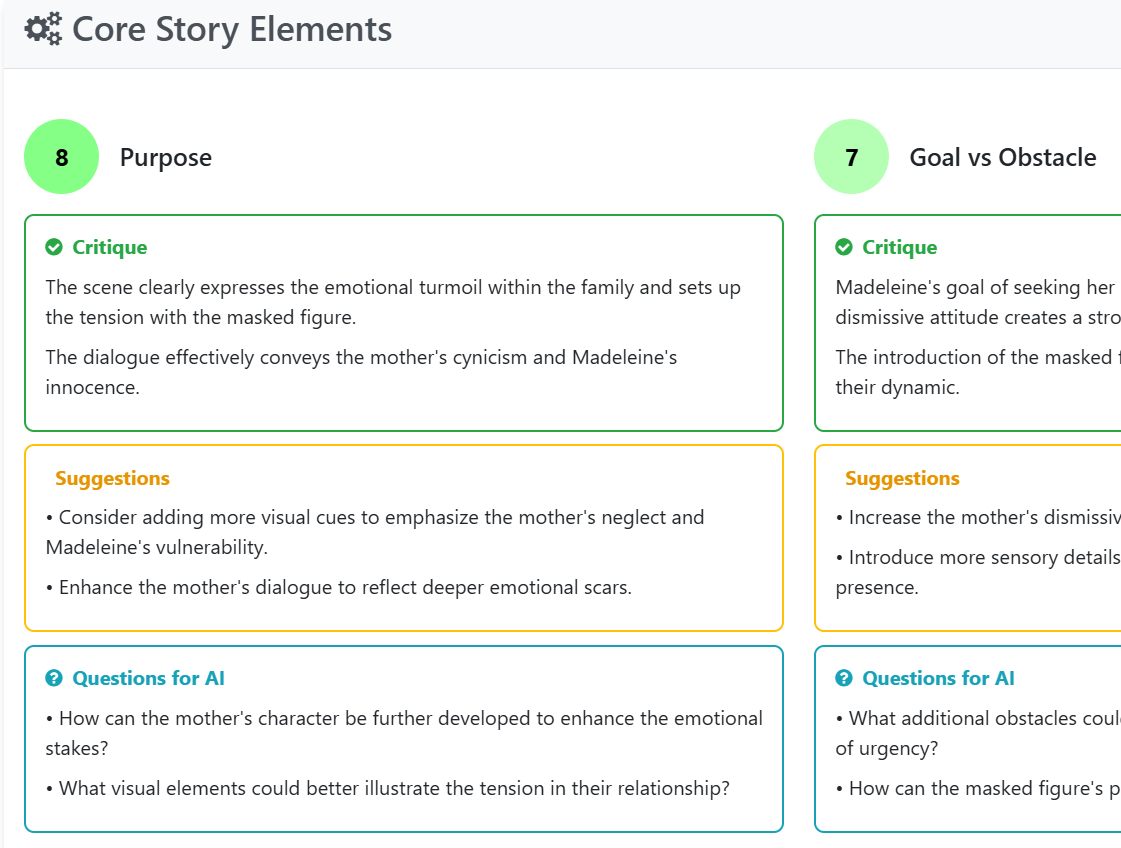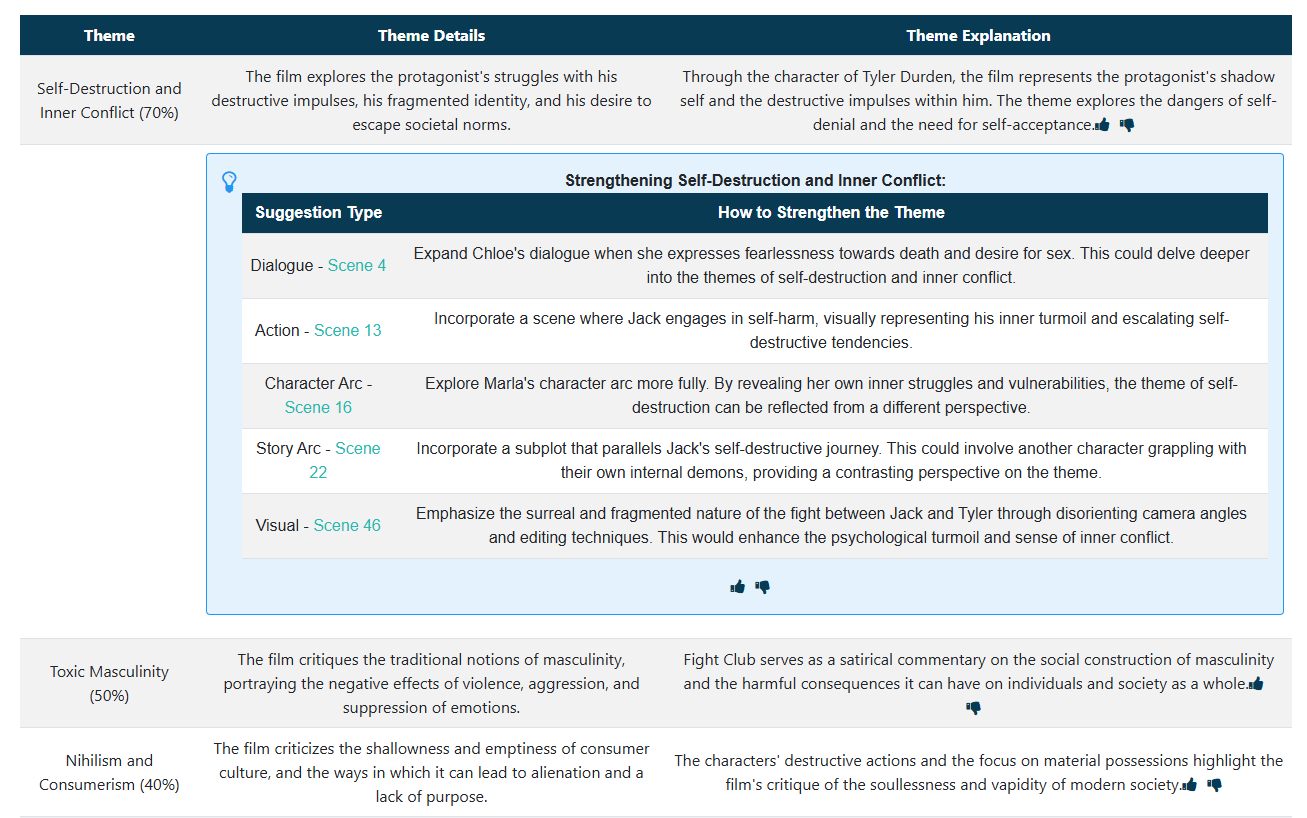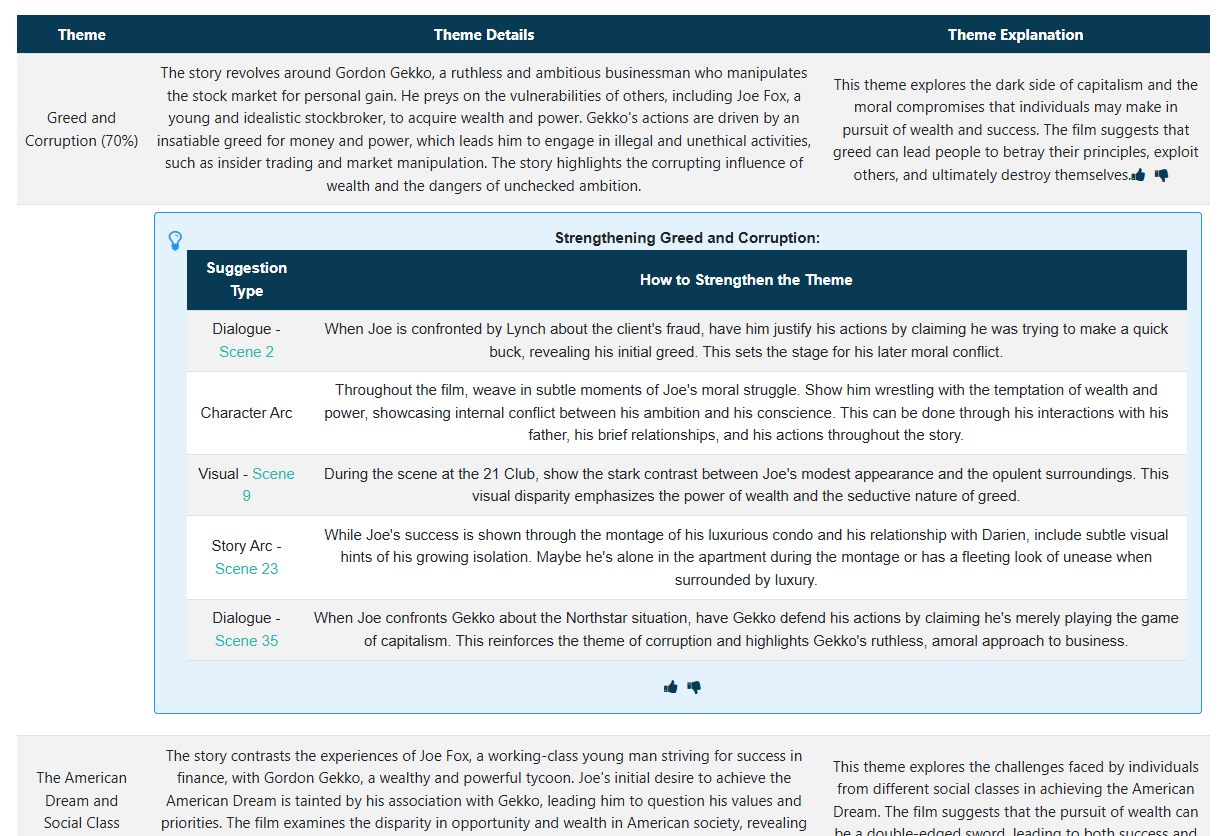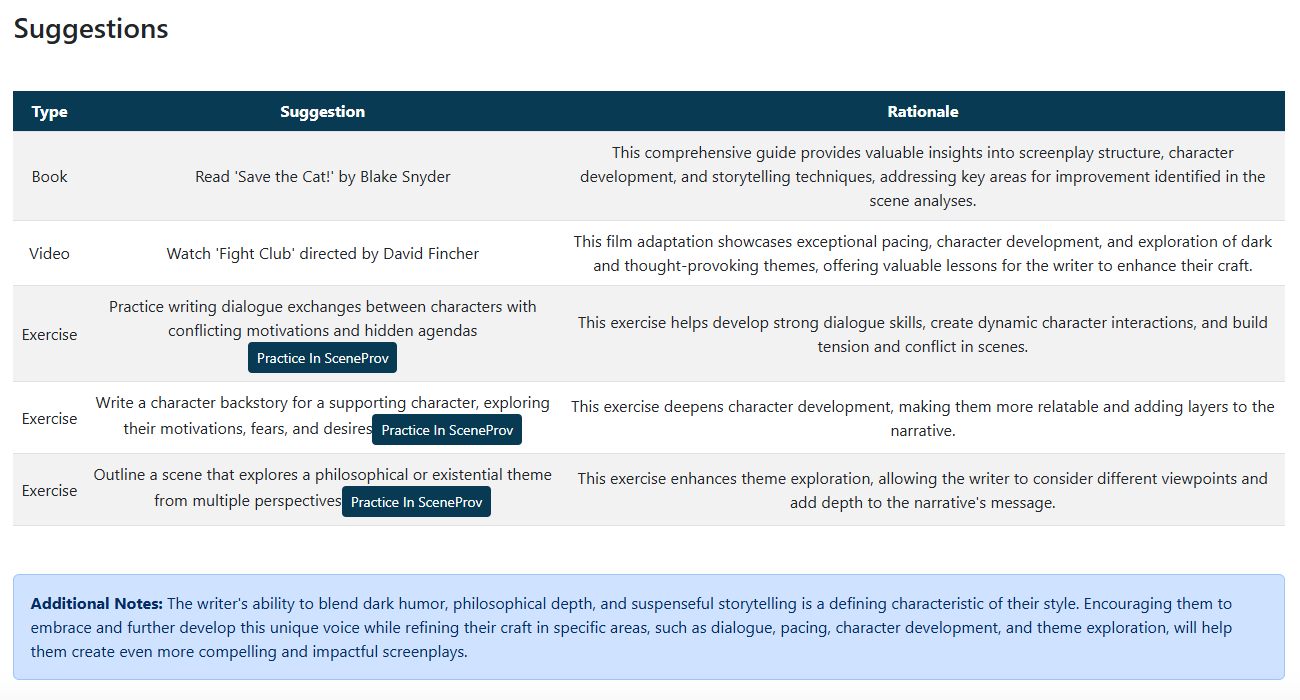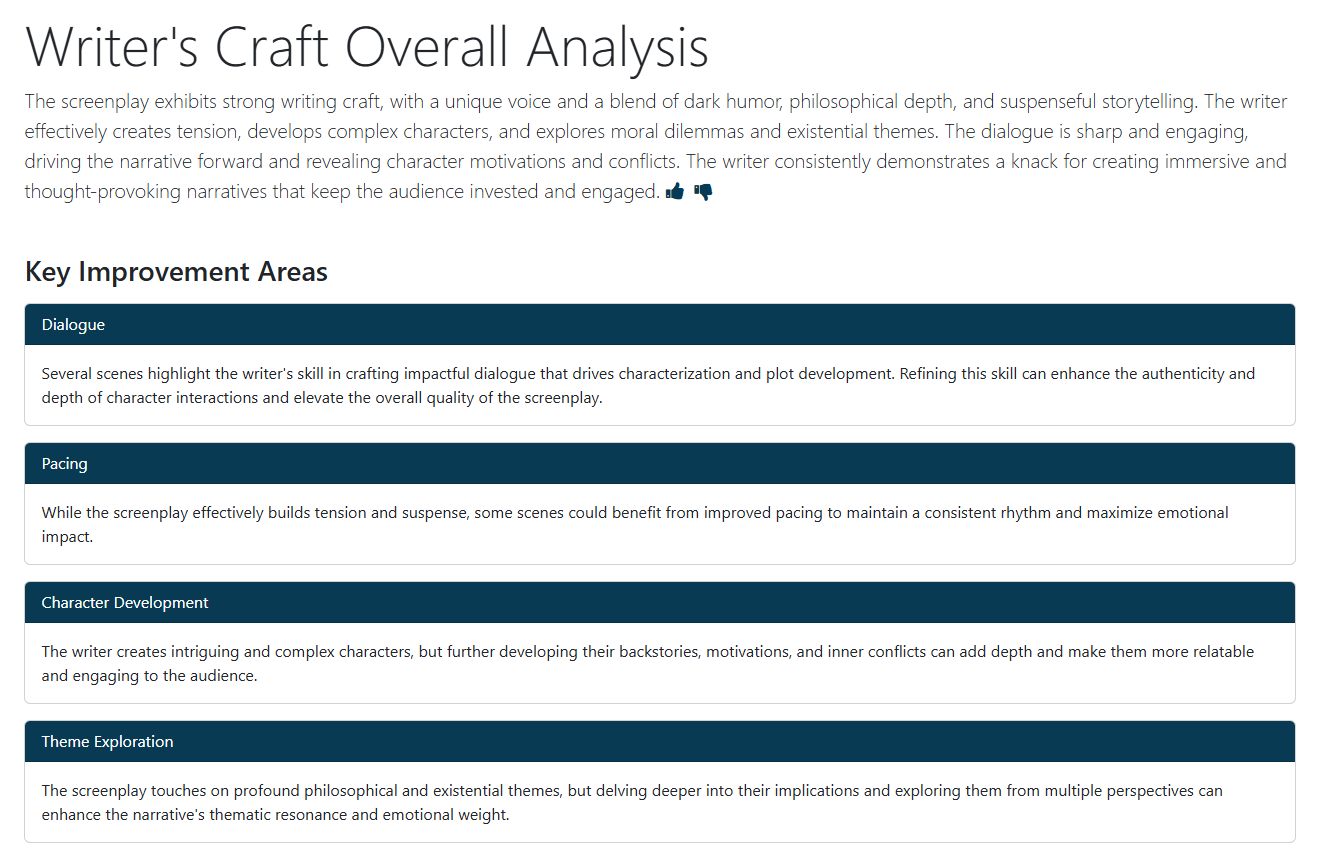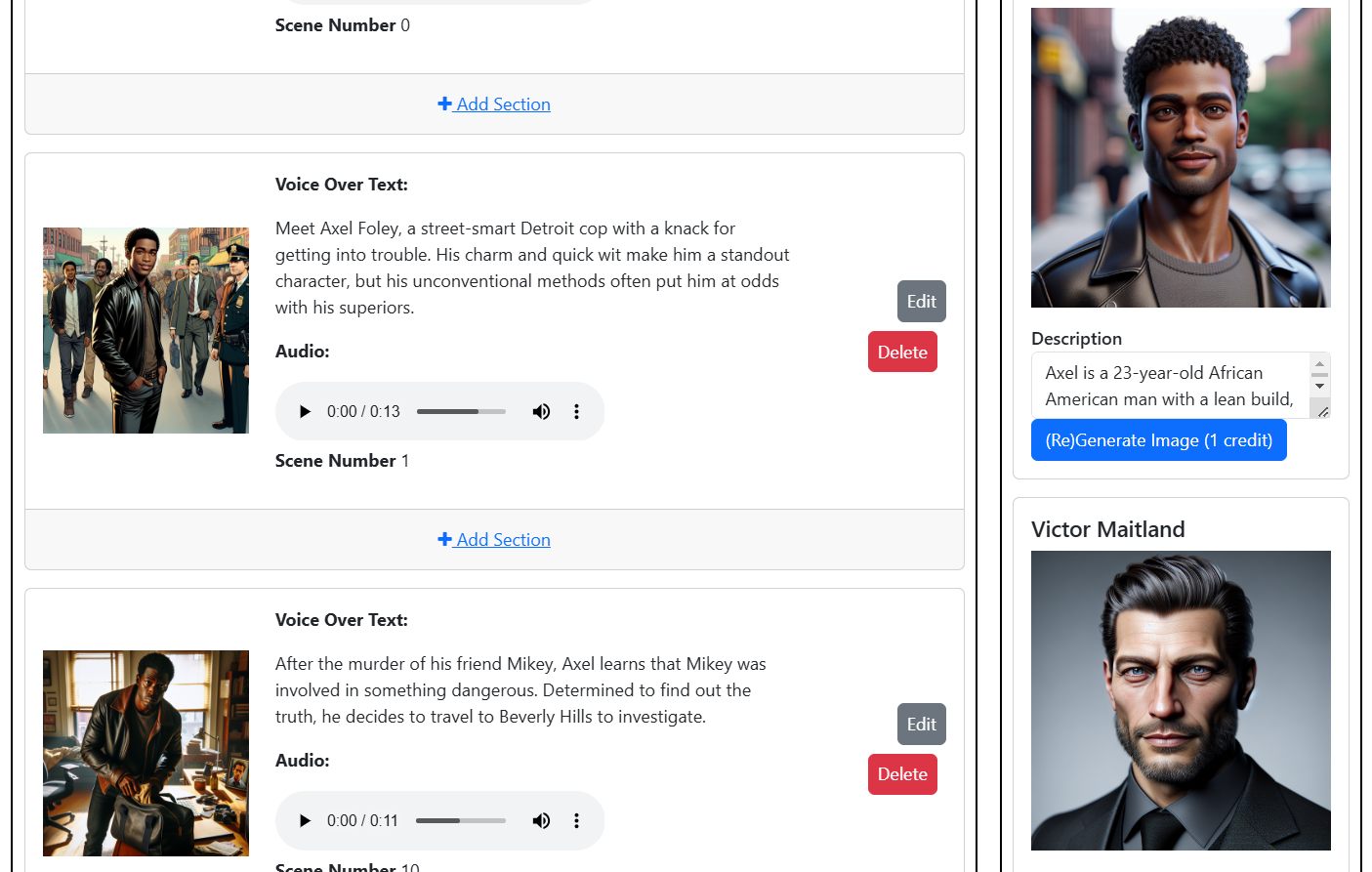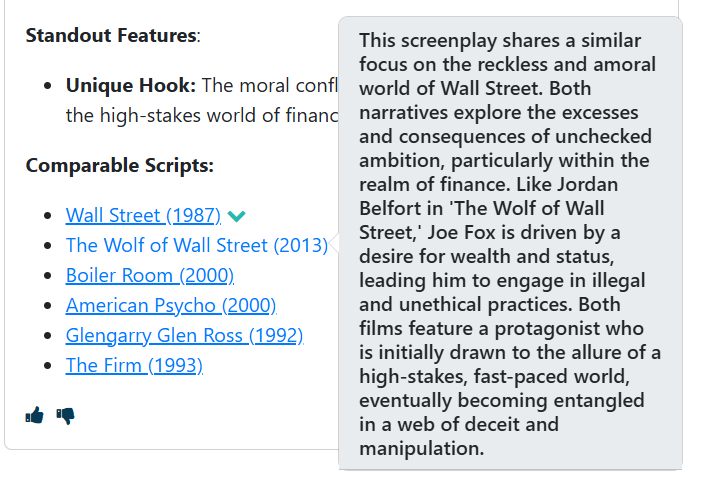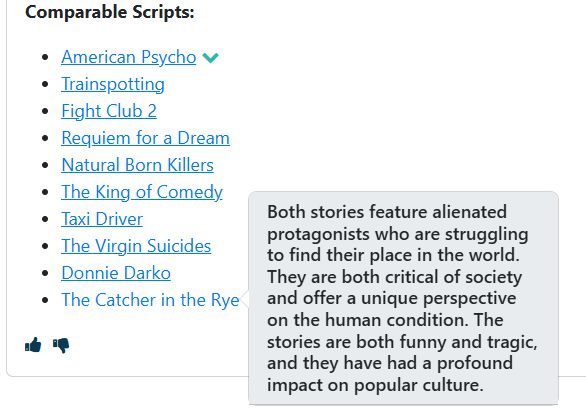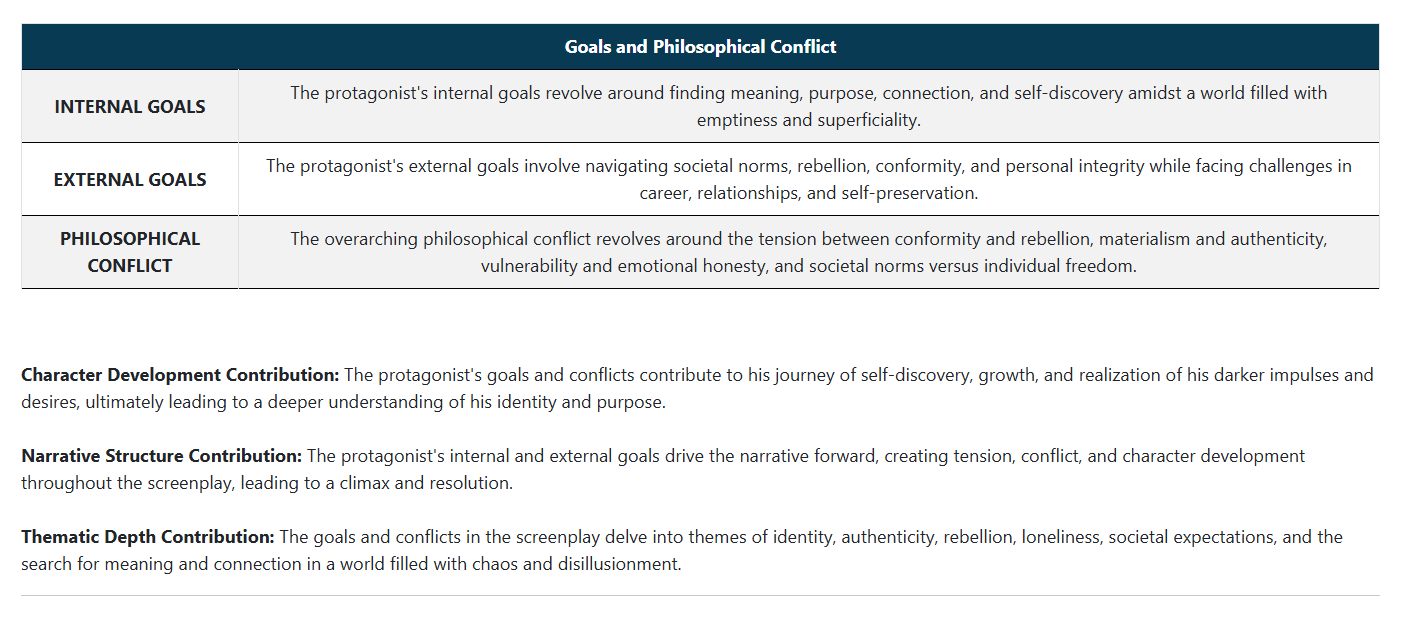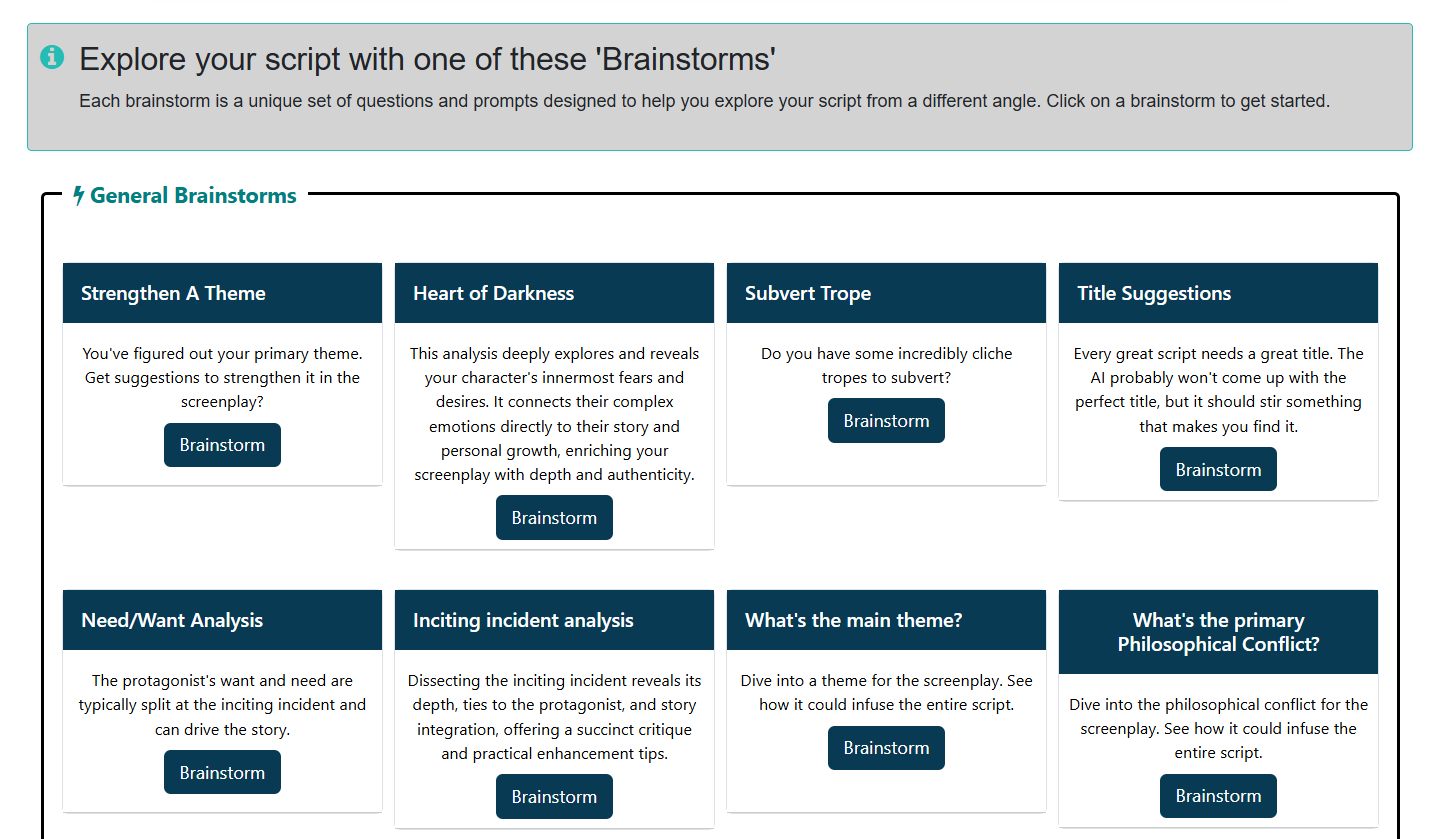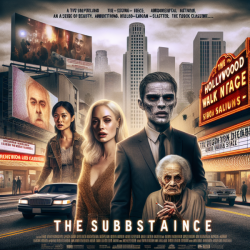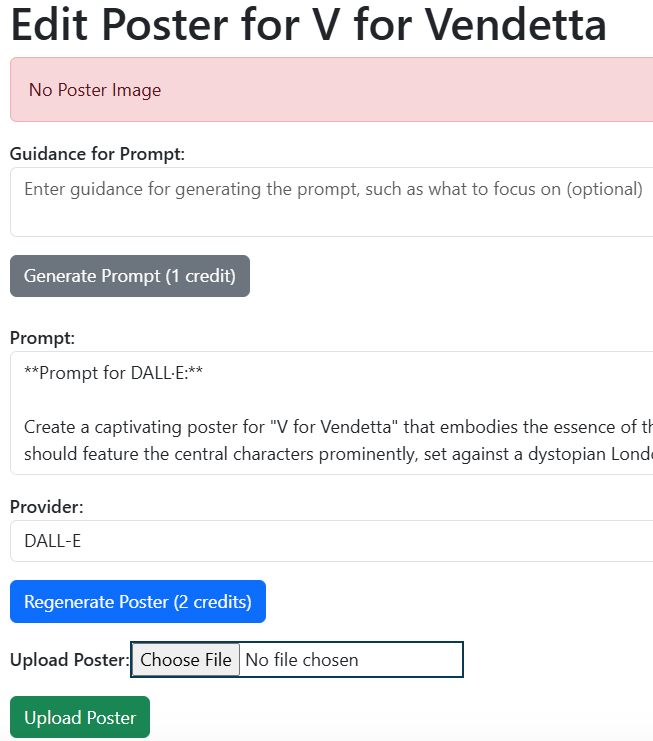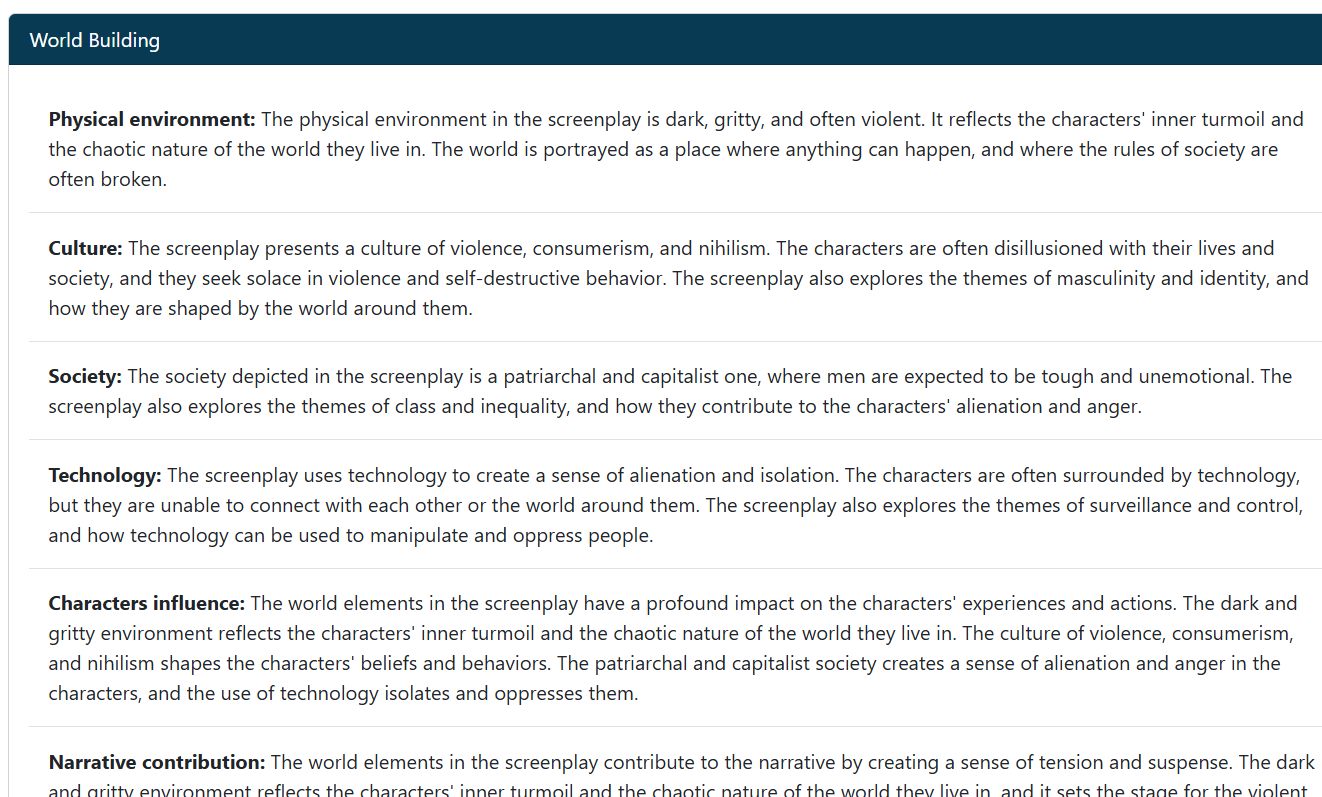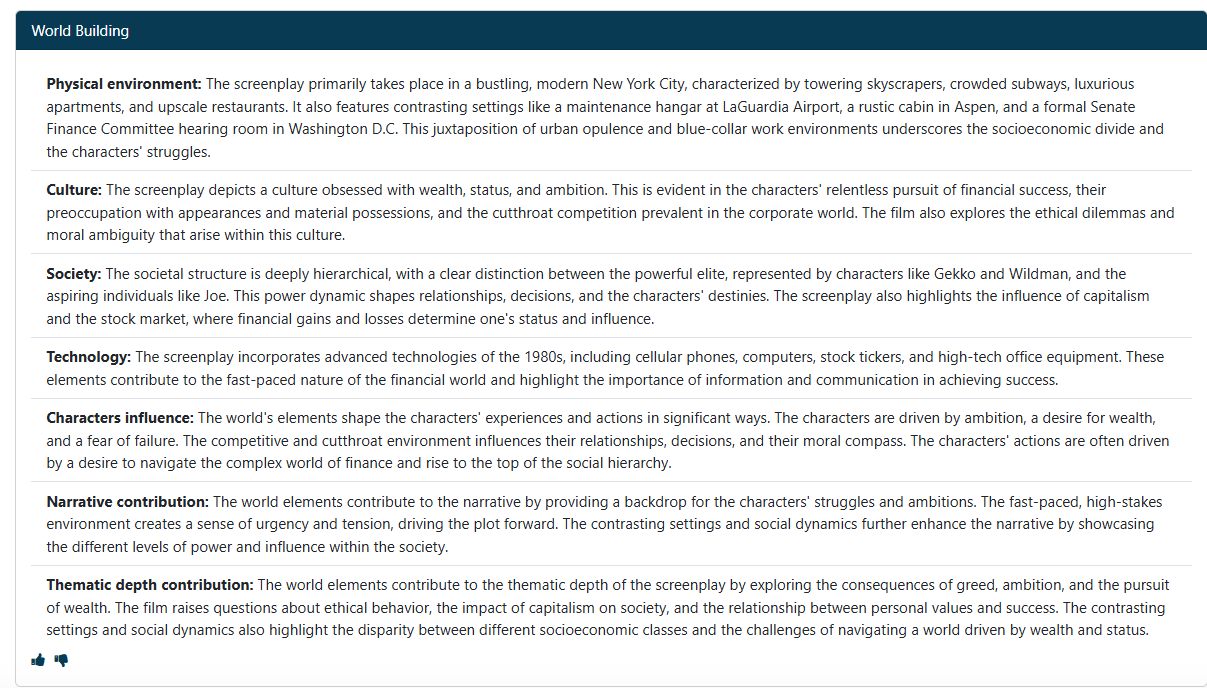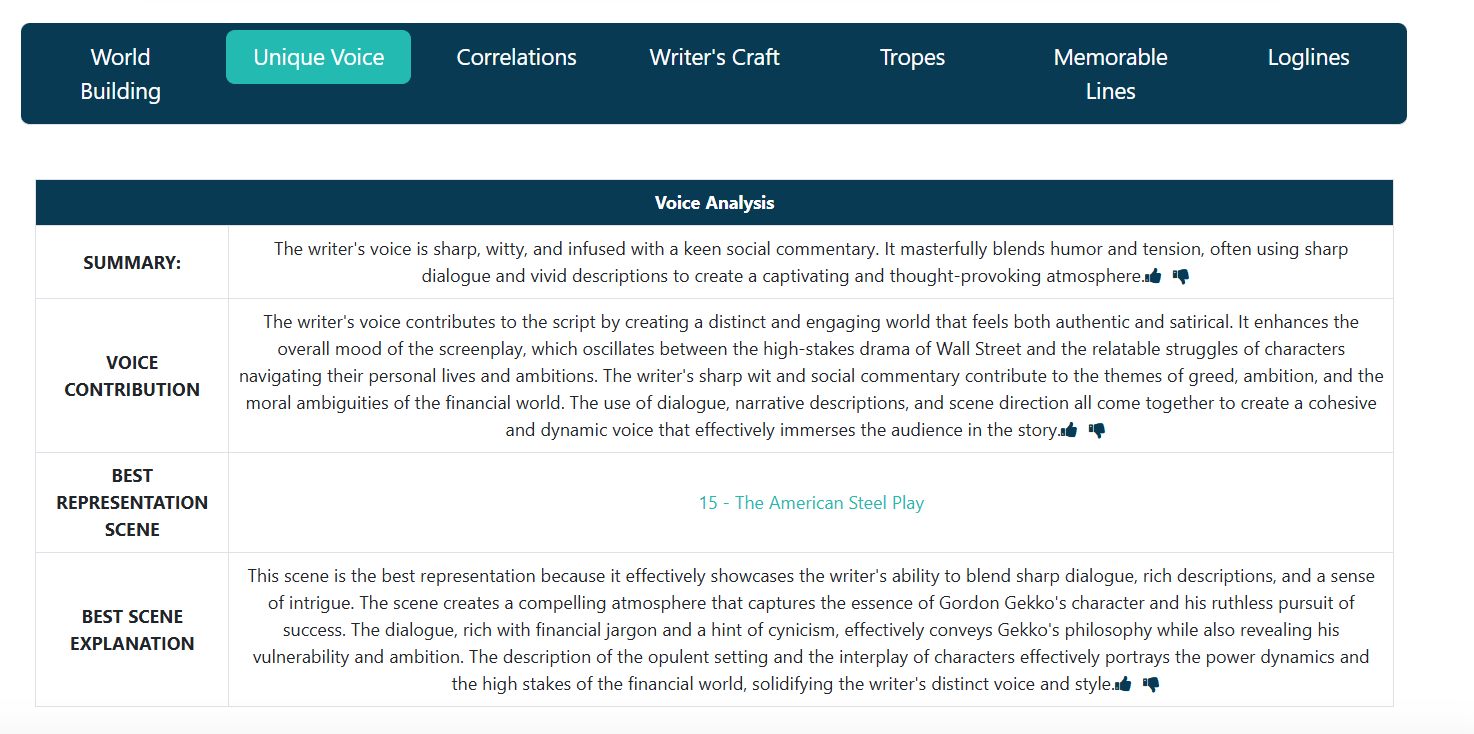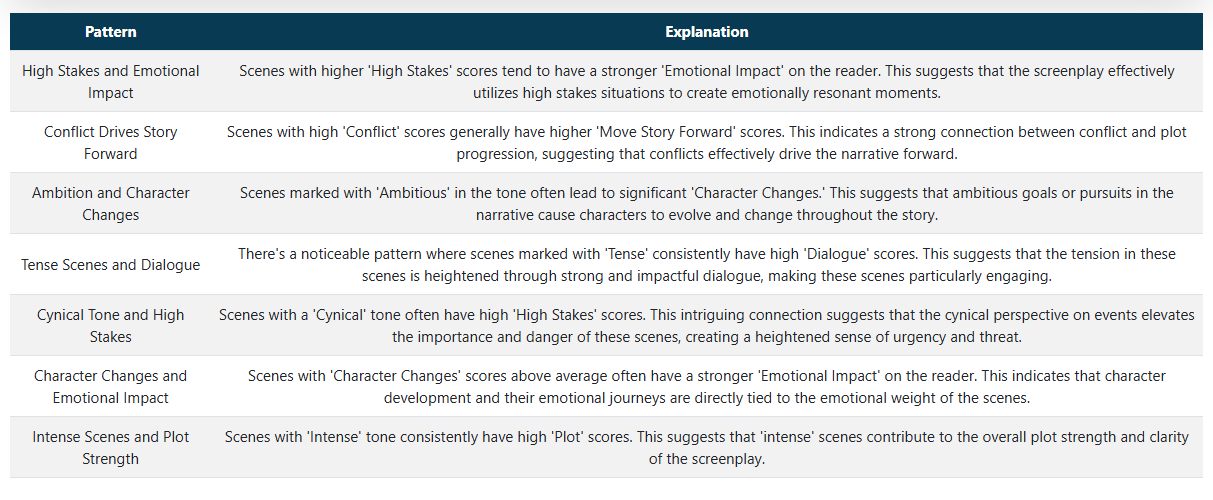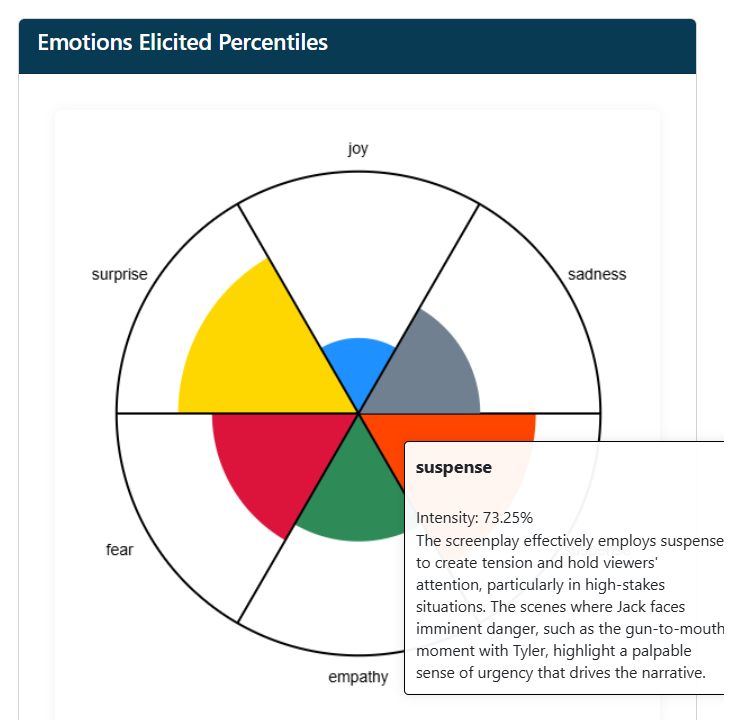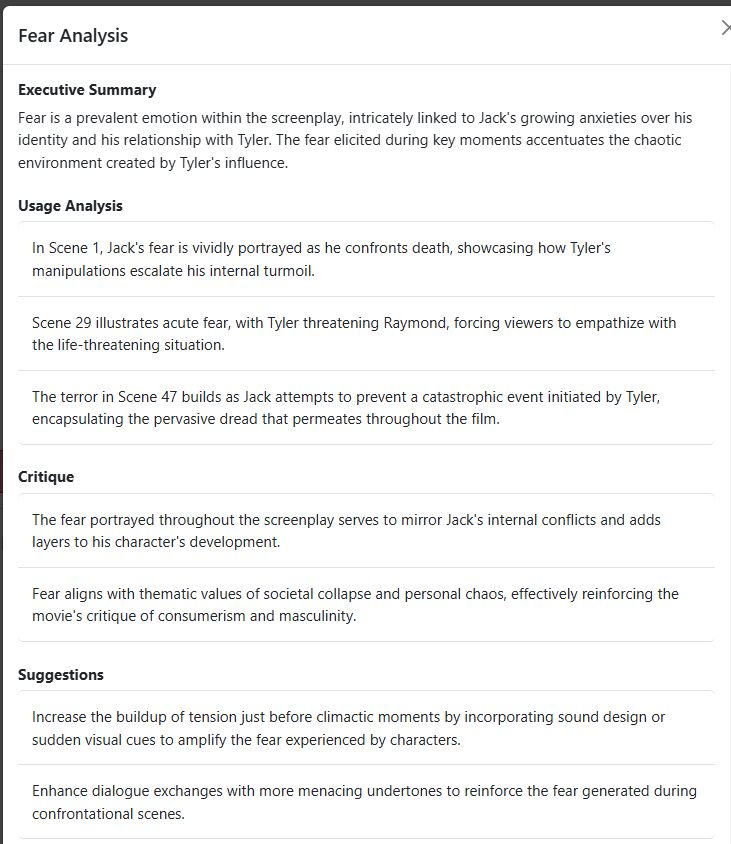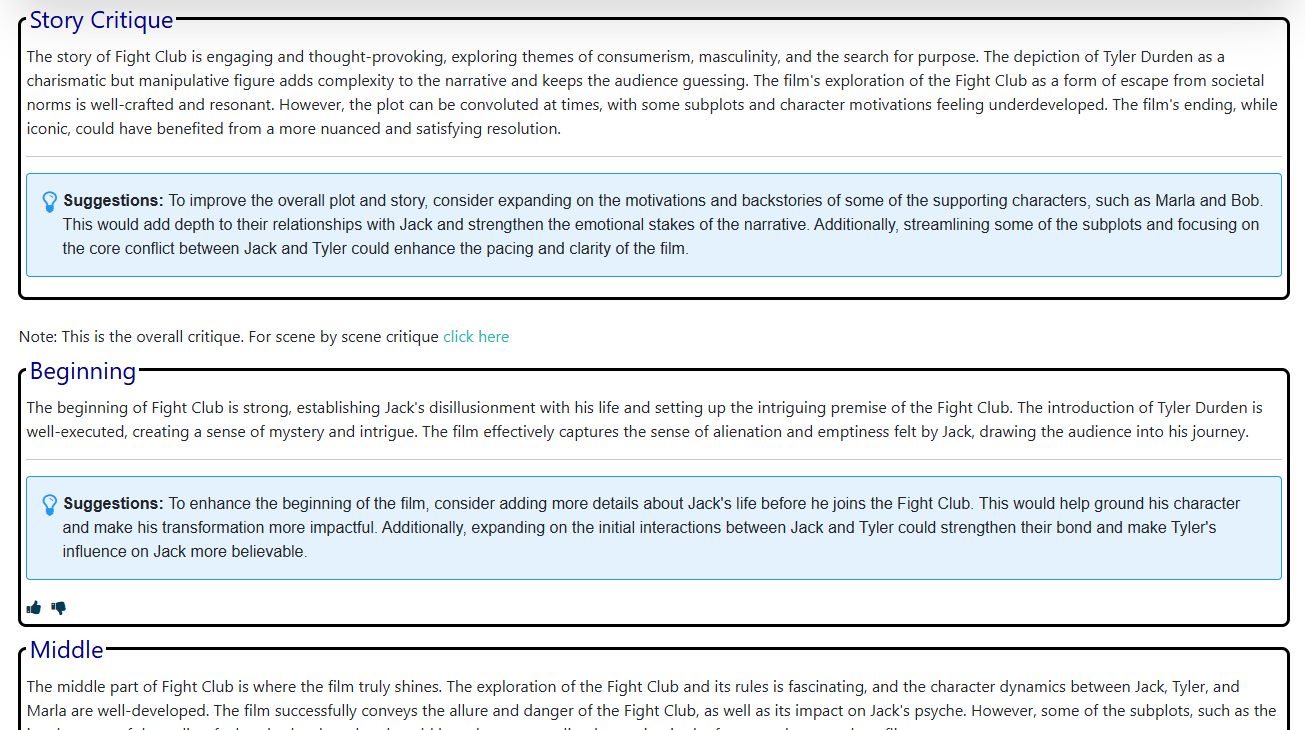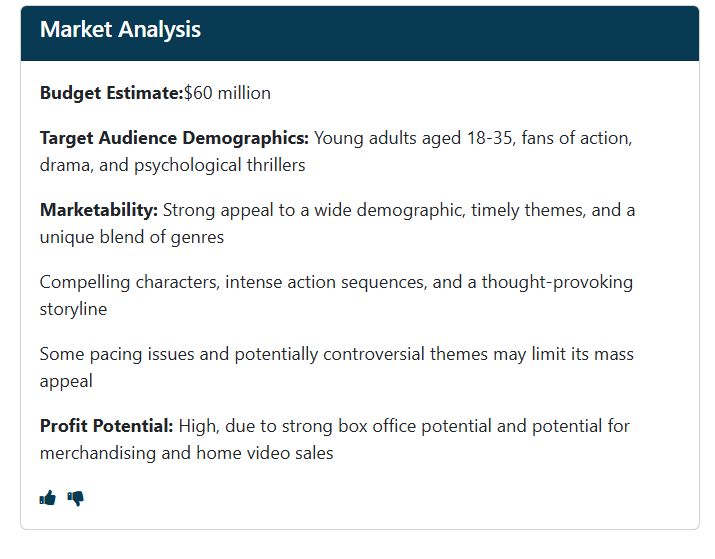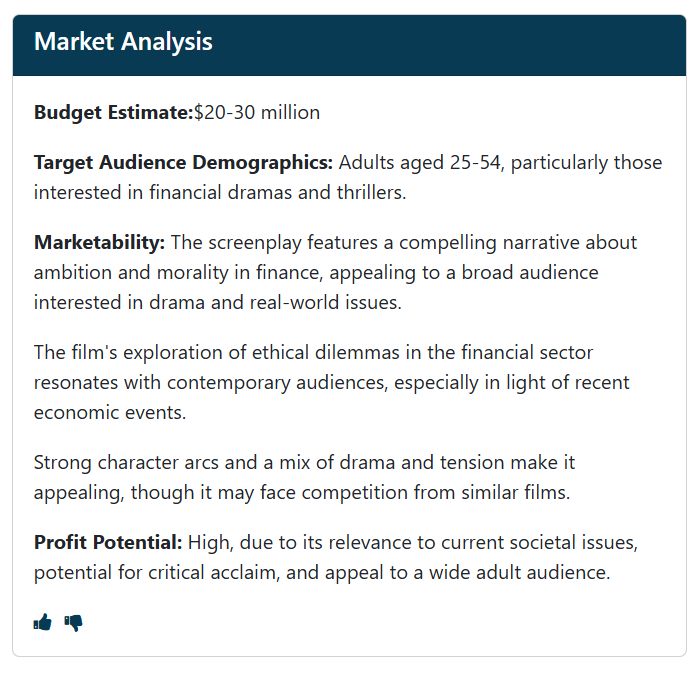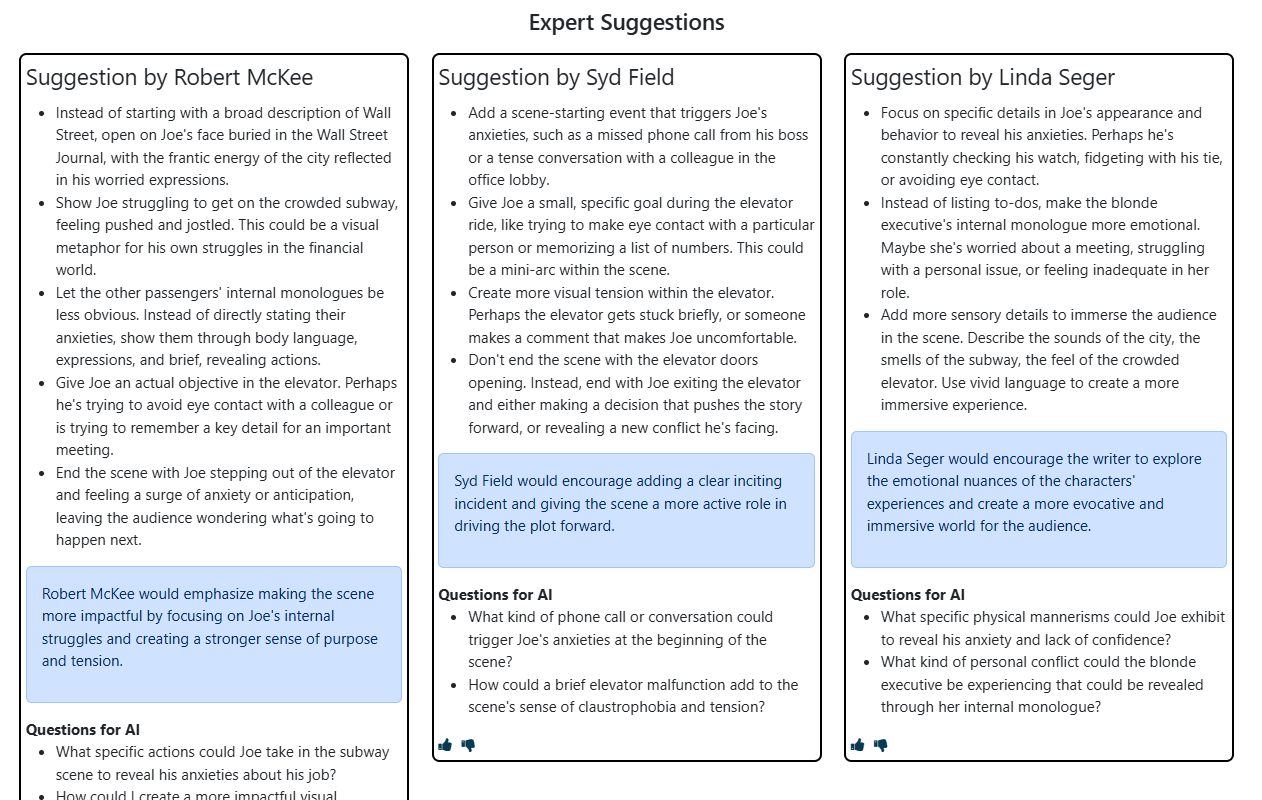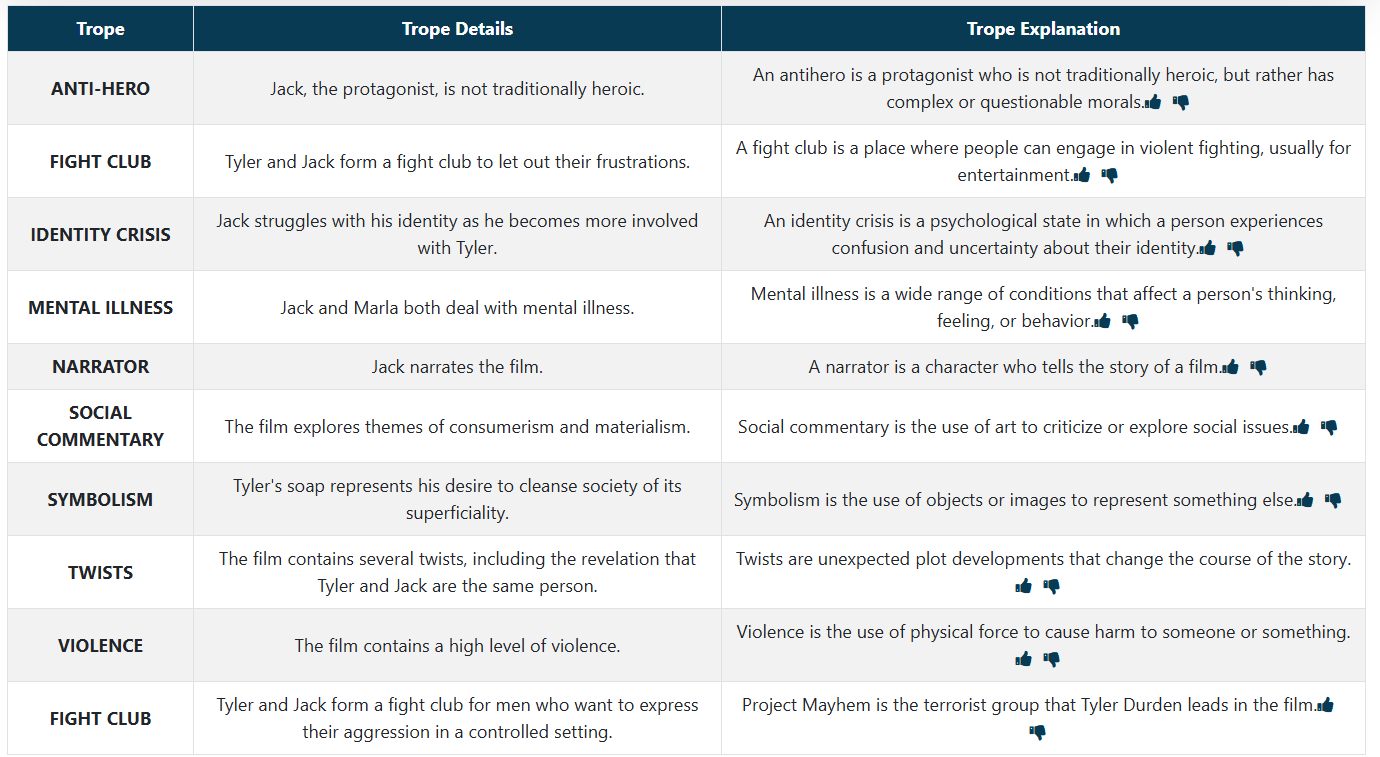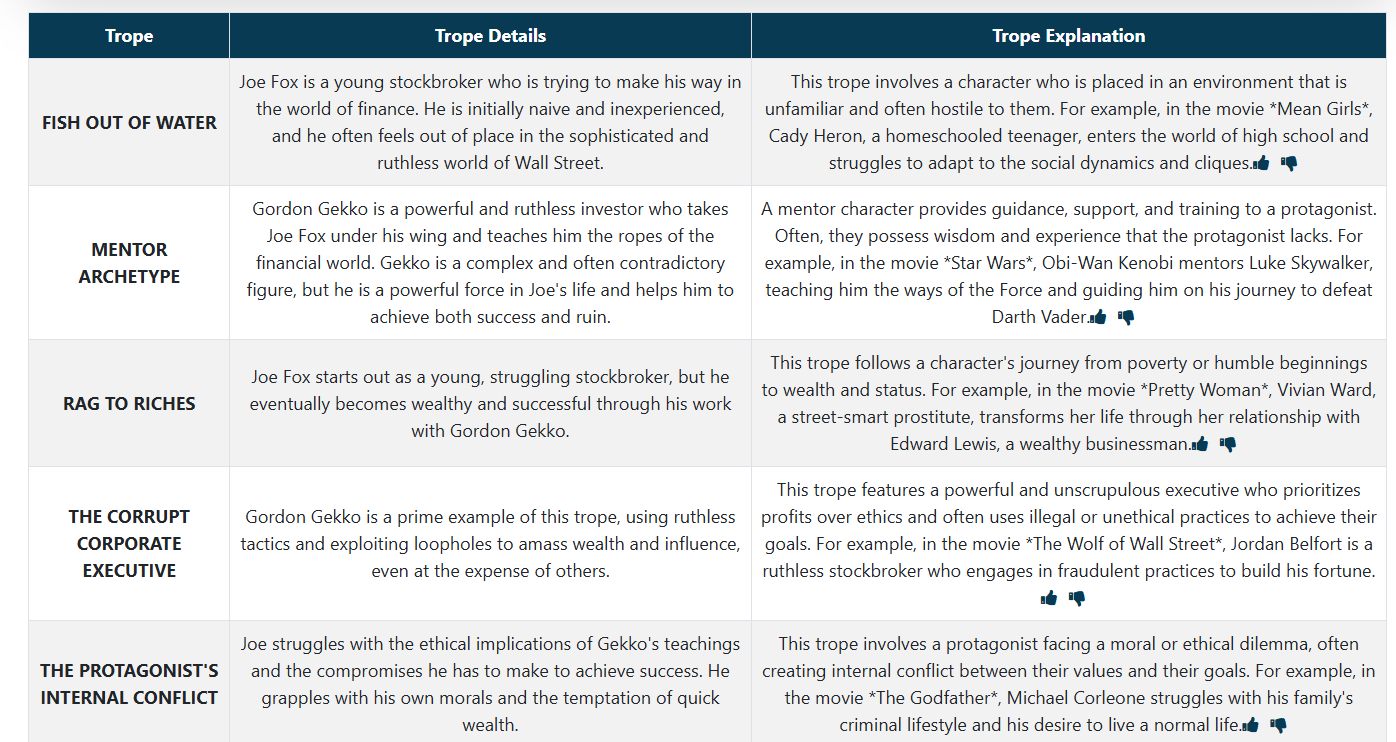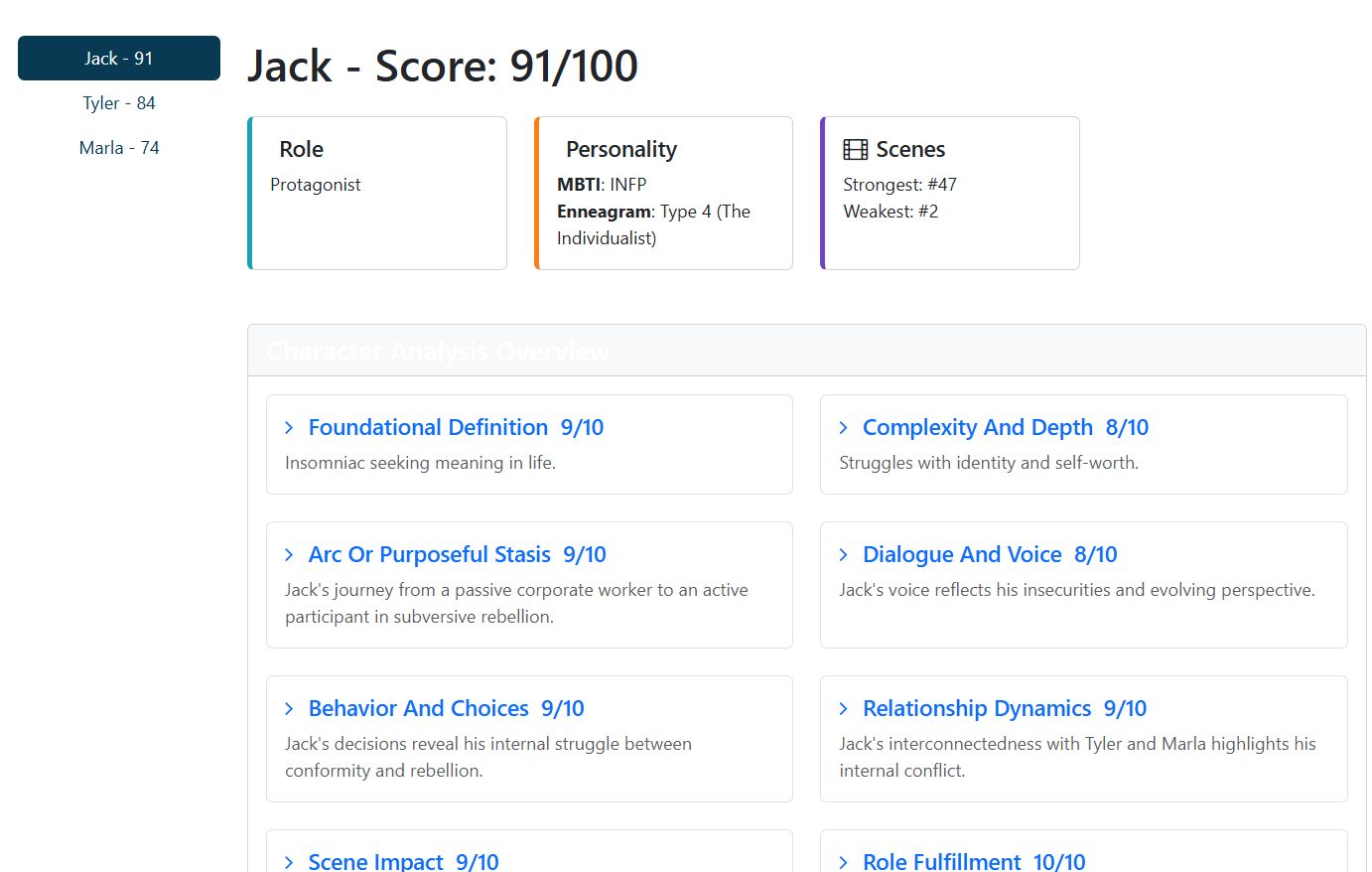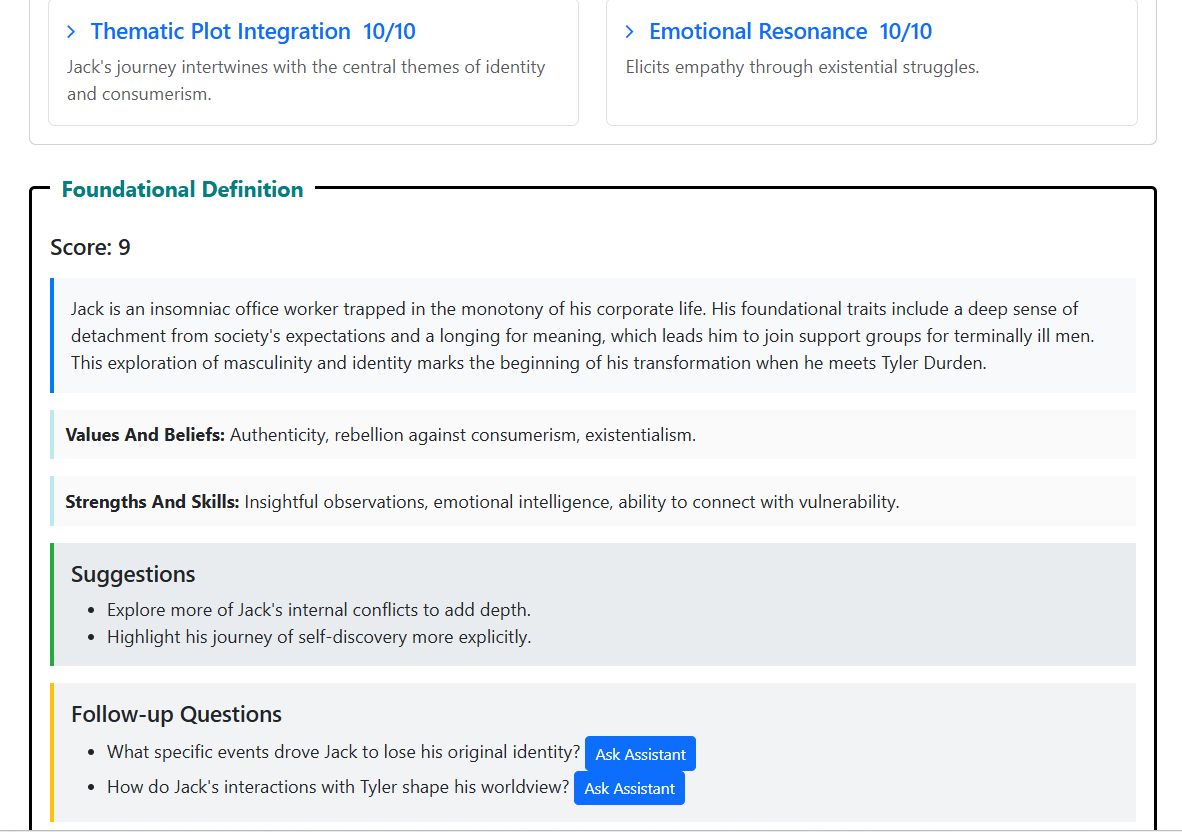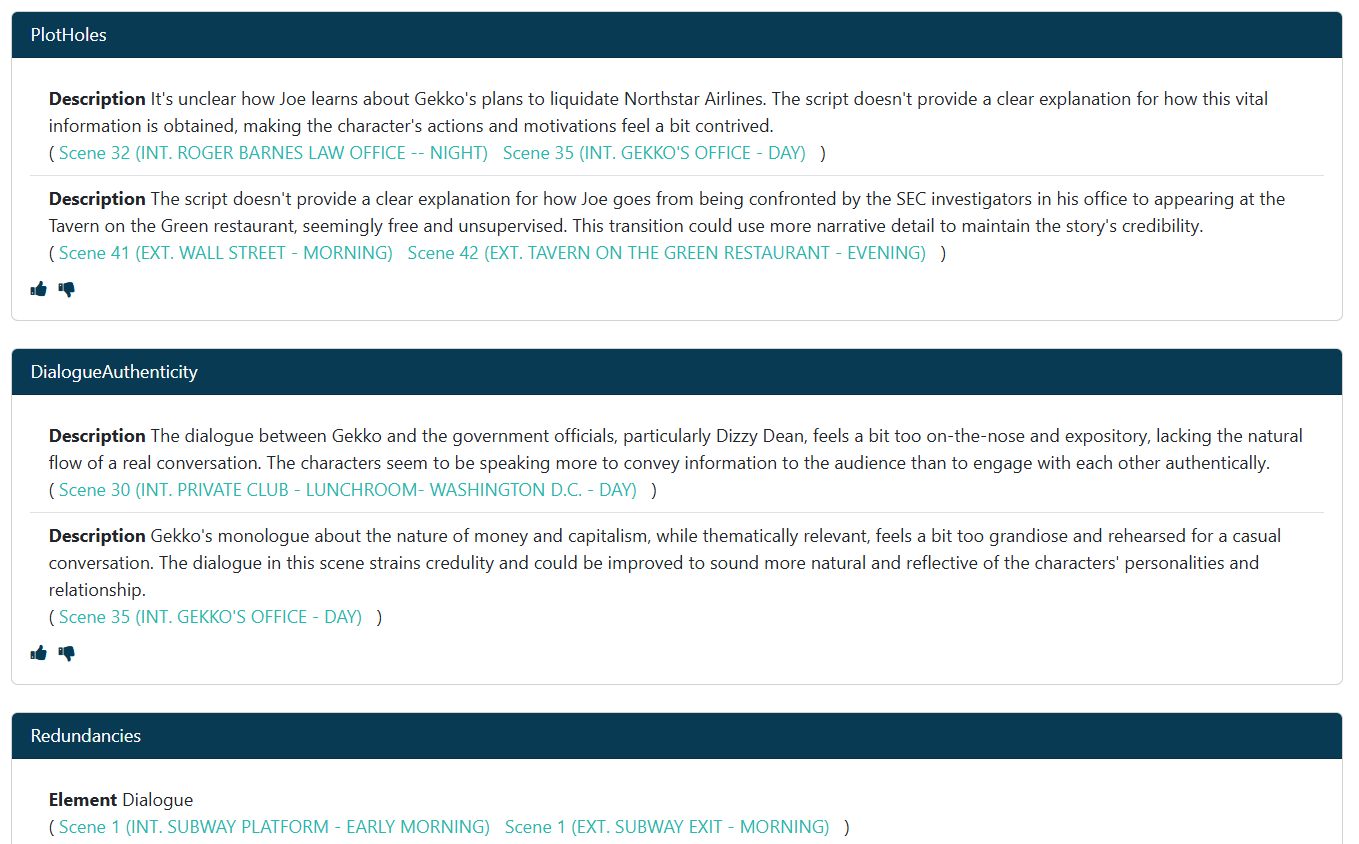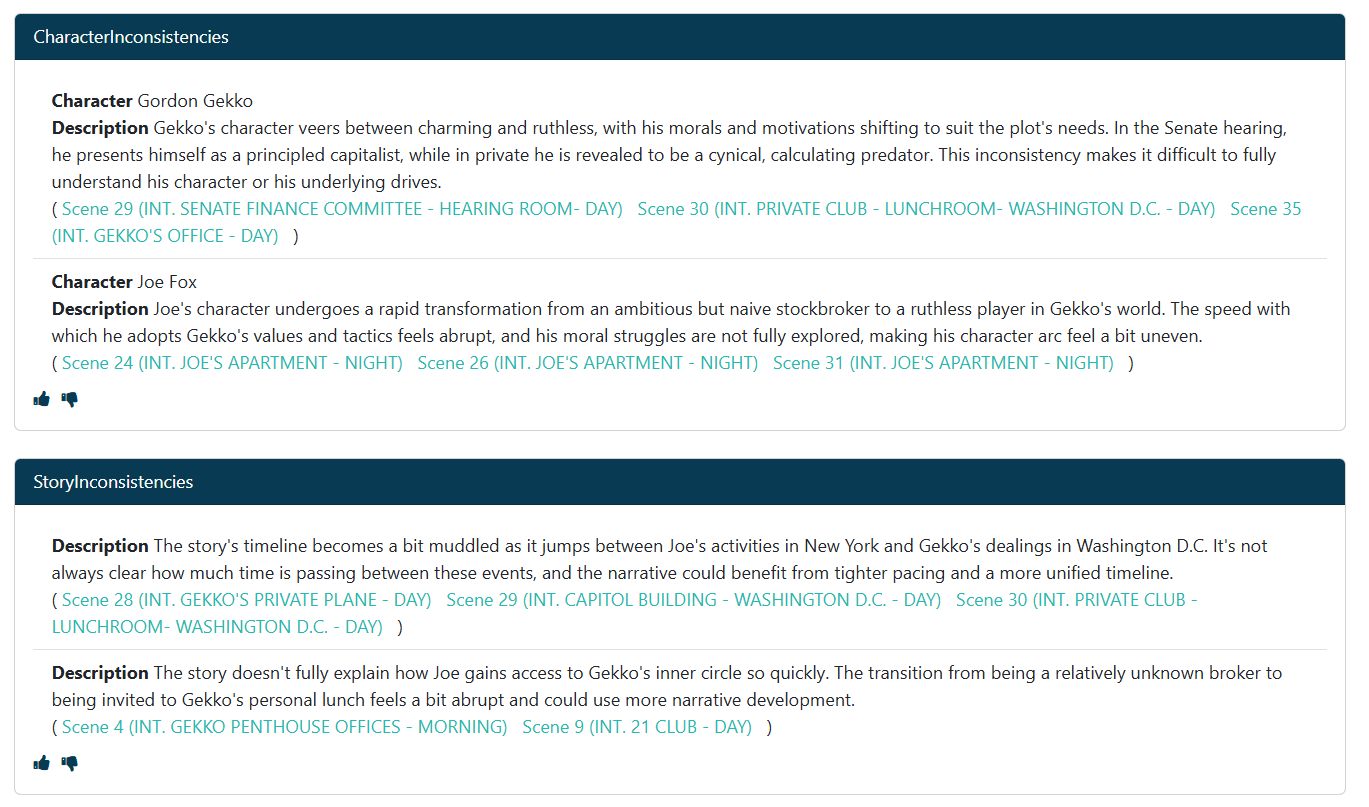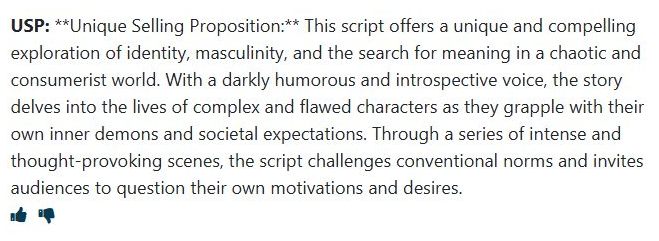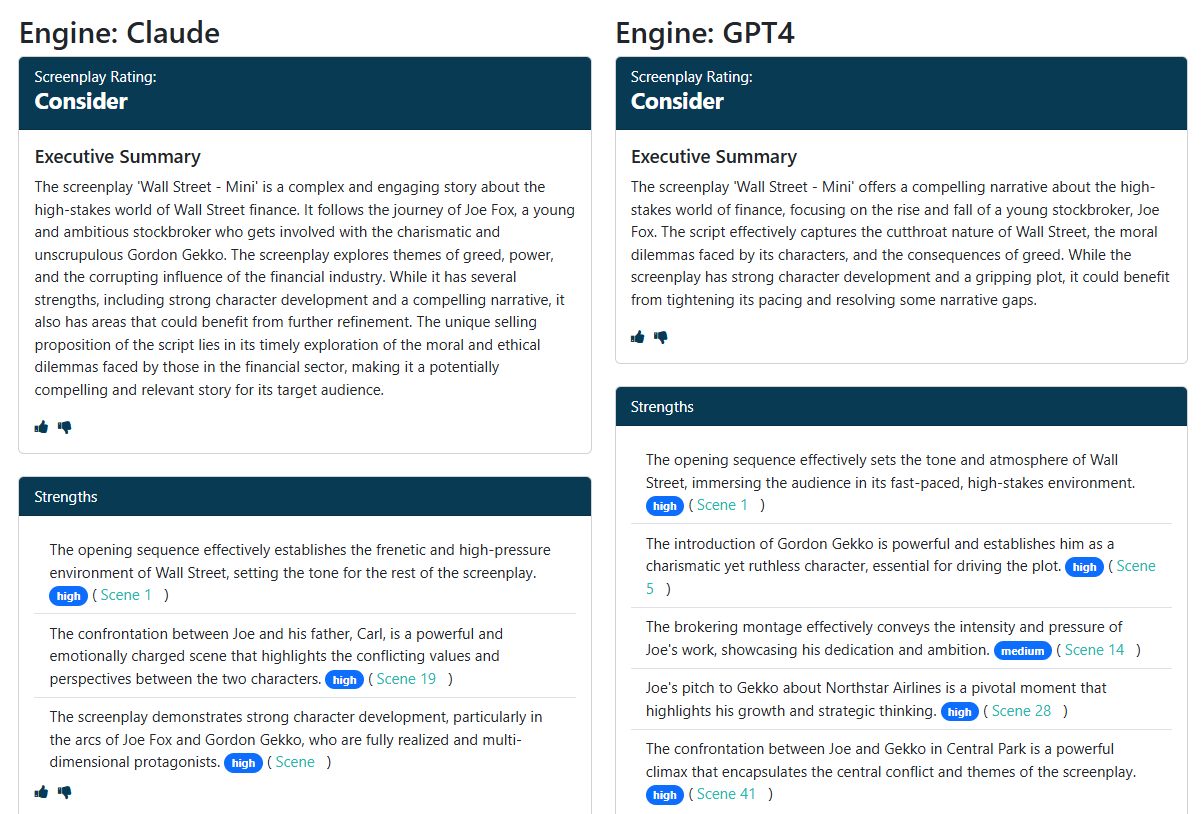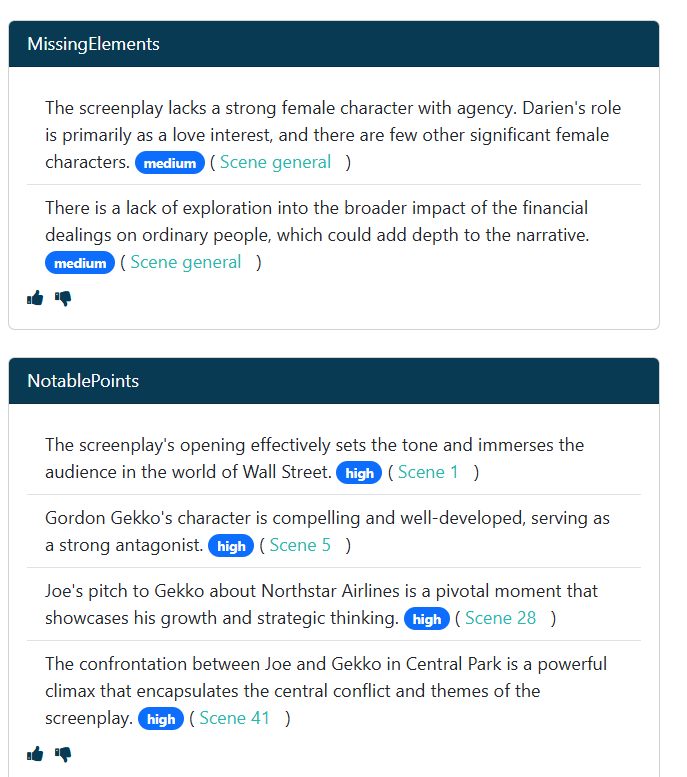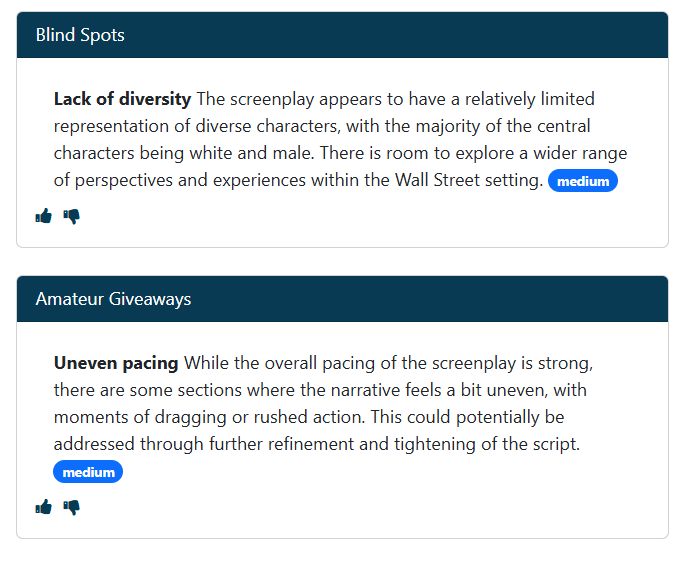View Analysis
View Script
Lake and Mountains. CAMERA TRACKS FORWARD past island in
lake.
DISSOLVE TO:
EXT. ROAD - DAY - L.S.
High Angle V.W. Car moving along road - CAMERA TILTS UP with
it.
CUT TO:
EXT. COLORADO MOUNTAINS & ROAD - DAY - L.S.
Mountains and Road - V.W. Car moves away along road - CAMERA
TRACKS after it.
CUT TO:
L.S. V.W. Car moving away along road - CAMERA TRACKS after
it and passes car - TRACKING FORWARD to Mountains in b.g.
CUT TO:
M.L.S. High Angle V.W. Car moves away along road - CAMERA
TILTS UP with it. Car goes into tunnel and comes out other
side. CAMERA TRACKS after car.
CUT TO:
L.S. V.W. Car moves along road. CAMERA TRACKS after it.
Mountains in b.g.
CUT TO:
L.S. High Angle V.W. Car moving away along road. Mountain
in b.g. CAMERA TRACKS after car.
CUT TO:
L.S. Mountain - CAMERA TRACKS IN on Hotel.
CUT TO:
Black Frames.
THE INTERVIEW.
CUT TO:
INT. OVERLOOK HOTEL/LOBBY - DAY - M.L.S.
Jack walks L-R across Lobby. CAMERA TRACKS BACK & PANS with
him to RECEPTIONIST behind desk.
JACK
Hi, I've got an appointment with Mr.
Ullman. My name is Jack Torrance.
RECEPTIONIST
His office is the first door on the
left.
JACK
Thank you.
JACK moves away R-L. CAMERA PANS with him and TRACKS IN
after him through Secretary's office to open door of ULLMAN's
office - revealing ULLMAN seated at desk with SECRETARY
standing beside him.
JACK
Mr. Ullman?
ULLMAN
Yes?
JACK
I'm Jack Torrance.
ULLMAN
Oh, well - come on in Jack.
ULLMAN stands up and hands book to SECRETARY, walking round
side of desk. JACK moves into office. CAMERA TRACKS IN
after him. He shakes hands with ULLMAN.
ULLMAN
Very nice to meet you.
JACK
Nice to meet you, Mr. Ullman.
ULLMAN points to SECRETARY.
ULLMAN
This is my secretary, Susie.
SECRETARY
Hallo.
JACK
Susie, how do you do?
ULLMAN
Have any trouble finding us?
JACK
Oh, no problem at all. I made the
trip in three and a half hours.
ULLMAN
Well, that's very good time, very
good. Please sit down a minute.
ULLMAN points to chair cam.R. JACK sits cam.R.f.g. ULLMAN
walks behind desk.
ULLMAN
JAck, just make yourself at home.
Would you like some coffee?
JACK
Well, if you are going to have
some, I wouldn't mind. Thanks.
ULLMAN
Susie.
SECRETARY
Sure.
ULLMAN
Oh, and would you ask Bill Watson
to join us?
SECRETARY
Yes, I will.
ULLMAN sits behind desk. SUSIE walks forward to R.f.g.
DISSOLVE TO:
Tone: Formal, Professional, Polite
Ratings
The #1 Rule of Screenwriting: Make your reader or audience compelled to keep reading.
“Grab ‘em by the throat and never let ‘em go.”
The scene level score is the impact on the reader or audience to continue reading.
The Script score is how compelled they are to keep reading based on the rest of the script so far.
This scene serves as an introduction to Jack Torrance and sets the stage for his role at the Overlook Hotel. While it establishes a sense of place and introduces key characters, it lacks immediate tension or conflict that would compel the reader to jump to the next scene. The dialogue is polite and functional, and the scene ends without any cliffhangers or open questions, making it feel somewhat self-contained. However, the mention of Jack's appointment hints at future developments, which may intrigue the reader to continue.
Overall, the script so far has established a foundation for the story, introducing key characters and the setting of the Overlook Hotel. However, the pacing is slow, and while there are hints of future conflict, such as Jack's new job and the ominous history of the hotel, these elements have not yet developed into a compelling narrative drive. The reader may feel a moderate interest in continuing, but the lack of urgency or suspense in the early scenes could lead to waning engagement if not addressed soon.
Expert Critiques
Expert Suggestions
View Analysis
View Script
Apartment Building - cars parked in front of it. Mountain
in b.g. CAMERA TRACKS IN on Apartment Building.
CUT TO:
INT. JACK & WENDY'S APARTMENT IN BOULDER (USA) / LIVING
ROOM - DAY - M.L.S.
DANNY is sitting at table eating a sandwich. WENDY sitting
cam.R reading book.
DANNY
Mom...
WENDY
Yeah.
DANNY
Do you really want to go and live
in that hotel for the winter?
WENDY
Sure, Danny, it will be lots of fun.
DANNY
Yeah, I guess so. Anyway, there's
hardly anybody to play with around
here.
WENDY
Yeah, I know. It always takes a
little time to make new friends.
CUT TO:
M.S. DANNY eating sandwich.
DANNY
Yeah, I guess so.
CUT TO:
M.S. WENDY
WENDY
What about Tony? He's looking
forward to the hotel, I bet.
CUT TO:
M.S. DANNY while eating sandwich wiggles forefinger of his
L.hand and speaks with different voice.
TONY
NO, I ain't Mrs. Torrance.
CUT TO:
M.S. WENDY
WENDY
Oh come on, Tony. Don't be silly.
CUT TO:
M.S. DANNY wiggles forefinger of L.hand and speaks with
different voice.
TONY
I don't want to go there, Mrs.
Torrance.
CUT TO:
M.S. WENDY
WENDY
Well, how come you don't want to go?
CUT TO:
M.S. DANNY wiggles forefinger of L.hand and speaks with
different voice.
TONY
I just don't.
CUT TO:
M.S. WENDY.
WENDY
Well, let's just wait and see.
We're all gonna have a real good
time.
DISSOLVE TO:
Tone: Anxious, Concerned, Curious
Ratings
The #1 Rule of Screenwriting: Make your reader or audience compelled to keep reading.
“Grab ‘em by the throat and never let ‘em go.”
The scene level score is the impact on the reader or audience to continue reading.
The Script score is how compelled they are to keep reading based on the rest of the script so far.
This scene introduces a pivotal moment in the story, as it explores Danny's concerns about moving to the hotel and his interaction with his imaginary friend, Tony. The dialogue between Danny and Wendy establishes a sense of unease, particularly with Tony's reluctance to go to the hotel, hinting at potential underlying issues. While the scene is engaging and provides character development, it feels somewhat self-contained, lacking a strong cliffhanger or immediate suspense that would compel the reader to jump to the next scene. However, the introduction of Danny's imaginary friend and his apprehensions does create a subtle tension that encourages curiosity about what lies ahead.
Overall, the screenplay maintains a steady momentum, with the introduction of Danny's imaginary friend and the family's impending move to the hotel creating a sense of intrigue. The earlier scenes have established Jack's new role at the Overlook Hotel, and the tension surrounding Danny's fears adds depth to the narrative. While some plot threads are still developing, the focus on family dynamics and the psychological elements at play keeps the reader engaged. However, as the story progresses, it will be important to ensure that these threads remain interconnected to maintain reader interest.
Expert Critiques
Expert Suggestions
View Analysis
View Script
JACK over ULLMAN seated at desk. BILL WATSON enter office.
JACK rises and shakes hands with him.
ULLMAN
Bill, I'd like you to meet Jack
Torrance.
WATSON
How do you do?
JACK
Bill, how do you do?
WATSON
Pleased to meet you.
JACK
Pleasure to meet you.
ULLMAN
Grab a chair Bill, and join in.
WATSON & JACK sit down.
ULLMAN
Jack is going to take care of the
Overlook for this winter. I would
like you to take him around the
place as soon as we are through.
WATSON
Fine.
ULLMAN
Jack is a schoolteacher.
CUT TO:
M.C.S. JACK.
JACK
Eh - formerly a school-teacher.
WATSON (OFF)
What line of work are you in now?
JACK
I'm a writer um... Teaching has
been more or less a way of making
ends meet.
CUT TO:
M.C.S. WATSON.
WATSON
Well this ought to be quite a
change for you.
CUT TO:
M.C.S. JACK
JACK
Well, I'm looking for a change.
ULLMAN (OFF)
Our people in Denver recommended
Jack very highly, and, for once, I
agree with them.
CUT TO:
M.S. ULLMAN
ULLMAN
Let's see, where were we? Yes. I
was about to explain that eh... our
season here runs from oh May 15th
to October 30th and then we close
down completely until the following
May.
CUT TO:
M.C.S. JACK
JACK
Do you mind if I ask why you do
that? It seems to me that the
skiing up here would be fantastic.
ULLMAN (OFF)
Oh, it sure would be
CUT TO:
M.S. ULLMAN
ULLMAN (CONT'D)
but the problem is the enormous
cost it would be to keep the road
to the Sidewinder open. It's a...
It's a 25 mile stretch of road -
gets an average of 20 feet of snow
during the winter, and there's just
no way to make it economically
feasible to keep it clear. When
the place was built in 1907, there
was very little interest in winter
sports, and this site was chosen
for its seclusion and scenic beauty.
CUT TO:
M.L.S. ULLMAN over WATSON & JACK.
JACK
Well, it's certainly got plenty of
that.
JACK laughs.
ULLMAN
That's right. And did they give
you any idea in Denver about what
the job entails?
JACK
Only in a very general way.
ULLMAN
Well...
CUT TO:
M.S. ULLMAN
ULLMAN (CONT'D)
...the winters can be fantastically
cruel, and the basic idea is
to...to cope with the very costly
damage and depreciation which can
occur. And this consists mainly of
running the boiler, heating
different parts of the hotel on a
daily rotating basis, repairing
damage as it occurs and doing
repairs, so that the elements can't
get a foothold.
CUT TO:
M.C.S. JACK
JACK
Well, that sounds fine to me.
ULLMAN grunts off.
CUT TO:
M.S. ULLMAN
ULLMAN
Physically, it's not a very
demanding job. The only thing that
can get a bit trying up here during
the winter is eh... the tremendous
sense of isolation.
CUT TO:
M.C.S. JACK
JACK
Well, that just happens to be
exactly what I'm looking for. I'm
eh... I'm outlining a new writing
project, and eh...
(MORE)
JACK (CONT'D)
five months of peace is just what I
want.
CUT TO:
M.S. ULLMAN
ULLMAN
That's very good Jack, because eh...
for some people eh solitude and
isolation...
CUT TO:
M.C.S. JACK.
ULLMAN (OFF) (CONT'D)
can of itself be a problem.
JACK
Not for me.
CUT TO:
M.S. ULLMAN.
ULLMAN
How about your wife and son? How
do you think they'll take to it?
CUT TO:
M.C.S. JACK.
JACK
They'll love it.
ULLMAN (OFF)
Great...
CUT TO:
M.S. ULLMAN
ULLMAN
Well, before I turn you over to
Bill, there is one other thing I
think we should talk about. I
don't want to sound melodramatic,
but it is something that's...
(MORE)
ULLMAN (CONT'D)
been known to give a few people
second thoughts about the job.
CUT TO:
M.C.S. JACK
JACK
I'm intrigued.
CUT TO:
M.S. ULLMAN.
ULLMAN
I don't suppose they eh told you
anything in Denver about the
tragedy we had up here during the
winter of 1970?
CUT TO:
M.C.S. JACK shakes his head.
JACK
I don't believe they did.
CUT TO:
M.S. BILL WATSON.
ULLMAN (OFF)
Well, my predecessor in this job
CUT TO:
M.S. ULLMAN.
ULLMAN (CONT'D)
hired a man named Charles Grady, as
the winter caretaker. He came up
here with his wife and two little
girls of about eight or ten. And
he had a good employment record,
good references and from what I've
been told, I mean, he seemed like a
completely normal individual. But
at some point during the winter, he
must have suffered some kind of a
complete mental breakdown.
(MORE)
ULLMAN (CONT'D)
He ran amok and eh... killed his
family with an axe,
CUT TO:
M.C.S. JACK
ULLMAN (OFF) (CONT'D)
stacked them neatly in one of the
rooms in the West Wing, and then he
um... then he put eh both barrels
of his shotgun in his mouth.
CUT TO:
M.S. ULLMAN sitting behind desk.
ULLMAN (CONT'D)
The police eh... they thought that
it was what the old-timers used to
call cabin-fever, a kind of
claustrophobic reaction which can
occur when people are
CUT TO:
M.C.S. JACK
ULLMAN (OFF) (CONT'D)
shut in together over long periods
of time.
JACK
Well, that is eh quite a story.
CUT TO:
M.S. ULLMAN laughs.
ULLMAN
Yes, it is. Oh, it's still hard
for me to believe that it actually
happened here, but it did and eh...
I think you can appreciate why I
wanted to tell you about it.
CUT TO:
M.C.S. JACK.
JACK
Ah, I certainly can, and eh... I
also understand why your people in
Denver left it for you to tell me.
JACK laughs.
CUT TO:
U.S. ULLMAN laughing.
ULLMAN
Well, obviously some people can be
CUT TO:
M.C.S. JACK.
ULLMAN (OFF) (CONT'D)
put off by the idea of staying
alone in a place where something
like that actually happened.
JACK
Well, you can rest assured Mr.
Ullman, that's not going to happen
with me, and eg as far as my wife
is concerned, I am sure she'll be
absolutely fascinated when I tell
her about it. She's a confirmed
ghost story and horror film addict.
DISSOLVE TO:
Tone: Suspenseful, Foreboding, Informative
Ratings
The #1 Rule of Screenwriting: Make your reader or audience compelled to keep reading.
“Grab ‘em by the throat and never let ‘em go.”
The scene level score is the impact on the reader or audience to continue reading.
The Script score is how compelled they are to keep reading based on the rest of the script so far.
This scene effectively builds tension and intrigue by introducing the dark history of the Overlook Hotel through Ullman's recounting of the previous caretaker's tragic fate. The conversation between Jack and Ullman is engaging, as it not only reveals important background information but also hints at potential psychological conflicts that may arise from isolation. The scene ends with Jack's light-hearted dismissal of the previous tragedy, which creates a contrast that leaves the reader curious about how this history will affect him and his family. The combination of humor and foreboding sets the stage for future developments, compelling the reader to continue.
Overall, the screenplay maintains a strong sense of momentum, with the introduction of Jack's character and his eagerness for the caretaker position juxtaposed against the ominous history of the hotel. The ongoing tension between Jack's desire for solitude and the warnings about isolation creates a compelling narrative thread. Additionally, the interactions between Jack, Wendy, and Danny hint at underlying family dynamics that could be explored further. As the story progresses, the unresolved elements regarding the hotel's past and the psychological implications for Jack and his family keep the reader engaged and eager to see how these threads will unfold.
Expert Critiques
Expert Suggestions
View Analysis
View Script
Shooting through open door - DANNY standing on stool at basin.
DANNY
Tony, do you think Daddy will get
the job?
TONY (OFF)
Yeah, he did. He's gonna phone
Wendy up in a few minutes to tell
her.
CUT TO:
INT. BOULDER KITCHEN/LIVING ROOM - DAY - M.S.
WENDY back to camera washing dishes at sink. PHONE RINGS
OFF. She dries her hand and puts carton in fridge. Then
moves L-R into Living Room - CAMERA PANS with her.
She picks up telephone receiver.
WENDY
(into phone)
Hello.
CUT TO:
INT. HOTEL - LOBBY - DAY - M.L.S.
JACK leaning on counter at reception desk, speaking into
phone.
JACK
(into phone)
Hi, babe.
WENDY
(over phone)
Hi, hon. How's it going?
JACK
(into phone)
Great. Look, I'm at the hotel and
I still have an awful lot to go
through. I don't think I can get
home before nine or ten.
CUT TO:
INT. BOULDER APARTMENT/LIVING ROOM - DAY - M.S.
WENDY sitting on back of chair phone to ear.
WENDY
(into phone)
Sounds like you got the job?
CUT TO:
INT. HOTEL - LOBBY - DAY - M.L.S.
JACK leaning on reception desk with phone to ear.
JACK
(into phone)
Right it's a beautiful place. You
and Danny are gonna love it.
INT. BOULDER APARTMENT/BATHROOM - DAY - M.S.
DANNY standing on stool by basin. He is reflected in mirror.
CAMERA TRACKS IN on his reflection in mirror.
DANNY
Tony, why don't you want to go to
the hotel?
DANNY wiggles forefinger.
TONY (OFF)
I don't know.
DANNY
You do too know, now come on tell me.
DANNY wiggles forefinger.
TONY (OFF)
I don't want to.
DANNY
Please...
DANNY wiggles forefinger.
TONY (OFF)
No.
DANNY
Now Tony, tell me.
CUT TO:
INT. HOTEL - LOBBY - M.L.S.
Shooting towards doors of lifts. Blood gushes in from
L.side of lift and in from corridors L. and R. of lift
doors - surging towards camera.
CUT TO:
INT. HOTEL/CORRIDOR - M.S.
Two Little GRADY girls holding hands.
CUT TO:
INT. HOTEL/LOBBY - M.L.S.
Blood gushing in from corridors L-R of lift doors and
surging towards camera.
CUT TO:
INT. BOULDER APARTMENT - M.C.S.
DANNY screaming.
CUT TO:
INT. HOTEL/LOBBY - M.L.S.
Blood gushing in from corridors L-R of lift doors and
surging forward. The blood gushes up into camera lens
causing black out.
DOCTOR (OFF)
Now hold your eyes still so that I
can see.
CUT TO:
Tone: Suspenseful, Anxious, Mysterious
Ratings
The #1 Rule of Screenwriting: Make your reader or audience compelled to keep reading.
“Grab ‘em by the throat and never let ‘em go.”
The scene level score is the impact on the reader or audience to continue reading.
The Script score is how compelled they are to keep reading based on the rest of the script so far.
This scene effectively builds suspense and intrigue, compelling the reader to continue. The juxtaposition of Danny's innocent conversation with his imaginary friend Tony and the sudden, shocking imagery of blood gushing into the hotel lobby creates a stark contrast that heightens tension. The scene ends with a scream from Danny, leaving the reader with a sense of urgency and a desire to understand the implications of this violent imagery. The abrupt transition from a mundane conversation to a horrific event raises open questions about the safety of the characters and the nature of the hotel, making it a strong hook for the next scene.
Overall, the screenplay maintains a strong momentum, with ongoing tensions surrounding Jack's new job, Danny's psychic abilities, and the ominous atmosphere of the Overlook Hotel. The introduction of the blood imagery in this scene adds a new layer of horror that ties back to earlier warnings about the hotel's dark history. The unresolved questions about Danny's safety and the implications of his conversations with Tony keep the reader engaged. Additionally, the interplay between the characters' dynamics and the supernatural elements continues to build intrigue, ensuring that the reader is eager to see how these threads will unfold.
Expert Critiques
Expert Suggestions
View Analysis
View Script
DOCTOR bending over DANNY lying on top of his bed. She is
examining his eyes. WENDY standing at foot of bed.
DOCTOR
That's good, now the other one.
Good boy.
DOCTOR straightens up. She puts instrument away in case and
closes it. Then she sits on bed beside DANNY.
DOCTOR
Now Danny, when you were brushing
your teeth, do you remember if you
smelled anything funny, or saw any
bright flashing lights, or anything
at all strange?
CUT TO:
M.C.S. DANNY.
DANNY
No.
DOCTOR (OFF)
Do you remember when you were
brushing your teeth?
DANNY
Yes.
CUT TO:
M.S. DOCTOR sitting on bed beside DANNY. WENDY standing at
foot of bed.
DOCTOR
What's the next thing you remember
after you were brushing your teeth?
CUT TO:
M.C.S. DANNY.
DANNY
Mommy saying, 'Wake up, wake up,
wake up Danny, wake up.'
CUT TO:
M.S. DOCTOR sitting on bed beside DANNY. WENDY standing at
foot of bed.
DOCTOR
Now Danny, can you remember what
you were doing just before you
started brushing your teeth?
CUT TO:
M.C.S. DANNY
DANNY
Talking to Tony.
CUT TO:
M.C.S. DOCTOR
DOCTOR
Is Tony one of your animals?
CUT TO:
M.C.S. DANNY
DANNY
No. It's the little boy that lives
in my mouth.
CUT TO:
M.C.S. WENDY
WENDY
Tony is his imaginary friend.
DOCTOR (OFF)
Oh,
CUT TO:
M.C.S. DOCTOR
DOCTOR (CONT'D)
if you were to open your mouth now,
could I see Tony?
CUT TO:
M.C.S. DANNY
DANNY
No.
CUT TO:
M.C.S. DOCTOR
DOCTOR
Why not?
CUT TO:
M.C.S. DANNY
DANNY
Because he hides.
CUT TO:
M.C.S. DOCTOR
DOCTOR
Where does he go?
CUT TO:
M.C.S. DANNY
DANNY
To my stomach.
CUT TO:
M.C.S. DOCTOR
DOCTOR
Does Tony ever tell you to do things?
M.C.S. DANNY
DANNY
I don't want to talk about Tony
anymore.
CUT TO:
M.S. DOCTOR sitting on bed beside DANNY. She pats his leg
and stands up. WENDY at foot of bed.
DOCTOR
Okay. That's fine. All right Danny.
DOCTOR puts case and stethoscope in her shoulder bag.
DOCTOR
Now I'm going to ask you to do me a
favor, and stay quietly in bed for
the rest of the day. Okay?
DANNY
Do I have to?
DOCTOR
Yes, I'd like you to.
WENDY
We're just going to go into one of
the other rooms for a few minutes
and talk - then I'll come back and
check on you, okay?
DANNY
Okay.
DOCTOR
Goodbye.
WENDY & DOCTOR move R-L to open door. DOCTOR goes into the
corridor.
CUT TO:
Tone: Suspense, Mystery, Drama
Ratings
The #1 Rule of Screenwriting: Make your reader or audience compelled to keep reading.
“Grab ‘em by the throat and never let ‘em go.”
The scene level score is the impact on the reader or audience to continue reading.
The Script score is how compelled they are to keep reading based on the rest of the script so far.
This scene provides insight into Danny's character and his relationship with his imaginary friend, Tony. The dialogue between Danny and the doctor is engaging and reveals Danny's innocence and confusion about his experiences. However, the scene lacks a strong cliffhanger or suspenseful element that would compel the reader to immediately jump to the next scene. While it does build a sense of unease with Danny's reluctance to discuss Tony, the overall tone remains calm and introspective, which may not create a pressing desire to continue reading right away.
Overall, the script maintains a steady build-up of tension and character dynamics, particularly between Jack, Wendy, and Danny. The introduction of Danny's imaginary friend, Tony, adds an intriguing supernatural element that hints at deeper psychological themes. While some earlier scenes have established a sense of foreboding, the current scene's calmness contrasts with the escalating tension from previous scenes, which may slightly dilute the urgency to continue. However, the unresolved questions about Danny's well-being and the implications of his conversations with Tony keep the reader engaged.
Expert Critiques
Expert Suggestions
View Analysis
View Script
DOCTOR standing in corridor. WENDY moves out of DANNY's
room and closes the door. She turns to DOCTOR.
WENDY
Shall we go into the living room?
DOCTOR
Yes.
DOCTOR & WENDY walk forward along the corridor - CAMERA
TRACKS BACK before them and PANS R-L with them to Living
Room. WENDY points to sofa.
WENDY
Please...
DOCTOR
Thank you.
DOCTOR moves to sofa and sits down - WENDY sits in chair
cam.R.
DOCTOR
Mrs. Torrance, I don't think you
have anything to worry about. I'm
quite sure there is nothing
physically wrong with Danny.
CUT TO:
M.C.S. WENDY.
WENDY
Oh, yeah. Oh, yeah, he seems
absolutely fine now, but you should
have seen him.
CUT TO:
M.S. DOCTOR over WENDY. DOCTOR leans back on sofa.
DOCTOR
Oh I know. Kids can scare you to
death, but believe me these episodes
are not at all uncommon, and they
look much worse than they are.
CUT TO:
M.S. WENDY over DOCTOR.
WENDY
But eh what was the matter with him?
DOCTOR
Mrs. Torrance, most of the time
these episodes with kids are never
explained. They are brought on by
emotional factors, and they rarely
occur again.
CUT TO:
M.S. DOCTOR.
DOCTOR
They're more akin to auto-hypnosis,
a kind of self induced trance. If
it re-occurs which I doubt
CUT TO:
M.S. WENDY takes cigarette out of packet.
DOCTOR (OFF) (CONT'D)
you can always think about having
some tests done.
WENDY holds cigarette packet out towards DOCTOR.
DOCTOR (OFF)
No thank you.
She puts packet down on table.
WENDY
Oh, I'm...I'm sure you're right.
She lights cigarette from lighter.
CUT TO:
M.S. DOCTOR.
DOCTOR
Have you been in Boulder long, Mrs.
Torrance?
CUT TO:
M.C.S. WENDY.
WENDY
Only about three months. Eh we're
from Vermont. My husband was
teaching school there.
CUT TO:
M.S. DOCTOR
DOCTOR
Did the appearance of Danny's
imaginary friend...?
CUT TO:
M.S. WENDY over DOCTOR.
WENDY
Tony.
DOCTOR
Did Tony's first appearance happen
to coincide with your arrival here?
CUT TO:
M.C.S. WENDY
WENDY
No, um let's see I guess Danny
started talkin to Tony about the
time we put him into nursery school.
CUT TO:
M.S. DOCTOR over WENDY.
DOCTOR
Did he adjust well to school?
CUT TO:
M.C.S. WENDY - she shakes her head.
WENDY
No. He didn't like it too much at
first, and then he had an injury,
so we kept him out for a while,
and, yeah, I...I guess that's about
the time when I first noticed that
he was talking to Tony.
CUT TO:
M.S. DOCTOR over WENDY.
DOCTOR
What sort of injury did he have?
CUT TO:
M.C.S. WENDY
WENDY
Ah he dislocated his shoulder.
WENDY inhales.
DOCTOR (OFF)
How did he manage to do that?
WENDY
Well it's just one of those things.
You know... purely an accident, um.
My husband had oh... been drinking,
and he came home about three hours
late, so he wasn't exactly in the
greatest mood that night. And well
Danny had scattered some of his
school papers all over the room...
and my husband grabbed his arm, you
know, and pulled him away from them.
It's...it's just the sort of thing
you do a hundred times with a
child - you know, in a park or on
the streets - but on this particular
occasion my husband just... used
too much strength and he injured
Danny's arm.
CUT TO:
M.S. DOCTOR
WENDY (OFF) (CONT'D)
Anyway, something good did come out
of it all because he said:
CUT TO:
M.C.S. WENDY
WENDY (CONT'D)
"Wendy, I'm never gonna touch
another drop and if I do you can
leave me", and he didn't and he
hasn't had any alcohol in eh five
months.
CUT TO:
BLACK FRAMES.
Superimposed Title over:
CLOSING DAY.
CUT TO:
Tone: Concerned, Informative, Reflective
Ratings
The #1 Rule of Screenwriting: Make your reader or audience compelled to keep reading.
“Grab ‘em by the throat and never let ‘em go.”
The scene level score is the impact on the reader or audience to continue reading.
The Script score is how compelled they are to keep reading based on the rest of the script so far.
This scene provides a deeper insight into Danny's condition and the family dynamics, particularly highlighting Wendy's concerns about Jack's past behavior and its impact on Danny. The dialogue between Wendy and the doctor reveals the emotional weight of their situation, especially regarding Jack's struggle with alcohol and its consequences on their family. However, while the scene is informative and adds layers to the characters, it lacks a strong cliffhanger or immediate suspense that would compel the reader to jump to the next scene. The tension is more subdued, focusing on character development rather than action or dramatic stakes.
Overall, the script maintains a compelling narrative with ongoing tensions surrounding Jack's past, Danny's imaginary friend, and Wendy's concerns about their family dynamics. The introduction of Danny's episodes and the doctor's insights create a sense of unease that lingers throughout the script. While the current scene does not end with a strong hook, the cumulative effect of previous scenes, particularly those hinting at Jack's instability and the supernatural elements surrounding Danny, keeps the reader engaged. The balance of character development and the underlying horror elements ensures that the script continues to hold the reader's interest.
Expert Critiques
Expert Suggestions
View Analysis
View Script
High Angle Trees on side of Mountain - CAMERA TRACKS FORWARD
over them to Jack's car moving away along road.
CUT TO:
INT. JACK'S CAR - DAY - M.S.
WENDY sitting beside JACK as he drives along Mountain Road.
DANNY, between them, is leaning on backs of their seats.
WENDY yawns.
WENDY
Boy, we must be really high up.
The air feels so different.
JACK
Uh...huh.
DANNY
Dad?
JACK
Yes?
DANNY
I'm hungry.
JACK
Well you should have eaten your
breakfast.
WENDY
We'll get something as soon as we
get to the hotel, okay?
DANNY
Okay, Mom.
WENDY
Hey, wasn't it around here that the
Donner party got snowbound?
JACK
I think that was farther west in
the Sierras.
DANNY
What was the Donner party?
JACK
There were a party of settlers in
the covered wagon times. They got
snowbound one winter in the
mountains. They had to resort to
cannabilism in order to stay alive.
DANNY
You mean they ate each other up?
JACK
They had to, in order to survive.
WENDY
Jack...
DANNY
Don't worry, Mom. I know all about
cannabilism, I saw it on T.V.
JACK
See, it's okay. He saw it all on
the television.
DISSOLVE TO:
EXT. COLORADO MOUNTAINS - DAY - L.S.
High Angle JACK's car moving away along road on side of
mountain - CAMERA TRACKS after it.
CUT TO:
EXT. OVERLOOK HOTEL - DAY - L.S.
Cars parked in front of Hotel.
CUT TO:
Tone: Tense, Foreboding, Informative
Ratings
The #1 Rule of Screenwriting: Make your reader or audience compelled to keep reading.
“Grab ‘em by the throat and never let ‘em go.”
The scene level score is the impact on the reader or audience to continue reading.
The Script score is how compelled they are to keep reading based on the rest of the script so far.
This scene effectively builds tension through the juxtaposition of a light-hearted family conversation and the dark historical reference to the Donner party's cannibalism. While the dialogue is engaging and showcases the family dynamics, it doesn't end on a cliffhanger or suspenseful note, which might lessen the urgency to continue reading. However, the mention of cannibalism introduces an unsettling element that hints at future horrors, keeping the reader intrigued about how this theme might develop. The scene concludes with the family arriving at the Overlook Hotel, which provides a natural transition to the next scene.
Overall, the screenplay maintains a compelling narrative momentum, with ongoing tensions surrounding Jack's new job, Danny's imaginary friend Tony, and the ominous history of the Overlook Hotel. The introduction of the Donner party reference adds a layer of foreboding that resonates with the audience, suggesting that the family's journey may lead to dire consequences. While some earlier plot threads are still active, the focus on the family's dynamics and the impending arrival at the hotel keeps the reader engaged. However, the pacing could benefit from more immediate suspense to maintain high interest levels.
Expert Critiques
Expert Suggestions
View Analysis
View Script
Man cleaning floor. CAMERA TRACKS L-R. WATSON & ULLMAN
walk forward from b.g.
ULLMAN
What time does the plane leave?
WATSON
Eight thirty.
ULLMAN
Well, that still gives up plenty of
time to go over everything first.
Two Girls carrying luggage enter cam.R and walk away to b.g.
GIRLS
Goodbye Mr. Ullman.
ULLMAN
Goodbye.
ULLMAN & WATSON walk L-R to JACK sitting in chair.
ULLMAN
Good morning Jack. I hope you
haven't been waiting too long.
JACK
No problem. In fact we had time to
grab a bite to eat.
JACK stands up.
ULLMAN
Good. Glad you made it before they
shut down the kitchen. Is your
family having a look around?
JACK
No, my son's discovered the games
room.
ULLMAN
Oh... Has your luggage been brought
in?
JACK points to luggage.
JACK
Right there.
ULLMAN
Oh fine. Well in view of all the
ground that we to cover today, I
suggest we go and have a quick look
at your apartment and then get
started straight away.
ULLMAN turns to WATSON.
ULLMAN
Bill, would you have the Torrances'
things brought in their apartment.
WATSON
Fine.
WATSON walks out cam.L.
JACK
I'd better collect my family first.
ULLMAN
Oh...
ULLMAN laughs and they move out cam.L.
DISSOLVE TO:
INT. HOTEL/COLORADO LOUNGE - DAY - M.L.S.
ULLMAN, followed by WENDY, JACK & WATSON, moves out of lift
cam.R. They walk R-L across Lounge. CAMERA TRACKS with them.
ULLMAN
This is our Colorado Lounge.
WENDY
Oh, it's beautiful.
(to Jack)
My God, this place is fantastic,
isn't it hon?
JACK
Sure is.
WENDY
God, I've never seen anything like
this before. Are all of these
Indian designs authentic?
ULLMAN
Yes, I believe they are based
mainly on Navajo and Apache motifs.
WENDY
Oh well they're really gorgeous.
As a matter of fact this is probably
the most gorgeous hotel I've ever
seen.
ULLMAN laughs.
ULLMAN
Oh this old place has had an
illustrious past. In its heyday it
was one of the stopping places for
the jet set,
They reach corner and turn, walking towards camera.
ULLMAN (CONT'D)
even before anybody knew what a jet
set was. We've had four presidents
who stayed here, lots of movie stars.
WENDY
Royalty?
ULLMAN
All the best people.
CUT TO:
Tone: Informative, Nostalgic, Formal
Ratings
The #1 Rule of Screenwriting: Make your reader or audience compelled to keep reading.
“Grab ‘em by the throat and never let ‘em go.”
The scene level score is the impact on the reader or audience to continue reading.
The Script score is how compelled they are to keep reading based on the rest of the script so far.
This scene effectively builds on the previous tension by introducing the characters' interactions within the Overlook Hotel. The dialogue between Ullman, Jack, and Wendy is engaging, showcasing their excitement and curiosity about the hotel. However, while the scene is informative and visually rich, it lacks a strong cliffhanger or suspenseful element that would compel the reader to immediately jump to the next scene. The conversation feels somewhat self-contained, providing a glimpse into the hotel's history and the characters' dynamics without leaving pressing questions or unresolved conflicts that would drive the reader forward.
Overall, the screenplay maintains a compelling narrative momentum, with ongoing character development and the introduction of the Overlook Hotel's rich history. The previous scenes have established a sense of foreboding, particularly with Danny's experiences and the hints of supernatural elements. While this scene provides a moment of levity and exploration, it also serves to deepen the reader's investment in the characters and their situation. However, the absence of immediate threats or unresolved conflicts in this particular scene may slightly diminish the urgency to continue reading, though the overarching tension remains strong.
Expert Critiques
Expert Suggestions
View Analysis
View Script
DANNY throwing darts - CAMERA TRACKS BACK & PANS L-R with
him as he walks to the dartboard. He climbs up on chair and
pulls two darts out. He looks cam.L. CAMERA ZOOMS IN on him.
CUT TO:
M.S. Two GRADY girls, holding hands, standing near open door.
CUT TO:
M.C.S. DANNY.
CUT TO:
M.S. Two GRADY girls, holding hands. They look at one
another, then turn and exit out through open doorway.
CUT TO:
M.C.S. DANNY.
CUT TO:
INT. HOTEL/CARETAKER'S APARTMENT CORRIDOR - DAY - M.S.
ULLMAN leads WENDY & JACK forward along corridor to
Caretaker's Apartment.
ULLMAN
This is the staff wing of the hotel.
None of the other bedrooms are
heated during the winter.
WENDY
Oh!
Two Girls carrying bags enter from cam.L.
GIRLS
Goodbye Mr. Ullman.
ULLMAN
Goodbye girls.
ULLMAN waves to Girls and moves cam.R into JACK's apartment.
WENDY & JACK follow him.
ULLMAN
And here are your quarters.
CUT TO:
INT. HOTEL/JACK'S APARTMENT - DAY - M.S.
ULLMAN, followed by WENDY and JACK, move up steps. ULLMAN
points to open door cam.R.
ULLMAN
Living Room, bedroom, bathroom, and
a small bedroom for your son.
JACK leans forward and looks in small bedroom cam.L. He
turns and looks cam.R. at ULLMAN.
JACK
Perfect for a child.
WENDY
Yeah.
ULLMAN
Yes.
They move into apartment. JACK & WENDY move away through
living room into bedroom - CAMERA TRACKS FORWARD after them.
ULLMAN (OFF)
Well the place is very nicely self-
contained, easy to keep.
JACK feels bed.
JACK
Cosy.
JACK & WENDY move away and enter bathroom - CAMERA TRACKS
after them.
ULLMAN (OFF)
Yes, very cosy for a family, and if
you feel like spreading out you
have the rest of the hotel to move
around in.
JACK
Well, it's very... homely.
WENDY
Yeah.
DISSOLVE TO:
Tone: Suspenseful, Foreboding, Intimate
Ratings
The #1 Rule of Screenwriting: Make your reader or audience compelled to keep reading.
“Grab ‘em by the throat and never let ‘em go.”
The scene level score is the impact on the reader or audience to continue reading.
The Script score is how compelled they are to keep reading based on the rest of the script so far.
This scene introduces a sense of normalcy and familial bonding as Jack, Wendy, and Danny explore their new living space in the Overlook Hotel. The dialogue is light and friendly, creating a warm atmosphere. However, the scene lacks significant tension or conflict, which might make readers less compelled to jump to the next scene. While it does provide some insight into the characters' dynamics and the setting, it feels somewhat self-contained, as it primarily focuses on their immediate reactions to the apartment rather than introducing new questions or suspense. The scene ends on a positive note, which may not create a strong urge to continue reading immediately.
Overall, the script maintains a steady build-up of tension and character development, particularly through the interactions between Jack, Wendy, and Danny. The introduction of the Overlook Hotel and its eerie history adds layers to the narrative, keeping readers engaged. However, some earlier threads, such as Danny's imaginary friend Tony and the implications of Jack's past, have not been revisited recently, which may cause some reader interest to wane. The current scene does not introduce new conflicts or mysteries, but it does reinforce the familial bond, which is essential for the emotional stakes later in the story. The balance of light-hearted moments with underlying tension continues to create a compelling narrative.
Expert Critiques
Expert Suggestions
View Analysis
View Script
ULLMAN leading WENDY, JACK & WATSON R-L along outside of
Maze. CAMERA TRACKS & PANS with them.
ULLMAN
This is our famous hedge maze.
It's quite an attraction around
here. The walls are thirteen feet
high and the hedges are about as
old as the hotel itself. It's a
lot of fun,
They walk from end of Maze towards Hotel in b.g.
ULLMAN (CONT'D)
but I wouldn't go in there unless I
had an hour to spare to find my way
out.
Laughter.
WENDY
When was the Overlook built?
CUT TO:
M.L.S. ULLMAN leads WENDY, JACK & WATSON L-R along front of
Hotel - CAMERA TRACKS with them.
ULLMAN
Ah... construction started in 1907.
It was finished in 1909. The site
is supposed to be located on an
Indian burial ground, and I believe
they actually had to repel a few
Indian attacks as they were building
it.
ULLMAN points to red Snowcat at entrance of garage.
ULLMAN
That's our Snowcat. Can you both
drive a car?
JACK & WENDY
(together)
Yes.
They walk towards SNOWCAT.
ULLMAN
That's fine because basically the
Snowcat operates very much like a
car and it won't take you long to
get the hang of it.
DISSOLVE TO:
Tone: Suspenseful, Informative, Historical
Ratings
The #1 Rule of Screenwriting: Make your reader or audience compelled to keep reading.
“Grab ‘em by the throat and never let ‘em go.”
The scene level score is the impact on the reader or audience to continue reading.
The Script score is how compelled they are to keep reading based on the rest of the script so far.
This scene introduces the hedge maze, a significant element of the Overlook Hotel, and provides historical context about the hotel's construction and its eerie connection to Indian burial grounds. While the dialogue is light-hearted and includes humor, it also hints at darker undertones with the mention of Indian attacks. The scene ends with a transition to the Snowcat, which adds a layer of intrigue about the family's ability to navigate the harsh winter conditions. However, the scene feels somewhat self-contained, lacking a strong cliffhanger or immediate tension that would compel the reader to jump to the next scene.
Overall, the screenplay maintains a steady build-up of tension and intrigue, particularly with the introduction of the hedge maze and the ominous historical context surrounding the hotel. The family dynamics and Danny's interactions with his imaginary friend Tony continue to create suspense. However, some earlier plot threads, such as Danny's health concerns and Jack's struggles with alcoholism, have not been revisited recently, which may cause reader interest in those aspects to fade slightly. The introduction of the Snowcat hints at potential conflict and danger ahead, keeping the reader engaged.
Expert Critiques
Expert Suggestions
View Analysis
View Script
ULLMAN, JACK, WATSON & WENDY walk forward along corridor -
CAMERA TRACKS BACK before them.
ULLMAN
As a matter of fact we eh...
brought a decorator in from Chicago
just last year to refurbish this
part of the hotel.
WENDY
Oh well he sure did a beautiful job.
Pink and gold are my favorite colors.
ULLMAN leads WENDY, JACK & WATSON L-R into Gold Ballroom -
CAMERA TRACKS with them. Men in b.g. cleaning Ballroom.
ULLMAN
Oh...well this is our gold ballroom.
WENDY
Oh, I'll say.
ULLMAN leads them L-R across Ballroom to closed bar.
ULLMAN
We can accommodate up to three
hundred people here very comfortably.
WENDY
Boy, I bet you we could really have
a good party in this room, huh hon?
ULLMAN
I'm afraid you're not going to do
too well here unless you've brought
your own supplies. We always
remove all the booze from the
premises when we shut down:
He points to shuttered bar.
ULLMAN
that reduces the insurance that we
normally have to carry.
DICK HALLORAN walks forward from b.g.
JACK
We don't drink.
ULLMAN laughs.
ULLMAN
Well then, you're in luck.
ULLMAN waves to HALLORAN/
ULLMAN
Oh Dick, come on over and say hello
to Mr. and Mrs. Torrance.
HALLORAN
Sure.
ULLMAN
This is Dick Halloran, our Head Chef.
JACK shakes hands with DICK.
JACK
Mr. Halloran, I'm Jack, and this is
my wife, Winifred.
HALLORAN
Glad to meet you, Jack.
HALLORAN shakes hands with WENDY.
HALLORAN
Glad to meet you, Winifred.
WENDY
Nice to meet you.
ULLMAN
The Torrances are going to take
care of the Overlook for us this
winter.
HALLORAN
Oh, that's just great. How do you
folks like our hotel so far?
WENDY
Oh it's just wonderful.
WENDY waves out cam.L.
WENDY
Hi Danny!
CUT TO:
Tone: Informative, Friendly, Formal
Ratings
The #1 Rule of Screenwriting: Make your reader or audience compelled to keep reading.
“Grab ‘em by the throat and never let ‘em go.”
The scene level score is the impact on the reader or audience to continue reading.
The Script score is how compelled they are to keep reading based on the rest of the script so far.
This scene serves as a warm introduction to the Overlook Hotel, showcasing its grandeur and the interactions between the characters. While it is engaging and provides a sense of the hotel's atmosphere, it lacks significant tension or conflict that would compel the reader to immediately jump to the next scene. The dialogue is light-hearted, and the scene ends on a friendly note with the introduction of Halloran, which does create a slight curiosity about his role. However, it feels somewhat self-contained, as the characters are simply settling in without any immediate stakes or suspense.
Overall, the script maintains a steady pace and builds intrigue around the Overlook Hotel and its history. The introduction of Halloran adds a new character dynamic, and the ongoing exploration of the hotel keeps the reader interested. However, some earlier plot threads, such as Danny's psychic abilities and the ominous hints about the hotel's past, have not been revisited recently, which could lead to a slight dilution of tension. The balance of light-hearted moments and underlying unease continues to create a compelling narrative, encouraging the reader to keep going.
Expert Critiques
Expert Suggestions
View Analysis
View Script
SUSIE holding DANNY's hand. They walk L-R across Ballroom.
CAMERA TRACKS with them to JACK, HALLORAN, WATSON, WENDY &
ULLMAN.
SUSIE
I found him outside looking for you.
JACK
(OFF)
Danny, did you get tired
(IN SHOT)
of bombing the universe?
DANNY
Yeah.
WENDY
Danny, come on over here.
DANNY walks L-R from SUSIE to WENDY. WENDY looks at SUSIE.
WENDY
Thanks.
ULLMAN
Thank you, Susie.
SUSIE exits cam.L. ULLMAN turns to HALLORAN.
ULLMAN
Dick, if you're ready to do it now,
I think it would be a good idea if
you could show Mrs. Torrance the
kitchen, while I continue on with
Jack.
HALLORAN
It will be a pleasure. Right this
way Mrs. Torrance.
WENDY
Great. See you later, hon.
HALLORAN walks away to b.g. WENDY & DANNY follow him.
JACK
Bye darling.
ULLMAN, JACK & WATSON move out cam.L.
DISSOLVE TO:
INT. HOTEL - KITCHEN - DAY - M.S.
WENDY holding DANNY's hand walks forward into kitchen with
HALLORAN. CAMERA TRACKS BACK before them.
HALLORAN
Mrs. Torrance, your husband
introduced you as Winifred. Now
are you a Winnie or a Freddie?
WENDY
I'm a Wendy.
HALLORAN
Oh Wendy. That's nice. That's the
prettiest.
WENDY
God. This is the kitchen, huh?
HALLORAN
Yeah, this is it. How do you like
it, Danny? Is it big enough for you?
DANNY
Yeah, it's the biggest place I've
ever seen.
HALLORAN laughs.
WENDY
Yeah. This whole place is such an
enormous maze, I feel I'll have to
leave a trail of breadcrumbs every
time I come in.
HALLORAN laughs.
HALLORAN
Don't let it get you down Mrs.
Torrance - it's big but it still
ain't nothing but a kitchen... a
lot of the stuff you'll never have
to touch.
WENDY
I wouldn't know what to do with it
if I did.
HALLORAN
Well one thing for sure, you don't
have to worry about food because
you folks could eat up here a whole
year and never have the same menu
twice.
HALLORAN points to cam.L and leans to cam.L taking hold of
door handle.
HALLORAN
Now right here is our walk-in
freezer.
CUT TO:
Tone: Tense, Suspenseful, Foreboding
Ratings
The #1 Rule of Screenwriting: Make your reader or audience compelled to keep reading.
“Grab ‘em by the throat and never let ‘em go.”
The scene level score is the impact on the reader or audience to continue reading.
The Script score is how compelled they are to keep reading based on the rest of the script so far.
This scene provides a light-hearted and warm interaction between the characters, particularly showcasing the relationship between Wendy, Danny, and Halloran. The dialogue is friendly and engaging, with Halloran's humor adding a pleasant tone. However, while the scene is enjoyable, it lacks significant tension or conflict, which might compel the reader to immediately jump to the next scene. The transition to the kitchen suggests further exploration, but it does not end on a cliffhanger or an open question that would create a strong urge to continue reading.
Overall, the script maintains a steady pace with a mix of light-hearted moments and underlying tension. The introduction of Halloran and the exploration of the hotel add depth to the story, while the interactions between characters build their relationships. However, the absence of immediate conflict in this scene may cause some reader interest to wane slightly. Still, the ongoing mystery surrounding the hotel and Danny's psychic abilities keeps the reader engaged, suggesting that the story is still moving forward effectively.
Expert Critiques
Expert Suggestions
View Analysis
View Script
HALLORAN opens door and steps into freezer. WENDY & DANNY
stand in doorway. HALLORAN points to various items.
HALLORAN
Now this is where we keep all of
out meat. You got fifteen rib
roasts - thirty ten pound bags of
hamburgers. You got twelve-
turkeys, two dozen pork roasts and
twenty legs of lamb.
(to Danny)
Do you like lamb, Doc?
DANNY
No.
HALLORAN
You don't? Well what's your
favorite food then?
DANNY
French Fries and Ketchup.
HALLORAN laughs.
HALLORAN
Well I think we can manage that
too, Doc. Come along now. Watch
your step.
HALLORAN points to step by door.
CUT TO:
INT. HOTEL - KITCHEN - DAY - M.S.
DANNY & WENDY, followed by HALLORAN, come out of Freezer.
WENDY
Mr. Halloran,
HALLORAN closes the door and turns to WENDY.
WENDY (CONT'D)
how did you know we called him 'Doc'?
HALLORAN, DANNY & WENDY walk forward - CAMERA TRACKS BACK
with them.
HALLORAN
Beg pardon?
WENDY
Doc. You called Danny 'Doc' twice
just now.
HALLORAN
I did?
WENDY
Yeah. We call him Doc sometimes,
you know, like in the Bugs Bunny
cartoons. But how did you know that?
HALLORAN
Well I guess I probably heard you
call him that.
WENDY
Well, it's possible, but I honestly
don't remember calling him that
since we've been with you.
They all stop walking.
HALLORAN
Well anyway, he looks like a Doc,
doesn't he?
HALLORAN bends down to DANNY.
HALLORAN
(clicks his tongue)
Me ah - what's up, Doc?
HALLORAN laughs and turns away to door cam.L. He opens door.
HALLORAN
Now this is the storeroom.
CUT TO:
Tone: Suspense, Mystery, Dark
Ratings
The #1 Rule of Screenwriting: Make your reader or audience compelled to keep reading.
“Grab ‘em by the throat and never let ‘em go.”
The scene level score is the impact on the reader or audience to continue reading.
The Script score is how compelled they are to keep reading based on the rest of the script so far.
This scene provides a light-hearted interaction between Halloran, Wendy, and Danny, showcasing their personalities and establishing a friendly rapport. However, it lacks significant tension or conflict, which may not compel the reader to immediately jump to the next scene. The dialogue is engaging and humorous, but it feels somewhat self-contained, as it primarily serves to introduce Halloran and provide background information about Danny's nickname. The scene ends on a light note, with Halloran leading them to the storeroom, which does not create a strong push to continue reading.
Overall, the script maintains a steady pace with a mix of light-hearted moments and underlying tension. While this scene adds character depth and humor, it does not significantly advance the plot or escalate existing conflicts. The previous scenes have introduced various elements of suspense and mystery, particularly surrounding Danny's abilities and the hotel's dark history. However, the lighter tone of this scene may momentarily dilute the tension, making it feel less urgent to continue. The reader's interest remains, but the momentum could be enhanced by reintroducing more suspenseful elements in the following scenes.
Expert Critiques
Expert Suggestions
View Analysis
View Script
HALLORAN moves forward into Storeroom, followed by DANNY &
WENDY. Groceries stacked on shelves.
HALLORAN
In here, Mrs. Torrance, is where we
keep all the dried goods and the
canned goods. We got canned fruits
and vegetables; canned fish and
meats; hot and cold cereals.
HALLORAN & WENDY move L-R - CAMERA TRACKS with them past
shelf in f.g.
HALLORAN
Post Toasties, Cornflakes, Sugar
Puffs, Rice Krispies, Oatmeal,
Wheatina and Cream of Wheat.
CUT TO:
M.S. DANNY standing by cardboard boxes. CAMERA TRACKS IN on
him.
HALLORAN (OFF)
We got a dozen jugs of black
molasses, we got sixty boxes of
dried milk, thirty twelve pound
bags of sugar.
CUT TO:
M.S. HALLORAN talks inaudibly to WENDY, back to camera.
CAMERA TRACKS IN on HALLORAN.
HALLORAN
(thought transfer)
How'd you like some ice cream, Doc?
CUT TO:
M.C.S. DANNY.
HALLORAN (OFF)
sociables, finger rolls and seven
kinds of what-have-you.
CUT TO:
M.S. HALLORAN & WENDY move R-L to DANNY by open door.
CAMERA TRACKS with them.
HALLORAN
Now we got dried peaches, dried
apricots, dried raisins and dried
prunes.
CUT TO:
Tone: Informative, Detailed, Mundane
Ratings
The #1 Rule of Screenwriting: Make your reader or audience compelled to keep reading.
“Grab ‘em by the throat and never let ‘em go.”
The scene level score is the impact on the reader or audience to continue reading.
The Script score is how compelled they are to keep reading based on the rest of the script so far.
This scene provides a detailed and somewhat mundane overview of the storeroom's contents, which may not be particularly compelling for the reader. While Halloran's playful interaction with Danny adds a light-hearted touch, the scene lacks significant tension or conflict that would drive the reader to want to continue immediately. The focus on inventory and food supplies feels self-contained, and there are no cliffhangers or open questions that would create a strong urge to jump to the next scene. The light-hearted tone and informative nature of the dialogue may engage the reader, but it does not create a pressing need to know what happens next.
Overall, the screenplay maintains a moderate level of engagement through its exploration of the Torrance family's dynamics and the eerie atmosphere of the Overlook Hotel. While earlier scenes introduced some tension and mystery, the recent focus on mundane details, such as the storeroom's inventory, may dilute the urgency to continue. However, the ongoing development of Danny's psychic abilities and the hints of darker elements in the hotel still provide hooks for the reader. The balance between light-hearted moments and underlying tension keeps the reader interested, but the pacing may need adjustment to maintain momentum.
Expert Critiques
Expert Suggestions
View Analysis
View Script
HALLORAN, followed by WENDY & DANNY move out of Storeroom
cam.R.f.g.
HALLORAN
You know, Mrs. Torrance, you gotta
keep regular, if you want to be
happy.
HALLORAN laughs as he closes Storeroom door. JACK, ULLMAN &
WATSON walk forward from b.g.
ULLMAN
Hi.
WENDY
Hi.
ULLMAN
How're you getting on?
HALLORAN & WENDY
Just fine.
ULLMAN
Dick, can we borrow Mrs. Torrance
for a few minutes? We're on our
way through to the basement - I
promise we won't keep her very long.
HALLORAN
No problem, Mr. Ullman. I was just
getting to the ice cream.
HALLORAN leans down to DANNY.
HALLORAN
Do you like ice cream, Doc?
DANNY
Yeah.
HALLORAN laughs.
HALLORAN
I thought you did.
HALLORAN straightens up and looks at JACK.
HALLORAN
You folks don't mind if I give
Danny some ice cream, while we're
waiting for you?
JACK
Not at all.
WENDY
No, we don't mind.
HALLORAN
Good.
WENDY
Sound good to you, Danny?
DANNY
Yeah.
WENDY
Okay. You behave yourself.
HALLORAN takes hold of DANNY's hand as ULLMAN, JACK, WENDY &
WATSON move away to b.g.
HALLORAN
Now what kind of ice cream do you
like Doc?
DANNY
Chocolate.
HALLORAN
Chocolate it shall be. Come on son.
HALLORAN & DANNY move out cam.L.
DISSOLVE TO:
INT. HOTEL - GREEN CORRIDOR - DAY - M.S.
ULLMAN, JACK & WENDY - followed by WATSON - move forward.
CAMERA TRACKS BACK before them.
WENDY
It's amazing how much activity is
going on today.
ULLMAN
Yes, well the guests and some of
the staff left yesterday, but the
last day is always very hectic -
everybody wants to be on their way
as early as possible.
They turn corner and walk away along corridor.
ULLMAN
By five o'clock tonight, you'll
never know anybody was ever here.
WENDY
Just like a ghost ship, huh?
ULLMAN
Yes.
DISSOLVE TO:
Tone: Suspenseful, Foreboding, Informative
Ratings
The #1 Rule of Screenwriting: Make your reader or audience compelled to keep reading.
“Grab ‘em by the throat and never let ‘em go.”
The scene level score is the impact on the reader or audience to continue reading.
The Script score is how compelled they are to keep reading based on the rest of the script so far.
This scene maintains a light and friendly tone, showcasing the interactions between Halloran, Wendy, and Danny. The playful banter about ice cream adds a moment of levity, which contrasts with the underlying tension of the story. However, while the scene is enjoyable, it feels somewhat self-contained and does not introduce significant new conflicts or suspense that would compel the reader to immediately jump to the next scene. The scene ends with Halloran taking Danny for ice cream, which is a pleasant moment but lacks a cliffhanger or open questions that would drive the reader's curiosity.
Overall, the screenplay continues to build tension and intrigue, particularly with the introduction of Halloran and his interactions with Danny. The light-hearted moments provide a brief respite from the escalating tension, but the reader is still aware of the underlying conflicts and the ominous atmosphere surrounding the Overlook Hotel. The unresolved issues regarding Danny's well-being and the family's dynamics with Jack keep the reader engaged. However, as the story progresses, some earlier plot threads may need to be revisited to maintain momentum and interest.
Expert Critiques
Expert Suggestions
View Analysis
View Script
HALLORAN looking down cam.R.
HALLORAN
Do you know how I knew your name
was Doc?
CUT TO:
M.C.S. DANNY over HALLORAN - DANNY looking at HALLORAN.
CUT TO:
M.C.S. HALLORAN
HALLORAN
You know what I'm talking about,
don't you?
CUT TO:
M.C.S. DANNY over HALLORAN. DANNY looking at HALLORAN.
CUT TO:
M.C.S. HALLORAN
HALLORAN
I can remember when I was a little
boy, my grandmother and I could
hold conversations entirely without
ever opening our mouths. She
called it shining,
CUT TO:
M.C.S. DANNY
HALLORAN (OFF)(CONT'D)
and for a long time I thought it
was just the two of us that had the
shine to us.
CUT TO:
M.C.S. HALLORAN.
HALLORAN
Just like you probably thought you
was the only one. But there are
other folks, though mostly they
don't know it, or don't believe it.
CUT TO:
M.C.S. DANNY
CUT TO:
M.C.S. HALLORAN
HALLORAN
How long have you been able to do it?
CUT TO:
M.S. HALLORAN & DANNY sitting at table.
HALLORAN
Why don't you want to talk about it?
CUT TO:
M.C.S. DANNY
DANNY
I'm not supposed to.
CUT TO:
M.C.S. HALLORAN
HALLORAN
Who says you ain't supposed to?
CUT TO:
M.C.S. DANNY
DANNY
Tony.
CUT TO:
M.C.S. HALLORAN
HALLORAN
Who's Tony?
CUT TO:
M.C.S. DANNY
DANNY
Tony's the little boy who lives in
my mouth.
CUT TO:
M.C.S. HALLORAN
HALLORAN
Is Tony the one that tells you
things?
CUT TO:
M.C.S. DANNY
DANNY
Yes.
CUT TO:
M.C.S. HALLORAN
HALLORAN
How does he tell you things?
CUT TO:
M.S. HALLORAN & DANNY sitting at table.
DANNY
It's like I go to sleep, and he
shows me things but when I wake up,
I can't remember everything.
CUT TO:
M.C.S. HALLORAN
HALLORAN
Does your Mum and Dad know about
Tony?
CUT TO:
M.C.S. DANNY.
DANNY
Yes.
CUT TO:
M.C.S. HALLORAN
HALLORAN
Do they know he tell you things?
CUT TO:
M.C.S. HALLORAN
HALLORAN
Has Tony ever told you anything
about this place? About the
Overlook Hotel?
CUT TO:
M.C.S. DANNY over HALLORAN
DANNY
I don't know.
CUT TO:
M.C.S. HALLORAN.
HALLORAN
Now think real hard, Doc. Think.
CUT TO:
M.C.S. DANNY over HALLORAN.
DANNY
Maybe he showed me something.
CUT TO:
M.C.S. HALLORAN.
HALLORAN
Try to think what it was.
CUT TO:
M.C.S. DANNY over HALLORAN.
DANNY
Mr. Halloran, are you scared of
this place?
CUT TO:
M.S. Shooting across table onto HALLORAN & DANNY.
HALLORAN
No, I'm scared of nothing here.
It's just that you know some places
are like people, some shine and
some don't. I guess you could say
the Overlook Hotel here has
something about it that's like
shining.
DANNY
Is there something bad here?
CUT TO:
M.C.S. HALLORAN.
HALLORAN
Well, you know Doc, when something
happens it can leave a trace of
itself behind... say like is
someone burns toast.
CUT TO:
M.C.S. DANNY
HALLORAN (OFF)
Well, maybe things that happened...
leave other kinds of traces behind.
CUT TO:
M.C.S. HALLORAN
HALLORAN
Not things that anyone can notice,
but things that people who shine
can see. Just like they can see
things that haven't happened yet.
Well, sometimes they can see things
that happened a long time ago... I
think a lot of things happened
right here in this particular
hotel - over the years, and not all
of them was good.
CUT TO:
M.C.S. DANNY
DANNY
What about Room 237?
CUT TO:
M.C.S. HALLORAN
HALLORAN
Room 237?
CUT TO:
M.C.S. DANNY
DANNY
You're scared of Room 237, ain'tcha?
CUT TO:
M.C.S. HALLORAN
HALLORAN
No I ain't.
CUT TO:
M.C.S. DANNY
DANNY
Mr. Halloran, what is in Room 237?
CUT TO:
M.C.S. HALLORAN
HALLORAN
Nothing. There ain't nothing in
Room 237, but you ain't got no
business going in there anyway, so
stay out! You understand, stay out!
CUT TO:
M.C.S. DANNY.
CUT TO:
BLACK FRAMES.
Superimposition over:
A MONTH LATER
CUT TO:
Tone: Suspenseful, Mysterious, Dark
Ratings
The #1 Rule of Screenwriting: Make your reader or audience compelled to keep reading.
“Grab ‘em by the throat and never let ‘em go.”
The scene level score is the impact on the reader or audience to continue reading.
The Script score is how compelled they are to keep reading based on the rest of the script so far.
This scene effectively builds suspense and intrigue through the conversation between Halloran and Danny about the concept of 'shining' and the ominous implications surrounding Room 237. Halloran's warning to Danny to stay away from Room 237 raises questions about what might be lurking there, compelling the reader to want to know more. The dialogue hints at deeper mysteries within the Overlook Hotel, and the emotional weight of Danny's fear adds to the tension. The scene ends with a clear directive to avoid Room 237, leaving the reader eager to uncover the truth behind it.
Overall, the screenplay maintains a strong sense of intrigue and tension, particularly with the introduction of Danny's psychic abilities and the ominous warnings about Room 237. The interactions between characters, especially Halloran's insights into the hotel's dark history, keep the reader engaged. However, while the earlier scenes have established a light-hearted tone, the shift towards darker themes in this scene suggests a deeper conflict brewing. The unresolved questions about Danny's abilities and the dangers of the hotel create a compelling narrative momentum that encourages the reader to continue.
Expert Critiques
Expert Suggestions
View Analysis
View Script
Hotel. Mountain in b.g.
CUT TO:
INT. OVERLOOK HOTEL - LOBBY - DAY - M.S.
WENDY pushing trolley forward along corridor. CAMERA TRACKS
BACK with her. She turns to cam.L and enters Lobby. CAMERA
TRACKS R-L with her across lobby.
CUT TO:
INT. HOTEL - KITCHEN & LOUNGE - DAY - M.S.
DANNY sitting on tricycle. He pedals out of Kitchen into
Lounge, across it and back into Kitchen.
CAMERA TRACKS FORWARD after him.
CUT TO:
INT. HOTEL - CORRIDOR TO TORRANCE'S APARTMENT - DAY - M.S.
WENDY enters cam.L pushing trolley. She pushes it forward
along corridor. CAMERA PANS L-R with her to door of their
Apartment.
CUT TO:
INT. HOTEL - TORRANCE'S APARTMENT - DAY - M.C.S.
JACK asleep in bed, reflected in mirror. CAMERA TRACKS BACK.
WENDY enters cam.R carrying tray. She walks forward.
CAMERA TRACKS BACK with her. She puts tray down on table.
WENDY
Good Morning, hon. Your breakfast
is ready.
JACK
What time is it?
WENDY
It's about eleven thirty.
CAMERA TRACKS FORWARD to JACK & WENDY reflected in mirror.
JACK
Eleven thirty - Jesus!
WENDY
I guess we've been staying up too
late.
JACK
I know it.
JACK sticks his tongue out. WENDY picks up plate and glass
of orange juice.
WENDY
I made 'em just the way you like
'em, sunny side up.
JACK
Hmm, nice.
WENDY walks forward to JACK and puts plate down cam.L. She
hands him glass of orange juice and he drinks it.
WENDY
It's really pretty outside. How
about taking me for a walk after
you've finished your breakfast?
JACK
Oh I suppose I oughta try to do
some writing first.
He puts empty glass down cam.L and picks up plate of eggs
and bacon.
WENDY
Any ideas yet?
JACK
Lots of ideas. No good ones.
WENDY sits down cam.R.
WENDY
Well, something'll come. It's just
a matter of settling back into the
habit of writing every day.
JACK
Yeah... that's all it is.
JACK starts to eat bacon.
WENDY
It's really nice up here, isn't it?
JACK
I love it. I really do. I've
never been this happy, or
comfortable anywhere.
CUT TO:
M.C.S. WENDY
WENDY
Yeah. It's amazing how fast you
get used to such a big place. I
tell you, when we first came up
here, I thought it was kinda scarey.
WENDY laughs.
CUT TO:
M.C.S. JACK over WENDY.
JACK
I fell in love with it right away.
When I came up here from my
interview, it was as though I had
been here before. We...we all have
moments of deja vu, but this was
ridiculous. It was almost as
though I knew what was going to be
around every corner. Ooohhhhh...
WENDY laughs.
DISSOLVE TO:
Tone: Warm, Reflective, Nostalgic
Ratings
The #1 Rule of Screenwriting: Make your reader or audience compelled to keep reading.
“Grab ‘em by the throat and never let ‘em go.”
The scene level score is the impact on the reader or audience to continue reading.
The Script score is how compelled they are to keep reading based on the rest of the script so far.
This scene provides a moment of calm and normalcy amidst the escalating tension of the story. Jack and Wendy's conversation about breakfast and their feelings about the hotel creates a sense of intimacy and connection, which is compelling for the reader. However, the scene lacks immediate suspense or cliffhangers that would push the reader to continue urgently. While it does hint at Jack's growing comfort with the hotel, which could foreshadow future conflicts, it feels somewhat self-contained, making it less compelling to jump to the next scene immediately.
Overall, the script maintains a strong sense of intrigue and tension, particularly with the ongoing themes of isolation and the supernatural elements surrounding Danny and the hotel. The previous scenes have built up a sense of foreboding, especially with Danny's psychic abilities and the ominous warnings about Room 237. While this scene provides a brief respite, it also reinforces the contrast between the family's initial comfort and the underlying dread that has been established. The reader is likely still engaged due to the unresolved tensions and the anticipation of how these dynamics will evolve.
Expert Critiques
Expert Suggestions
View Analysis
View Script
Typewriter with sheet of paper in it. CAMERA TRACKS BACK
and TILTS UP onto JACK throwing ball against wall.
CUT TO:
M.S. JACK back to camera throwing ball against wall.
DISSOLVE TO:
EXT. HOTEL - MAZE - DAY - M.L.S.
WENDY running after DANNY from Hotel to Maze - CAMERA PANS
L-R & TRACKS with them to entrance to Maze.
WENDY
The loser has to keep American
clean, how's that?
DANNY
All right.
WENDY
And you're gonna lose. And I'm
gonna get you - you betta run fast!
Look out - I'm coming in close.
All right?
DANNY & WENDY run into Maze. CAMERA TRACKS L-R onto plan of
Maze on board.
DANNY (OFF)
You'll have to keep America clean.
CUT TO:
INT. MAZE - DAY - M.S.
DANNY & WENDY walking forward in Maze - CAMERA TRACKS BACK
before them.
WENDY
Okay Danny, you win. Let's take
the rest of this walking, huh?
DANNY
Okay...oh!
WENDY
Give me your hand. Oh, isn't it
beautiful.
DANNY
Yeah.
CUT TO:
M.S. WENDY & DANNY backs to camera walking away through
Maze - CAMERA TRACKS FORWARD after them.
WENDY
Here's a dead end.
WENDY & DANNY turn at dead end and walk away along Maze.
CAMERA TRACKS after them.
DISSOLVE TO:
INT. HOTEL - LOBBY - DAY - M.L.S.
JACK back to camera bounces ball on floor and catches it.
Then he throws it away to b.g. He walks away to model of
Maze on table by window. CAMERA TRACKS FORWARD after him.
He stops by model and leans on table.
CUT TO:
M.S. Shooting over model of Maze on table to JACK looking
down at it.
CUT TO:
M.C.S. JACK looking down.
CUT TO:
Tone: Tense, Playful, Reflective
Ratings
The #1 Rule of Screenwriting: Make your reader or audience compelled to keep reading.
“Grab ‘em by the throat and never let ‘em go.”
The scene level score is the impact on the reader or audience to continue reading.
The Script score is how compelled they are to keep reading based on the rest of the script so far.
This scene features a playful interaction between Wendy and Danny as they navigate the maze, which adds a light-hearted tone to the screenplay. The dialogue is engaging, showcasing their bond and the beauty of their surroundings. However, while the scene is enjoyable, it feels somewhat self-contained, lacking any significant cliffhangers or unresolved questions that would compel the reader to immediately jump to the next scene. The transition to Jack's perspective at the model of the maze hints at a deeper significance, but it doesn't create a strong urgency to continue reading.
Overall, the screenplay maintains a compelling narrative with ongoing character dynamics and hints of tension, particularly surrounding Jack's struggles and Danny's psychic abilities. The introduction of the maze adds a layer of intrigue, and the playful moments between Wendy and Danny provide a contrast to the darker themes emerging in the story. However, some earlier plot threads, such as the implications of Room 237 and Jack's psychological state, have not been revisited recently, which may cause reader interest in those elements to wane. The balance of light-heartedness and underlying tension keeps the reader engaged, but the script could benefit from reintroducing unresolved conflicts to maintain momentum.
Expert Critiques
Expert Suggestions
View Analysis
View Script
High Angle shooting down on Maze. WENDY & DANNY move
through it. CAMERA TRACKS DOWN on Maze.
WENDY
Oh what a Maze. Isn't it beautiful.
DANNY
Yeah.
CUT TO:
M.S. DANNY & WENDY walk forward through Maze - CAMERA TRACKS
BACK before them.
WENDY
It's so pretty.
DANNY
Yeah.
WENDY
I didn't think it was going to be
this big, did you?
DANNY
No.
CUT TO:
BLACK FRAMES.
Superimposition over:
TUESDAY.
CUT TO:
EXT. HOTEL - DUSK - M.L.S.
Hotel. Mountain in b.g.
DISSOLVE TO:
INT. HOTEL - KITCHEN - DUSK - M.C.S.
WENDY's hands taking lid of can. CAMERA TRACKS BACK to
table with portable T.V. Set on it. The set is switched on.
WOMAN ANNOUNCER (OFF)
Rutherford was serving a life
sentence for his conviction in the
1968 shooting and the search
continues in the mountains near
Uray today for that missing Aspen
woman,
WENDY carries tin to bowl on table.
WOMAN ANNOUNCER (CONT'D)
twenty-four year old Susan Robertson
has been missing ten days. She
disappeared while on a hunting trip
with her husband. They have good
weather right now, but they may
have to call off the search if the
predicted snowstorm moves in
tomorrow.
Picture on T.V. Set changes to MAN & WOMAN.
WOMAN ANNOUNCER
But it's so beautiful here in
Denver today, it's hard to believe
a snowstorm could be that close.
MAN ANNOUNCER
I know. I want to go outside and
lie in the sun. Yet to our north,
to our west, it is snowing and
cold, and it's moving
SOUND OF CLICKS.
MAN ANNOUNCER (CONT'D)
right here towards Colorado, right
now as we talk. It's incredible.
WOMAN ANNOUNCER
I know.
CUT TO:
Tone: Curiosity, Playfulness, Appreciation
Ratings
The #1 Rule of Screenwriting: Make your reader or audience compelled to keep reading.
“Grab ‘em by the throat and never let ‘em go.”
The scene level score is the impact on the reader or audience to continue reading.
The Script score is how compelled they are to keep reading based on the rest of the script so far.
This scene introduces a news report that hints at external dangers, such as a missing woman and an impending snowstorm, which creates a sense of foreboding. While the scene is primarily focused on Wendy's mundane task of preparing food, the news broadcast serves as a reminder of the isolation and potential threats looming outside the hotel. The juxtaposition of the beautiful weather in Denver with the cold and snow approaching Colorado adds tension. However, the scene lacks immediate suspense or cliffhangers, making it feel somewhat self-contained despite the ominous undertones.
Overall, the screenplay maintains a compelling narrative with ongoing tensions, particularly surrounding Danny's psychic abilities and the family's dynamics. The introduction of the news report adds a layer of external conflict that contrasts with the family's internal struggles. While some earlier plot threads, like Danny's connection to Room 237, remain unresolved, the current scene effectively reinforces the sense of isolation and impending danger. The balance between light-hearted moments and darker themes keeps the reader engaged, although the pacing may feel uneven at times.
Expert Critiques
Expert Suggestions
View Analysis
View Script
DANNY back to camera on tricycle pedals away along
corridors - CAMERA TRACKS after him. He looks at door cam.L
and slows down, stopping.
CUT TO:
M.S. DANNY in f.g. Number 237 on door in b.g.
CUT TO:
M.C.S. DANNY looking at number.
CUT TO:
M.S. DANNY in f.g. Number 237 on door in b.g.
CUT TO:
M.L.S. Corridor. DANNY in f.g. gets off tricycle, and moves
R-L to door of room 237. He looks up at number - then
reaches out to door handle and turns it. Door doesn't open.
He looks up at number.
CUT TO:
M.S. Two GRADY Girls holding hands.
CUT TO:
M.S. DANNY looking up at number on door. He moves L-R to
his tricycle. CAMERA PANS with him. He sits on tricycle
and pedals fast away along corridor.
CUT TO:
INT. HOTEL - LOUNGE - NIGHT - M.L.S.
Lounge. JACK sitting back to camera typing at table.
CAMERA TRACKS FORWARD onto him.
CUT TO:
M.C.S. JACK typing.
CUT TO:
M.L.S. JACK back to camera typing at table in f.g. WENDY
enters cam.R.b.g. and walks forward to JACK.
WENDY
Hi, hon. How's it going?
WENDY stops cam.R of him. JACK pulls page from typewriter.
JACK
Fine.
WENDY kisses him.
WENDY
Get a lot written today?
CUT TO:
M.S. JACK looking up cam.L at WENDY.
JACK
Yes.
CUT TO:
M.C.S. WENDY
WENDY
Hey, the weather forecast said it's
going to snow tonight.
CUT TO:
M.S. JACK looking up cam.L at WENDY.
JACK
What do you want me to do about it?
CUT TO:
M.C.S. WENDY
WENDY
Ah, come on hon. Don't be so
grouchy.
CUT TO:
M.S. JACK looking up cam.L at WENDY.
JACK
I'm not being grouchy. I just want
to finish my work.
CUT TO:
M.C.S. WENDY
WENDY
Okay. I understand. I'll come
back later on with a couple of
sandwiches for you and... maybe
you'll let me read something then.
CUT TO:
M.C.S. JACK.
JACK
Wendy,
(clears throat)
let me explain something to you.
Whenever you come in here and
interrupt me, you're breaking my
concentration.
JACK hits his forehead with his hand.
JACK (CONT'D)
you're distracting me,
He picks up sheet of paper and tears it up. Then he throws
the pieces down.
JACK (CONT'D)
and it will then take me time to
get back to where I was, understand?
CUT TO:
M.C.S. WENDY.
WENDY
Yes.
CUT TO:
M.C.S. JACK
JACK
Fine. Now we're going to make a
new rule. Whenever I am in here
and you hear me typing,
JACK taps typewriter keys.
JACK (CONT'D)
or whether you don't hear me
typing, whatever the fuck you hear
me doing in here, when I am in here
that means that I am working - that
means don't come in. Now do you
think you can handle that?
CUT TO:
M.C.S. WENDY
WENDY
Yes.
CUT TO:
M.C.S. JACK
JACK
Fine. Why don't you start right
now and get the fuck out of here,
hmm?
CUT TO:
M.C.S. WENDY.
WENDY
Okay.
CUT TO:
M.L.S. WENDY standing cam.R of JACK back to camera sitting
at table. She turns and walks away to b.g. CAMERA TRACKS
BACK.
CUT TO:
M.S. JACK starts to type.
CUT TO:
Black Frames.
Superimposition over:
THURSDAY.
CUT TO:
Tone: Tension, Isolation, Paranoia
Ratings
The #1 Rule of Screenwriting: Make your reader or audience compelled to keep reading.
“Grab ‘em by the throat and never let ‘em go.”
The scene level score is the impact on the reader or audience to continue reading.
The Script score is how compelled they are to keep reading based on the rest of the script so far.
This scene effectively builds tension between Jack and Wendy, showcasing the strain in their relationship as Jack becomes increasingly agitated by Wendy's interruptions. The dialogue reveals Jack's frustration and sets up a conflict that leaves the reader wanting to know how this dynamic will evolve. The scene ends with Jack asserting a new rule, which creates a sense of foreboding about his behavior and hints at potential future confrontations. The reader is compelled to continue to see how Wendy will respond to Jack's escalating aggression and how it will affect their family dynamics.
Overall, the screenplay maintains a strong sense of tension and intrigue, particularly with the ongoing conflicts between Jack and Wendy, as well as Danny's psychic abilities and the ominous presence of Room 237. The introduction of new elements, such as the impending snowstorm and Jack's deteriorating mental state, keeps the reader engaged. The unresolved issues surrounding Danny's safety and the family's dynamics create a compelling narrative that encourages the reader to keep turning the pages to uncover the fate of the characters.
Expert Critiques
Expert Suggestions
View Analysis
View Script
WENDY running R-L being chased by DANNY carrying snowballs.
AD LIB SHOUTS & LAUGHTER. CAMERA TRACKS R-L with them past
Hotel in b.g.
WENDY
I know you've got some.
CUT TO:
INT. HOTEL - LOUNGE - DAY - M.S.
JACK at window watching WENDY & DANNY playing in the snow.
CAMERA TRACKS IN to M.C.S.
CUT TO:
BLACK FRAMES.
Superimposition over:
SATURDAY
CUT TO:
EXT. HOTEL - DAY - M.L.S.
HOTEL in b.g. Trees and snow in f.g.
CUT TO:
INT. HOTEL - LOUNGE - DAY - M.L.S.
High Angle JACK sitting at table in b.g. typing.
CUT TO:
INT. HOTEL - LOBBY & OFFICE - DAY - M.S.
WENDY standing at switchboard with headset on her L.ear and
putting plugs into switchboard.
WENDY
Oh no!
WENDY puts socket into various plugs.
WENDY
I knew it!
WENDY puts headset and plug down and turns away from
switchboard. She walks R-L to door.
CUT TO:
M.L.S. WENDY walks out of switchboard - round counter and
moves forward R-L across Lobby. CAMERA TRACKS BACK before
her. She moves R-L into Office. CAMERA PANS with her. She
stops at radio set and switches it on. She pulls microphone
towards her.
WENDY
(into mike)
This is KDK 12 calling KDK 1.
CUT TO:
INT. RANGER'S OFFICE - M.L.S.
RANGER seated at radio cam.L. MAN standing at filing
cabinet cam.R. GIRL seated at desk cam.R.
WENDY (OFF)
(over radio)
KDK 12 to KDK 1.
RANGER
(into mike)
This is KDK 1. We're receiving you.
Over.
CUT TO:
INT. HOTEL - OFFICE - DAY - M.S.
WENDY picks up microphone.
WENDY
(into mike)
Hi. This is Wendy Torrance at the
Overlook Hotel.
CUT TO:
INT. RANGER'S OFFICE - DAY - M.S.
RANGER seated at radio speaking into mike.
RANGER
(into mike)
Hi. How are you folks getting on
up there? Over.
CUT TO:
Tone: Tense, Playful, Intimate
Ratings
The #1 Rule of Screenwriting: Make your reader or audience compelled to keep reading.
“Grab ‘em by the throat and never let ‘em go.”
The scene level score is the impact on the reader or audience to continue reading.
The Script score is how compelled they are to keep reading based on the rest of the script so far.
This scene effectively builds tension as Wendy attempts to communicate with the ranger, highlighting the isolation of the Overlook Hotel and the growing sense of unease. The dialogue between Wendy and the ranger introduces a sense of urgency, especially with the mention of the storm and the potential dangers it poses. The scene ends with a clear connection to the ongoing narrative, as Wendy's communication is crucial for the family's safety, compelling the reader to continue to see how this situation unfolds. However, it lacks a cliffhanger or immediate suspense that would push the reader to the next scene with urgency.
Overall, the screenplay maintains a strong sense of tension and intrigue, particularly with the ongoing themes of isolation and the supernatural elements surrounding Danny. The introduction of the storm and the missing woman adds layers of foreboding that keep the reader engaged. The character dynamics between Jack, Wendy, and Danny continue to evolve, with Jack's increasing instability contrasting with Wendy's determination to protect her son. The unresolved threats and the growing psychological tension suggest that the story is building towards a climax, keeping the reader invested in the outcome.
Expert Critiques
Expert Suggestions
View Analysis
View Script
WENDY, holding mike, seated on cabinet with foot up on desk.
WENDY
(into mike)
Oh we're just fine, but our
telephones don't seem to be doing
too well. Are the lines down by
any chance? Over.
CUT TO:
INT. RANGER'S OFFICE - DAY - M.S.
RANGER seated at radio, speaking into mike.
RANGER
(into mike)
Yes. Quite a few of them are down,
due to the storm. Over.
WENDY
(over radio)
Any chance of them being repaired
soon? Over.
RANGER
(into mike)
Well, I wouldn't like to say. Most
winters they stay that way until
spring. Over.
CUT TO:
INT. HOTEL - OFFICE - DAY - M.S.
WENDY, holding mike, seated on cabinet with foot up on desk.
WENDY
(into mike)
Boy, this storm is really something,
isn't it? Over.
CUT TO:
INT. RANGER'S OFFICE - DAY - M.S.
RANGER sitting at radio - speaking into mike.
RANGER
(into mike)
Oh yes. It's one of the worst
we've had for years. Is there
anything else we can do for you,
Mrs. Torrance? Over.
CUT TO:
INT. HOTEL - OFFICE - DAY - M.S.
WENDY holding mike seated on cabinet with foot up on desk.
WENDY
(into mike)
I suppose not. Over.
CUT TO:
INT. RANGER'S OFFICE - DAY - M.S.
RANGER seated at radio - speaking into mike.
RANGER
(into mike)
Well, if you folks have any problems
up there just give us a call, and
Mrs. Torrance.
CUT TO:
INT. HOTEL - OFFICE - DAY - M.S.
WENDY holding mike - seated on cabinet with one foot up on
desk.
RANGER
(over radio)
I think it might be a good idea if
you leave your radio on all the
time now. Over.
WENDY
(into mike)
Okay. We'll do that. It was real
nice talking to you. Bye. Over
and Out.
WENDY puts down mike.
CUT TO:
Tone: Tense, Concerned, Informative
Ratings
The #1 Rule of Screenwriting: Make your reader or audience compelled to keep reading.
“Grab ‘em by the throat and never let ‘em go.”
The scene level score is the impact on the reader or audience to continue reading.
The Script score is how compelled they are to keep reading based on the rest of the script so far.
This scene serves as a moment of communication between Wendy and the ranger, providing a brief respite from the tension that has been building. While it does not end on a cliffhanger or introduce new conflicts, it does raise concerns about the storm and the downed phone lines, which could foreshadow future troubles. The dialogue is functional and informative, but it lacks a strong emotional hook that would compel the reader to immediately jump to the next scene. The scene feels somewhat self-contained, focusing on the practicalities of their situation rather than escalating the narrative tension.
Overall, the screenplay maintains a moderate level of engagement. The ongoing themes of isolation, the impending storm, and the mysterious Room 237 continue to create a sense of unease. However, the recent scenes have shifted focus towards mundane interactions, which may dilute the tension built earlier. While the reader is still curious about the family's fate and the supernatural elements hinted at, the pacing has slowed, and some earlier hooks may be losing their grip. The introduction of the storm and communication issues adds a layer of suspense, but the overall momentum could benefit from a stronger narrative push.
Expert Critiques
Expert Suggestions
View Analysis
View Script
DANNY pedals away along corridor on his tricycle. CAMERA
TRACKS after him. He exits cam.R at the end of corridor.
CAMERA TRACKS FORWARD along empty corridor.
CUT TO:
INT. HOTEL - CORRIDOR - M.S.
DANNY pedals away along corridor. CAMERA TRACKS after him.
He turns corner and stops as he sees the two GRADY Girls at
the end.
CUT TO:
M.C.S. DANNY.
CUT TO:
M.L.S. DANNY back to camera in f.g. The two GRADY Girls at
end of corridor.
GRADY GIRLS
Hullo, Danny.
CUT TO:
M.C.S. DANNY
GRADY GIRLS (OFF)
Come and play with us.
CUT TO:
M.L.S. DANNY back to camera in f.g. The two GRADY Girls at
end of corridor.
GRADY GIRLS
Come and play with us, Danny.
CUT TO:
M.S. The two GRADY Girls laying on floor covered with
bloodstains. Bloodstained axe on floor in f.g. Walls
covered with bloodstains.
CUT TO:
M.L.S. Two GRADY Girls, holding hands and standing at end of
corridor.
GRADY GIRLS
For ever...
CUT TO:
M.S. The two GRADY Girls lying on floor, covered with
bloodstains. Bloodstained axe on floor in f.g. Wall
covered with bloodstains.
CUT TO:
M.C.S. DANNY reacts.
CUT TO:
M.S. Two GRADY Girls holding hands and standing at end of
corridor.
GRADY GIRLS
... and ever...
CUT TO:
M.S. The two GRADY Girls lying on floor covered with
bloodstains. Bloodstained axe on floor in f.g. Wall
covered with bloodstains.
CUT TO:
M.S. Two GRADY Girls holding hands standing at end of
corridor.
GRADY GIRLS
...and ever.
CUT TO:
M.S. Two GRADY Girls lying on floor covered with bloodstains.
Bloodstained axe on floor in f.g.
Wall covered with bloodstains.
CUT TO:
M.C.S. DANNY reacts. He puts hands over his eyes. Then he
opens his fingers and looks through them.
CUT TO:
M.S. DANNY's P.O.V. Empty corridor.
CUT TO:
M.C.S. DANNY looking through his open fingers. He lowers
his hands from his face.
CUT TO:
M.L.S. DANNY back to camera in f.g. in empty corridor.
CUT TO:
M.C.S. DANNY.
DANNY
Tony, I'm scared.
He raises up his R.hand and wiggles his forefinger as he
speaks.
TONY
Remember what Mr. Halloran said.
It's just like pictures in a book,
Danny. It isn't real.
CUT TO:
BLACK FRAMES.
Superimposition over:
MONDAY.
CUT TO:
Tone: Suspense, Fear, Mystery
Ratings
The #1 Rule of Screenwriting: Make your reader or audience compelled to keep reading.
“Grab ‘em by the throat and never let ‘em go.”
The scene level score is the impact on the reader or audience to continue reading.
The Script score is how compelled they are to keep reading based on the rest of the script so far.
This scene is highly compelling due to its eerie and suspenseful elements. The appearance of the Grady girls, coupled with their haunting invitation to 'come and play,' creates a chilling atmosphere that raises immediate questions about their intentions and the implications of their presence. The stark contrast between their innocent appearance and the bloodstained imagery adds to the tension, leaving the reader eager to understand the significance of this encounter. Additionally, Danny's reaction, expressing fear and seeking reassurance from Tony, heightens the emotional stakes and compels the reader to continue to see how this supernatural element unfolds.
Overall, the screenplay maintains a strong sense of intrigue and tension, particularly with the introduction of supernatural elements and the escalating conflicts within the Torrance family. The unresolved issues surrounding Danny's psychic abilities and the ominous presence of the Grady girls keep the reader engaged. However, some earlier plot threads, such as Jack's struggles with his writing and his relationship with Wendy, have not been revisited recently, which could lead to a slight dip in overall momentum. Nevertheless, the current scene's chilling developments effectively sustain interest in the unfolding narrative.
Expert Critiques
Expert Suggestions
View Analysis
View Script
Play on Television set, CAMERA TRACKS BACK from set to
reveal WENDY, seated on sofa cam.L, watching set, DANNY
seated on floor watching set also cam.R.
DOROTHY
(on T.V.)
Please let me give you some money.
HERMIE
(on T.V.)
Oh I wouldn't think of it.
DOROTHY
(on T.V.)
Well how can I repay you?
HERMIE
(on T.V.)
It's okay, really.
DOROTHY
(on T.V.)
Well I'm going to have some coffee.
Would you like some?
HERMIE
(on T.V.)
Sure.
DOROTHY
(on T.V.)
Great. Sit down. Oh these
marvellous doughnuts, help yourself.
Coffee will be ready in a few
minutes.
Play on Television continues inaudibly in b.g.
DANNY
Mom?
WENDY
Yes?
DANNY
Can I go to my room and get my
fire-engine?
WENDY
Not right now, Daddy's asleep.
DANNY
I won't make any noise.
WENDY
Come on, Doc. He only went to bed
a few hours ago. Can't you wait
till later?
DANNY
I won't make a sound, I promise.
I'll tip-toe.
WENDY
Well all right. But really don't
make a sound.
DANNY
I won't, Mom.
DANNY stands up and runs out cam.L.
WENDY
Make sure you come right back,
'cause I'm going to make lunch soon.
Okay?
DANNY (OFF)
Okay, Mom.
DISSOLVE TO:
Tone: Playful, Warm, Concerned
Ratings
The #1 Rule of Screenwriting: Make your reader or audience compelled to keep reading.
“Grab ‘em by the throat and never let ‘em go.”
The scene level score is the impact on the reader or audience to continue reading.
The Script score is how compelled they are to keep reading based on the rest of the script so far.
This scene features a light-hearted interaction between Wendy and Danny, which provides a brief respite from the tension that has been building in previous scenes. The playful banter about Danny wanting to retrieve his fire-engine adds a sense of normalcy and innocence, contrasting with the darker themes of the story. However, while the scene is charming, it does not end on a cliffhanger or introduce new conflicts that would compel the reader to immediately jump to the next scene. Instead, it feels somewhat self-contained, focusing on the familial bond rather than escalating the overarching tension.
Overall, the script maintains a compelling narrative with ongoing tensions, particularly surrounding Jack's deteriorating mental state and Danny's unsettling experiences. The introduction of the television program adds a layer of normalcy that contrasts with the underlying horror elements. However, the scene's focus on a mundane interaction may momentarily dilute the urgency, though it still serves to develop character relationships. The unresolved issues regarding Jack's behavior and Danny's fears continue to create a sense of anticipation for what will unfold next, keeping the reader engaged.
Expert Critiques
Expert Suggestions
View Analysis
View Script
Door opens and DANNY appears. He enters room - CAMERA
TRACKS BACK with him as he walks forward up steps. He looks
to cam.R. CAMERA PANS L-R to JACK sitting on edge of bed.
JACK looks towards camera.
CUT TO:
M.L.S. JACK seated on bed cam.R.f.g. DANNY standing at open
door in b.g.
DANNY
Can I go to my room and get my
fire-engine?
JACK
Come here for a minute, first.
JACK holds out his hand to DANNY, who walks forward.
CUT TO:
M.S. JACK sitting on bed. DANNY enters cam.L.f.g. and stops
cam.R of JACK. JACK sits DANNY on his knee and puts his
arms round him, kissing him.
JACK
How's it going, Doc?
DANNY
Okay.
CUT TO:
M.S. JACK over DANNY seated on his knee.
JACK
Are you having a good time?
DANNY
Yes, Dad.
JACK
Good. I want you to have a good
time.
DANNY
I am, Dad. Dad?
JACK
Yes.
DANNY
Do you feel bad?
JACK shakes his head.
JACK
No. I'm just a little tired.
DANNY
Then why don't you go to sleep?
JACK
I can't. I have too much to do.
DANNY
Dad?
JACK
Yes?
DANNY
Do you like this hotel?
JACK smiles and looks at DANNY.
JACK
Yes I do. I love it. Don't you?
DANNY
I guess so.
JACK
Good. I want you to like it here.
I wish we could stay here for ever,
and ever... ever.
DANNY
Dad?
JACK
What?
DANNY
You wouldn't ever hurt Mummy and
me, would you?
JACK
What do you mean?
CUT TO:
M.S. DANNY over JACK.
JACK
Did your mother ever say that to
you - that I would hurt you?
DANNY
No, Dad.
JACK
Are you sure?
DANNY
Yes, Dad.
CUT TO:
M.S. JACK over DANNY.
JACK
I love you, Danny. I love you more
than anything else in the whole
world, and I'd never do anything to
hurt you, never... You know that,
don't you, huh?
DANNY
Yes, Dad.
JACK
Good.
CUT TO:
BLACK FRAMES
Superimposition over:
WEDNESDAY
CUT TO:
Tone: Affectionate, Reflective, Tender
Ratings
The #1 Rule of Screenwriting: Make your reader or audience compelled to keep reading.
“Grab ‘em by the throat and never let ‘em go.”
The scene level score is the impact on the reader or audience to continue reading.
The Script score is how compelled they are to keep reading based on the rest of the script so far.
This scene effectively builds tension and emotional depth between Jack and Danny, showcasing a moment of vulnerability and connection. The dialogue raises an unsettling question about Jack's potential to harm his family, which lingers in the reader's mind, creating a compelling reason to continue. The scene ends on a note of ambiguity, with Danny's innocent inquiry juxtaposed against Jack's intense reassurance, leaving the audience questioning Jack's true nature and intentions. This emotional complexity and the underlying tension make the reader eager to see how these dynamics will unfold.
Overall, the screenplay maintains a strong sense of intrigue and tension, particularly with the ongoing exploration of Jack's character and his relationship with his family. The introduction of Danny's fears and Jack's reassurances adds layers to their dynamic, while the unresolved issues surrounding the hotel and its supernatural elements keep the reader engaged. The emotional stakes are high, and the reader is compelled to continue to see how these relationships evolve and what consequences may arise from Jack's struggles. The script effectively balances character development with suspenseful elements, ensuring that the reader remains invested.
Expert Critiques
Expert Suggestions
View Analysis
View Script
Shooting across snow to Hotel in b.g. Three lit windows.
CUT TO:
INT. HOTEL - CORRIDOR TO ROOM 237 - M.C.S.
High Angle - DANNY playing on floor with toy cars and trucks.
CAMERA TRACKS UP & BACK - yellow ball rolls in from f.g. and
stops by one of DANNY's trucks. DANNY looks up.
CUT TO:
M.L.S. DANNY, back to camera, in f.g. looking away along
empty corridor.
CUT TO:
M.S. DANNY kneeling on the floor by his toys. He stands up.
DANNY
Mom?
CUT TO:
M.L.S. DANNY, back to camera, in f.g. Empty corridor in b.g.
CUT TO:
M.S. DANNY walks forward along corridor - CAMERA TRACKS BACK
with him.
DANNY
Mom?
CUT TO:
M.L.S. Empty corridor. CAMERA TRACKS FORWARD to open door
of Room 237.
DANNY (OFF)
Mom, are you in there?
CAMERA TRACKS FORWARD into room.
DISSOLVE TO:
INT. HOTEL - BOILER ROOM - M.S.
WENDY, holding clipboard. She looks at dials on boiler -
then moves R-L to second boiler. CAMERA PANS with her. She
looks at dials - then moves R-L to switchboard and presses
two switches. She reacts as she hears JACK off groaning in
his sleep. She puts down clipboard and moves L-R. CAMERA
PANS with her. She starts to run away to entrance.
CUT TO:
INT. HOTEL - LOUNGE - M.S.
JACK leaning forward in chair with head resting on table.
He groans and cries out as he sleeps. CAMERA TRACKS IN on
them.
CUT TO:
Tone: Suspense, Fear, Tension
Ratings
The #1 Rule of Screenwriting: Make your reader or audience compelled to keep reading.
“Grab ‘em by the throat and never let ‘em go.”
The scene level score is the impact on the reader or audience to continue reading.
The Script score is how compelled they are to keep reading based on the rest of the script so far.
This scene effectively builds tension and suspense as Danny, a young boy, explores the hotel corridor and approaches the ominous Room 237. The use of visual cues, such as the empty corridor and the eerie atmosphere, creates a sense of foreboding. Danny's innocent inquiries about his mother juxtaposed with the unsettling imagery associated with Room 237 heightens the stakes. The scene ends with a transition to the boiler room, where Wendy hears Jack's groans, suggesting that something is amiss, which compels the reader to continue to uncover the mystery surrounding Room 237 and the family's dynamics.
Overall, the screenplay maintains a strong sense of intrigue and tension, particularly with the introduction of Room 237 and the ongoing psychological struggles of the characters. The unresolved conflicts surrounding Danny's fears, Jack's mental state, and Wendy's protective instincts keep the reader engaged. The recent scenes have effectively built upon earlier threads, such as Danny's psychic connection with Tony and the family's deteriorating dynamics, ensuring that the narrative momentum remains strong. However, as the story progresses, it will be crucial to address these threads to maintain reader interest.
Expert Critiques
Expert Suggestions
View Analysis
View Script
WENDY running away along corridor - CAMERA TRACKS after her.
WENDY
Jack...
WENDY turns corner to entrance to Lounge.
WENDY
Jack... Jack...
WENDY runs forward into Lounge and goes to JACK asleep at
table. CAMERA TRACKS FORWARD.
WENDY
Jack, honey, what's wrong?
She puts her hands on his arm and back. JACK stirs and
falls off chair onto floor.
CUT TO:
M.S. JACK groans as he lies on floor. WENDY enters cam.R
and takes hold of his arm, assisting up onto his knees. He
groans and gasps.
WENDY
What happened, honey? Hon? What's
wrong? Jack!
She smoothes his hair with her hand.
JACK
I had... I had the most terrible
nightmare I ever had. It's the
most horrible dream I ever had.
WENDY
It's okay. It's okay, now. Really.
CUT TO:
M.S. JACK & WENDY
JACK
I dreamed that I... that I killed
you and Danny.
CUT TO:
M.S. JACK over WENDY.
JACK
But I didn't just kill you, I cut
you up into little pieces.
He puts his hand up to his eyes.
JACK
Oh...
CUT TO:
M.S. JACK handed up to his eyes - and WENDY.
JACK
My God, I must be losing my mind!
He lowers his hand.
WENDY
Every...everything is just going to
be all right. Come on. Here let's
get up off the floor.
WENDY puts hand under his arm and he starts to rise.
CUT TO:
Tone: Tense, Disturbing, Anxious
Ratings
The #1 Rule of Screenwriting: Make your reader or audience compelled to keep reading.
“Grab ‘em by the throat and never let ‘em go.”
The scene level score is the impact on the reader or audience to continue reading.
The Script score is how compelled they are to keep reading based on the rest of the script so far.
This scene effectively heightens the tension and suspense surrounding Jack's mental state. The vivid description of Jack's nightmare, where he envisions harming Wendy and Danny, creates a chilling atmosphere that compels the reader to continue. The scene ends with Jack expressing fear about losing his mind, leaving the audience with open questions about his psychological stability and the potential threat he poses to his family. This unresolved tension serves as a strong motivator for the reader to jump to the next scene.
Overall, the screenplay maintains a strong sense of tension and intrigue, particularly with Jack's deteriorating mental health and the supernatural elements surrounding Danny. The introduction of Jack's nightmare adds a new layer of psychological horror, while unresolved plot lines, such as the implications of Danny's psychic abilities and the ominous presence of Room 237, continue to engage the reader. The script's pacing and escalating conflicts keep the reader invested in the unfolding drama, ensuring a compelling narrative momentum.
Expert Critiques
Expert Suggestions
View Analysis
View Script
DANNY back to camera in f.g. walks into Lounge. In b.g.
WENDY helps JACK up into his chair. INAUDIBLE DIALOGUE.
WENDY turns to DANNY and throws up her arm. CAMERA TRACKS
FORWARD with DANNY.
WENDY
Danny! Everything's okay... Just
go play in your room for a while.
Your Dad's just got a headache.
Danny - mind what I say. Go play
in your room!
WENDY bends down to JACK.
WENDY
Hon, let me just go and get him out
of here. I'll be right back.
WENDY moves R-L behind table and moves forward to DANNY in
f.g.
WENDY
Danny, why don't you mind me - huh?
Danny.
She crouches down before DANNY and turns him cam.L to face
her, and the window. He is sucking his thumb. She sees
mark on his neck and tilts his head over sideways.
WENDY
Oh my God! Danny what happened to
your neck? Danny...
She pulls DANNY's thumb out of his mouth.
WENDY (CONT'D)
what happened to your neck, huh?
She puts her arms round him.
CUT TO:
M.L.S. JACK, back to camera, leaning back in chair in f.g.
WENDY kneeling with her arms round DANNY in b.g.
CUT TO:
M.C.S. JACK sitting in chair with his hand up to his head.
CUT TO:
M.L.S. JACK back to camera leaning back in chair in f.g.
WENDY kneeling with her arms round DANNY in b.g. She stands
up and lifts DANNY up in her arms.
CUT TO:
M.S. WENDY holding DANNY in her arms.
WENDY
You did this to him, didn't you?
CUT TO:
M.C.S. JACK.
WENDY (OFF)
You son of a bitch! You did this
to him,
He shakes his head.
WENDY (OFF)(CONT'D)
didn't you?
He shakes his head.
CUT TO:
M.S. WENDY with DANNY in her arms moves backwards.
WENDY
How could you? How could you?
She turns and runs away to entrance in b.g.
CUT TO:
M.C.S. JACK. He lowers his hand.
DISSOLVE TO:
INT. HOTEL BALLROOM CORRIDOR - M.L.S.
JACK enters cam.L in b.g. and walks forward. CAMERA TRACKS
BACK before him. He mutters and flings his arms about. He
stops and looks at notice on trestle - "THE GOLD ROOM." JACK
moves L-R into entrance of Ballroom. He reaches out cam.L
and switches on lights - then moves away to lit bar in b.g.
CUT TO:
Tone: Tension, Fear, Suspense
Ratings
The #1 Rule of Screenwriting: Make your reader or audience compelled to keep reading.
“Grab ‘em by the throat and never let ‘em go.”
The scene level score is the impact on the reader or audience to continue reading.
The Script score is how compelled they are to keep reading based on the rest of the script so far.
This scene effectively escalates the tension between Wendy and Jack, revealing the emotional turmoil within their family. Wendy's discovery of the mark on Danny's neck serves as a pivotal moment, raising immediate questions about Jack's behavior and the safety of their son. The scene ends with Wendy accusing Jack, which leaves the reader eager to see how Jack will respond and what will happen next. The emotional stakes are high, and the conflict is palpable, compelling the reader to continue to the next scene.
Overall, the screenplay maintains a gripping momentum, with unresolved tensions surrounding Jack's mental state and the safety of Wendy and Danny. The introduction of Danny's injury adds a new layer of urgency and danger, while Jack's increasingly erratic behavior keeps the reader engaged. The interplay of familial love and fear creates a compelling narrative that encourages the reader to keep turning the pages, as the stakes continue to rise with each scene.
Expert Critiques
Expert Suggestions
View Analysis
View Script
JACK walks L-R across Ballroom - CAMERA TRACKS & PANS with
him to bar.
CUT TO:
M.L.S. JACK leans over counter and looks down.
JACK
(to himself)
God, I'd give anything for a drink?
JACK sits down and puts his hands up to his face.
JACK
My goddam soul, just a glass of beer.
CUT TO:
M.S. JACK with his hands up to his face. He lowers his
hands and looks - he lowers hands to bar and smiles.
JACK
Hi Lloyd.
JACK looks cam.R then back at camera.
JACK
A little slow tonight, isn't it?
JACK laughs.
CUT TO:
M.S. LLOYD standing behind bar.
LLOYD
Yes, it is, Mr. Torrance.
LLOYD moves forward - CAMERA TRACKS BACK revealing JACK
seated at bar.
LLOYD
What'll it be?
CUT TO:
M.C.S. JACK
JACK
Now I'm awfully glad you asked me
that, Lloyd, because I just happen
to have two twenties and two tens
right here in my wallet. I was
afraid they were going to be there
until next April. So here's what:
you slip me a bottle of Bourbon, a
glass and some ice. You can do
that, can't you, Lloyd? You're not
to busy, are you?
CUT TO:
M.S. LLOYD
LLOYD
No, sir. I'm not busy at all.
LLOYD turns away to bottles of shelf.
JACK (OFF)
Good man.
LLOYD turns with bottle and glass to counter.
JACK (OFF)
You set them up, and I'll knock
them back, Lloyd, one by one.
CUT TO:
M.S. JACK sitting at bar. LLOYD puts bottle and glass down
on bar. LLOYD puts ice in glass and fills it from bottle.
JACK
White man's burden, Lloyd my man.
White man's burden.
JACK looks at his wallet then at LLOYD.
JACK
Say, Lloyd, it seems I'm temporarily
light.
JACK laughs.
JACK
How's my credit in this joint anyway?
CUT TO:
M.C.S. LLOYD
LLOYD
Your credit's fine, Mr. Torrance.
CUT TO:
M.C.S. JACK
JACK
That's swell. I like you, Lloyd.
I always liked you. You were
always the best of them.
(MORE)
JACK (CONT'D)
Best goddamned bartender from
Timbuctoo to Portland Maine -
Portland Oregon for that matter.
CUT TO:
M.C.S. LLOYD
LLOYD
Thank you for saying so.
CUT TO:
M.C.S. JACK looks at his glass.
JACK
Here's to five miserable months on
the wagon and all the irreparable
harm that it's caused me.
He drinks and lowers his glass - then looks at LLOYD.
CUT TO:
M.S. JACK sitting at bar. LLOYD behind bar.
LLOYD
How are things going, Mr. Torrance?
JACK
Things could be better, Lloyd.
Things could be a whole lot better.
LLOYD
I hope it's nothing serious.
JACK taps on bar and LLOYD fills up his glass.
JACK
No, nothing serious.
CUT TO:
M.C.S. JACK
JACK
Just a little problem with the...
old sperm bank upstairs.
JACK laughs.
JACK
Nothing that I can't handle though,
Lloyd. Thanks.
CUT TO:
M.C.S. LLOYD
LLOYD
Women! Can't live with 'em. Can't
live without 'em!
CUT TO:
M.S. JACK over LLOYD. He points finger at LLOYD.
JACK
Words of wisdom, Lloyd. Words of
wisdom.
JACK drinks - then swirls drink round in glass, putting
glass down on counter.
JACK
I haven't laid a hand on him.
Goddam it, I didn't. I wouldn't
touch one hair of his goddam little
head. I love the little son-of-a-
bitch.
JACK laughs.
JACK
I'd do anything for him. Any
fucking thing for him.
CUT TO:
M.C.S. LLOYD
JACK (OFF)
That damn bitch.
CUT TO:
M.C.S. JACK
JACK
As long as I live she'll never let
me forget what happened!
He looks cam.L then cam.R -- throwing his hands out and
sighing.
JACK
I did hurt him once, okay? It was
an accident, complete unintentional.
It could have happened to anybody.
He raps on counter with hand.
JACK
And it was three goddam years ago.
The little fucker had thrown all my
papers all over the floor. All I
tried to do was to pull him up. A
momentary loss of muscular
coordination. I mean... A few
extra foot pounds of energy, per
second... per second.
JACK gestures with his hands.
WENDY (OFF)
Jack...
CUT TO:
INT. HOTEL - BALLROOM CORRIDOR - M.L.S.
WENDY, sobbing, runs forward along corridor. CAMERA TRACKS
BACK with her and PANS L-R into Ballroom. She runs away to
JACK sitting at bat in b.g.
WENDY
Oh Jack!
(sobs)
Thank God you're here.
CUT TO:
INT. HOTEL BALLROOM - M.S.
JACK sitting back to camera at bar. WENDY enters cam.R.
WENDY
(OFF)
Jack,
(IN SHOT)
Jack, there's someone else in the
hotel with us. There's a crazy
woman in one of the rooms. She
tried to strangle Danny.
CUT TO:
M.C.S. JACK
JACK
Are you out of your fucking mind?
CUT TO:
M.S. WENDY over JACK.
WENDY
No. It's the truth, really. I
swear it. Danny told me. He went
up into one of the bedrooms, the
door was open, and he saw this
crazy woman in the bath-tub. She
tried to strangle him.
CUT TO:
M.C.S. JACK.
JACK
Which room was it?
CUT TO:
Tone: Tense, Suspenseful, Dramatic
Ratings
The #1 Rule of Screenwriting: Make your reader or audience compelled to keep reading.
“Grab ‘em by the throat and never let ‘em go.”
The scene level score is the impact on the reader or audience to continue reading.
The Script score is how compelled they are to keep reading based on the rest of the script so far.
This scene effectively builds tension and urgency as Wendy reveals a disturbing incident involving Danny and a mysterious woman in the hotel. The emotional stakes are heightened by Wendy's distress and Jack's incredulity, creating a compelling conflict that propels the narrative forward. The scene ends with Jack's immediate reaction to Wendy's claim, leaving the audience eager to discover how he will respond and what the implications of this revelation are. The combination of Wendy's fear and Jack's skepticism sets up a gripping confrontation that compels the reader to continue.
Overall, the screenplay maintains a strong sense of intrigue and suspense, particularly with the introduction of the mysterious woman and the implications for Danny's safety. The emotional dynamics between Jack and Wendy are increasingly fraught, and the unresolved tension surrounding Jack's past actions adds depth to the narrative. As the story progresses, the stakes continue to rise, keeping the reader engaged and eager to see how the characters navigate their escalating conflicts. The combination of supernatural elements and psychological tension ensures that the reader remains invested in the unfolding drama.
Expert Critiques
Expert Suggestions
View Analysis
View Script
Montage of shots on T.V. Set for program "NEWSWATCH."
DISC JOCKEY (OFF)
(on T.V.)
From Channel 10 in Miami, this is
Newswatch - with Glen Rinker and
Bishop, and the award winning
Newswatch team.
CAMERA TRACKS BACK to reveal T.V. Set. HALLORAN's bare feet
and legs on bed in f.g. Shot of GLEN RINKER on T.V. Set
with superimposed title:
'10 GLEN RINKER WPLG MIAMI'
GLEN RINKER
(on T.V.)
Good evening. I'm Glen Rinker
Newswatch 10. While Miami continues
to swelter in a record winter
heatwave bringing temperatures to
the mid and upper nineties, the
Central and Rocky Mountain States
are buried in snow.
(MORE)
GLEN RINKER (CONT'D)
In Colorado ten inches of snow has
fallen in just a few hours tonight.
Travel in the Rockies is almost
impossible.
CUT TO:
M.C.S. HALLORAN - CAMERA TRACKS BACK to reveal him lying on
bed, watching T.V.
GLEN RINKER (OFF)
(on T.V.)
Airports are shut down stranding
thousands of passengers. Highways
are blocked by snowdrifts. Railroad
tracks are frozen. Officials in
Colorado tell Newswatch at least
three people have been killed by
exposure to freezing winds. The
Governor of Colorado is expected
tomorrow to declare a weather
emergency. The National Guard
might be called out to clear
streets and roads. Weather
forecasters predict more snow and
heavy winds tonight and tomorrow,
with temperatures dropping well
below zero.
CUT TO:
M.S. HALLORAN's feet and legs on beg in f.g. GLEN RINKER on
T.V. Set at foot of bed.
GLEN RINKER
(on T.V.)
Back here in South Florida, we've
got just the opposite problem; the
heat and humidity are supposed to
climb.
CUT TO:
M.S. HALLORAN lying on pillows. CAMERA TRACKS IN to C.S.
his face, as he reacts.
GLEN RINKER (OFF)
(on T.V.)
Local beaches should be jammed.
Our weather expert Walter Cronice
will have the local forecast later
on.
COMMENTATOR continues inaudibly in b.g.
CUT TO:
Tone: Tense, Suspenseful, Anxious
Ratings
The #1 Rule of Screenwriting: Make your reader or audience compelled to keep reading.
“Grab ‘em by the throat and never let ‘em go.”
The scene level score is the impact on the reader or audience to continue reading.
The Script score is how compelled they are to keep reading based on the rest of the script so far.
This scene serves as a transition, providing a montage of news reports that highlight the severe weather conditions affecting Colorado, which indirectly impacts the characters at the Overlook Hotel. While it effectively builds tension by contrasting the warmth of Miami with the cold and danger in Colorado, it lacks direct character interaction or conflict, which may lessen the immediate desire to continue reading. The scene does not end with a cliffhanger or open questions, but it does set the stage for potential developments regarding the characters' situation in the hotel, maintaining a moderate level of intrigue.
Overall, the script maintains a compelling narrative with ongoing tensions, particularly surrounding Jack's deteriorating mental state and the family's precarious situation at the Overlook Hotel. The introduction of the weather emergency adds urgency to the story, suggesting that the characters may soon face isolation and danger. However, some earlier plot threads, such as Danny's psychic abilities and the mysterious Room 237, have not been revisited recently, which could lead to a slight decline in reader interest. The balance of character development and external threats keeps the reader engaged, but the pacing may need to be adjusted to maintain momentum.
Expert Critiques
Expert Suggestions
View Analysis
View Script
Open door of Room 237.
CUT TO:
INT. HOTEL - DANNY'S BEDROOM - M.C.S.
DANNY, his head shaking.
CUT TO:
INT. HOTEL - ROOM 237 - M.S.
Mantlepiece and fireplace. CAMERA PANS R-L across room to
open door. Then TRACKS FORWARD through doorway to slightly
open door of bathroom. CAMERA STOPS TRACKING. Door swings
open to reveal YOUNG LADY seated in bath behind curtain.
CUT TO:
M.C.S. JACK
CUT TO:
M.S. YOUNG LADY seated in bath behind curtain. She draws
curtain aside with hand.
CUT TO:
M.C.S. JACK - he smiles.
CUT TO:
M.S. YOUNG LADY stands up in bath.
CUT TO:
M.C.S. JACK
CUT TO:
M.S. YOUNG LADY steps out of bath.
CUT TO:
M.C.S. JACK - he smiles.
CUT TO:
M.S. YOUNG LADY walks forward from bath and stops in f.g.
CUT TO:
M.C.S. JACK - he moves forward.
CUT TO:
M.S. JACK moves forward to YOUNG LADY - she puts her arms
round his neck. He puts his arms round her and they kiss.
CUT TO:
M.C.S. JACK over YOUNG LADY as they kiss. He opens his eyes
and reacts. He pulls back from YOUNG LADY - CAMERA PANS L-R
onto mirror. JACK & WOMAN reflected in it. He sees that
she is covered with scars. He takes his arms away from
her - she starts to laugh.
CUT TO:
Tone: Tension, Suspense, Fear, Mystery
Ratings
The #1 Rule of Screenwriting: Make your reader or audience compelled to keep reading.
“Grab ‘em by the throat and never let ‘em go.”
The scene level score is the impact on the reader or audience to continue reading.
The Script score is how compelled they are to keep reading based on the rest of the script so far.
This scene is compelling as it introduces a significant moment of horror and psychological tension. Jack's encounter with the young lady in the bath, which initially appears intimate and romantic, quickly turns into a shocking revelation as he sees her scars. This twist not only heightens the suspense but also raises questions about Jack's mental state and the supernatural elements at play in the Overlook Hotel. The scene ends with the young lady's laughter, leaving the audience intrigued and eager to understand the implications of this encounter and how it will affect Jack's psyche moving forward.
Overall, the screenplay maintains a strong momentum, particularly with the escalating tension surrounding Jack's deteriorating mental health and the supernatural occurrences in the hotel. The introduction of the young lady in Room 237 adds a new layer of intrigue and horror, compelling the reader to continue exploring the unfolding chaos. The unresolved conflicts between Jack, Wendy, and Danny, alongside the ominous atmosphere of the hotel, keep the stakes high and the reader engaged. The script effectively balances character development with suspenseful elements, ensuring that the reader remains invested in the story.
Expert Critiques
Expert Suggestions
View Analysis
View Script
DANNY - he is shaking his head. WOMAN LAUGHING OFF.
CUT TO:
INT. HOTEL - ROOM 237 - BATHROOM - M.S.
ELDERLY WOMAN lying in water in bath. WOMAN LAUGHING OFF.
CUT TO:
M.S. JACK shaking his head as he backs out of bathroom.
CUT TO:
M.S. Naked ELDERLY WOMAN laughing as she walks forward with
outstretched arms.
CUT TO:
INT. HOTEL - DANNY'S BEDROOM - M.C.S.
DANNY shaking his head. WOMAN LAUGHING OFF.
CUT TO:
INT. HOTEL - ROOM 237 - M.S.
Naked ELDERLY WOMAN lying in water in bath. WOMAN LAUGHING
OFF.
CUT TO:
M.S. JACK backs down steps into living room - WOMAN LAUGHING
OFF.
CUT TO:
M.S. Naked ELDERLY WOMAN laughing, as she walks forward with
outstretched arms.
CUT TO:
INT. HOTEL - DANNY'S BEDROOM - C.S.
DANNY shaking his head. WOMAN LAUGHING OFF.
CUT TO:
INT. HOTEL - ROOM 237 - M.S.
Naked ELDERLY WOMAN lying in water in bath. She starts to
sit up. WOMAN LAUGHING OFF.
CUT TO:
INT. HOTEL - CORRIDOR - M.S.
JACK backs out of Room 237 into corridor. He closes the
door and locks it - then backs away along corridor. He
exits cam.L. WOMAN LAUGHING OFF.
DISSOLVE TO:
INT. MIAMI APARTMENT - NIGHT - M.S.
HALLORAN telephone up to ear. He dials number, then picks
up phone and walks R-L to window. He turns and walks back
L-R. He puts phone down.
OPERATOR
(over phone)
We are sorry your call cannot be
completed as dialed. If you need
assistance, please call the operator.
He puts telephone down.
CUT TO:
Tone: Disturbing, Tense, Mysterious
Ratings
The #1 Rule of Screenwriting: Make your reader or audience compelled to keep reading.
“Grab ‘em by the throat and never let ‘em go.”
The scene level score is the impact on the reader or audience to continue reading.
The Script score is how compelled they are to keep reading based on the rest of the script so far.
This scene effectively builds tension and intrigue as it juxtaposes Danny's distress with the unsettling imagery of the elderly woman in Room 237. The repeated laughter and Danny's shaking head create a sense of foreboding, leaving the reader eager to understand the implications of this supernatural encounter. The scene ends with Jack's horror at the woman's appearance, which raises questions about the nature of the hotel and its influence on the characters, compelling the reader to continue to uncover the mystery.
Overall, the screenplay maintains a high level of engagement through its escalating tension and the intertwining fates of the characters. The unresolved conflicts, particularly regarding Danny's safety and Jack's mental state, keep the reader invested. The introduction of supernatural elements in this scene adds a layer of intrigue, enhancing the script's momentum and compelling the reader to see how these threads will unfold. The stakes are high, and the reader is left wanting to know how the characters will navigate the dangers they face.
Expert Critiques
Expert Suggestions
View Analysis
View Script
WENDY moves R-L in b.g. sobbing. KNOCK ON DOOR OFF. She
reacts and runs forward.
WENDY
Jack?
JACK (OFF)
Yes, it's me.
She moves R-L. CAMERA PANS with her down steps to front
door. CAMERA TRACKS FORWARD after her.
WENDY
Oh, thank God!
WENDY takes chain off door and opens it. JACK enters
apartment.
WENDY
Did you find anything?
JACK
No, nothing at all.
JACK closes front door.
JACK
I didn't see one goddam thing.
JACK & WENDY walks forward and move up steps to DANNY's
bedroom. CAMERA TRACKS BACK before them.
WENDY
You went into the room Danny said -
to 237?
JACK
Yes, I did.
WENDY
And you didn't see anything at all?
JACK
Absolutely nothing. How is he?
JACK moves R-L and looks into darkened bedroom.
WENDY
He's still asleep.
JACK
Good.
JACK closes bedroom door and turns to WENDY.
JACK
I'm sure he'll be himself again in
the morning.
They move L-R into Living Room. CAMERA PANS with them and
TRACKS after them across room.
WENDY
Well, are you sure it was the right
room? I mean, maybe Danny made a
mistake?
WENDY & JACK move into their bedroom.
JACK
He must have gone into that room -
the door was open and the lights
were on.
WENDY sits on bed.
WENDY
Oh, I just don't understand.
JACK sits down on bed beside her.
CUT TO:
M.C.S. WENDY sobbing.
WENDY
Well what about those bruises on
his neck?
CUT TO:
M.C.S. JACK over WENDY.
WENDY
Somebody did that to him.
JACK
I think he did it to himself.
CUT TO:
M.C.S. WENDY shakes her head.
WENDY
No! No, that's not possible.
CUT TO:
M.C.S. JACK over WENDY.
JACK
Wendy, once you rule out his
version of what happened, there is
no other explanation - is there?
It wouldn't be that different from
the episode that he had before we
came up here, would it?
CUT TO:
INT. OVERLOOK HOTEL - DANNY'S BEDROOM - M.S.
DANNY lying awake on his bed. CAMERA TRACKS IN on him.
WENDY (OFF)
Jack, whatever the explanation is,
CUT TO:
M.S. Low Angle Door with word "MURDER" written backwards
across it.
CUT TO:
M.C.S. DANNY lying awake on his bed. CAMERA TRACKS IN on him.
WENDY (OFF)
I think we have to get Danny out of
here.
CUT TO:
Tone: Tense, Emotional, Mysterious
Ratings
The #1 Rule of Screenwriting: Make your reader or audience compelled to keep reading.
“Grab ‘em by the throat and never let ‘em go.”
The scene level score is the impact on the reader or audience to continue reading.
The Script score is how compelled they are to keep reading based on the rest of the script so far.
This scene effectively heightens the tension between Jack and Wendy as they grapple with the implications of Danny's bruises and the mysterious events surrounding Room 237. The dialogue reveals a growing rift in their understanding of their son's experiences, with Wendy's maternal instincts clashing against Jack's rationalizations. The scene ends with Wendy expressing a strong desire to get Danny out of the hotel, which raises immediate questions about their safety and the nature of the threats they face. This unresolved tension compels the reader to continue to see how the situation will unfold.
Overall, the screenplay maintains a strong sense of urgency and suspense, particularly with the escalating dangers surrounding Danny and the family's deteriorating dynamics. The unresolved issues regarding Room 237 and the mysterious woman add layers of intrigue, while Jack's increasing instability creates a palpable sense of dread. The reader is left eager to discover how these tensions will resolve, especially with Wendy's determination to protect Danny and the looming threat posed by Jack's unraveling sanity.
Expert Critiques
Expert Suggestions
View Analysis
View Script
JACK over WENDY.
JACK
Get him out of here?
WENDY
Yes.
JACK
You mean just leave the hotel?
WENDY
Yes.
CUT TO:
INT. DANNY'S BEDROOM - M.C.S.
DANNY with his mouth wide open.
CUT TO:
INT. HOTEL - LOBBY - M.S.
Blood gushing forward from lifts and surging up into camera
lens.
CUT TO:
INT. HOTEL - JACK'S APARTMENT - M.C.S.
JACK over WENDY.
JACK
It is so fucking typical of you to
create a problem like this when I
finally have a chance to accomplish
something. When I'm really into my
work. I could really write my own
ticket if I went back to Boulder
now, couldn't I?
CUT TO:
M.S. WENDY & JACK sitting on bed - JACK stands up and turns
to her.
JACK
Shovellings out driveways, work in
a car wash - any of that appeal to
you?
WENDY
Jack...
JACK
Wendy, I have let you fuck up my
life so far, but I'm not going to
let you fuck this up!
He starts to move away.
CUT TO:
M.L.S. JACK walks forward from WENDY, sitting on bed. He
crosses living room and CAMERA PANS R-L with him to steps
leading to front door. He walks away down steps, opens
front door and walks away along corridor.
CUT TO:
M.S. WENDY sitting on bed, starts to cry. She leans forward
and buries her face in her hands.
CUT TO:
INT. HOTEL - KITCHEN - M.L.S.
JACK moves forward in kitchen. He sweeps coffee pot off
table onto floor. CAMERA TRACKS BACK before him. He kicks
coffee pots on floor, then sweeps rings off stove onto floor.
He kicks rings as he leaves kitchen, moving into corridor.
CAMERA TRACKS BACK before him. He stops and looks ahead.
CUT TO:
INT. HOTEL CORRIDOR LEADING TO BALLROOM - M.L.S.
Empty corridor. Balloons and streamers strewn about.
CAMERA TRACKS FORWARD.
CUT TO:
INT. MIAMI - HALLORAN'S APARTMENT - NIGHT - M.S.
HALLORAN standing, phone up to ear.
RANGER
(over phone)
Good evening. Forest Service.
HALLORAN
(into phone)
Hallo. My name's Dick Halloran.
I'm the Head Chef up at the Overlook
Hotel.
RANGER
(over phone)
Good evening, Mr. Halloran. What
can I do for you?
HALLORAN
(into phone)
Sir, I've been trying to make an
urgent phone call up there,
He picks up phone and walks R-L to window. CAMERA PANS with
him.
HALLORAN (CONT'D)
(into phone)
but the operator said that the
phone lines are down.
CUT TO:
Tone: Tense, Emotional, Disturbing
Ratings
The #1 Rule of Screenwriting: Make your reader or audience compelled to keep reading.
“Grab ‘em by the throat and never let ‘em go.”
The scene level score is the impact on the reader or audience to continue reading.
The Script score is how compelled they are to keep reading based on the rest of the script so far.
This scene effectively builds tension and suspense as Wendy and Jack's conflict escalates, revealing the strain in their relationship and the urgency of their situation regarding Danny. The dialogue captures Wendy's desperation to protect her son, while Jack's dismissive attitude adds to the tension. The scene ends with a sense of urgency as Wendy insists they need to get Danny out of the hotel, leaving the reader eager to see how this conflict will unfold. The transition to Halloran's apartment and his attempts to reach the hotel adds another layer of suspense, hinting at the impending danger for the Torrance family.
Overall, the screenplay maintains a strong sense of suspense and urgency, particularly with the unresolved conflicts surrounding Danny's well-being and the deteriorating relationship between Jack and Wendy. The introduction of Halloran's perspective adds an external layer of concern, suggesting that help may be on the way, but the reader is left wondering if it will arrive in time. The ongoing tension and the dark atmosphere of the Overlook Hotel keep the reader engaged, as they anticipate how the characters will navigate the escalating threats they face.
Expert Critiques
Expert Suggestions
View Analysis
View Script
RANGER sitting at radio with phone to ear.
RANGER
(into phone)
Yes, I'm afraid a lot of lines
around here are down, due to the
storm.
CUT TO:
INT. MIAMI - HALLORAN'S APARTMENT - M.S.
HALLORAN, phone to ear, at window.
HALLORAN
(into phone)
Well, look sir, I hate to put you
to any trouble, but there's a
family up there all by themselves
with a young kid, and with this
storm and everything.
HALLORAN moves L-R. CAMERA TRACKS with him. He puts phone
on table.
HALLORAN
(into phone)
I'd sure appreciate it if you'd
give them a call on your radio just
to see if everything is okay.
CUT TO:
INT. RANGER'S OFFICE - M.S.
RANGER sitting at radio, phone to ear.
RANGER
(into phone)
I'd be glad to do that, sir. Oh
why don't you call me back in about
eh twenty minutes?
HALLORAN
(over phone)
Thank you very much. I'll do that.
RANGER
(into phone)
All right, sir.
RANGER puts phone down.
CUT TO:
INT. HOTEL CORRIDOR & BALLROOM - M.L.S.
JACK walks forward along corridor to Ballroom. He turns L-R
into Ballroom - CAMERA TRACKS with him revealing crowded
Ballroom. MAITRE D standing at entrance.
MAITRE D
Good evening, Mr. Torrance.
JACK
Good evening.
JACK moves L-R across crowded Ballroom - CAMERA TRACKS with
him to LLOYD serving behind bar. JACK sits at bar. LLOYD
moves to him.
JACK
Hi Lloyd. I've been away. Now I'm
back.
LLOYD
Good evening Mr. Torrance.
LLOYD puts dishes of olives and peanuts on bar before JACK.
CUT TO:
M.S. JACK over LLOYD.
LLOYD
It's good to see you.
JACK
It's good to be back, Lloyd.
CUT TO:
M.C.S. LLOYD
LLOYD
What'll it be, sir?
CUT TO:
M.S. JACK over LLOYD
JACK
Hair of the dog that big me.
CUT TO:
M.C.S. LLOYD
LLOYD
Bourbon on the rocks.
CUT TO:
M.S. JACK over LLOYD
JACK
That'll do her.
JACK takes handful of peanuts and empties them into his
mouth. LLOYD puts ice into glass.
CUT TO:
M.C.S. LLOYD preparing drink.
CUT TO:
M.S. JACK over LLOYD. LLOYD pouring drink. JACK takes out
his wallet, takes out note and holds it out to LLOYD. LLOYD
holds up his hand.
LLOYD
No charge to you, Mr. Torrance.
JACK looks down at note and up to LLOYD.
JACK
No charge?
CUT TO:
M.C.S. LLOYD
LLOYD
Your money's no good here.
CUT TO:
M.S. JACK over LLOYD. JACK looks down at his note then up
at LLOYD.
CUT TO:
M.C.S. LLOYD
LLOYD
Orders from the house.
CUT TO:
M.S. JACK over LLOYD. JACK puts note back into his wallet.
JACK
Orders from the house.
He puts wallet away.
CUT TO:
M.L.S. LLOYD
LLOYD
Drink up, Mr. Torrance.
CUT TO:
M.S. JACK over LLOYD. JACK tucking wallet into his hip
pocket.
JACK
I'm the kind of man likes to know
who's buying their drinks, Lloyd.
CUT TO:
M.C.S. LLOYD
LLOYD
It's not a matter that concerns
you, Mr. Torrance - at least not at
this point.
CUT TO:
M.S. JACK over LLOYD. JACK smiles and picks up his drinks.
JACK
Anything you say, Lloyd. Anything
you say.
JACK turns away from bar.
CUT TO:
M.L.S. JACK moves away from bar. He dances forward to
center of room - CAMERA TRACKS after him. WOMAN enters
cam.R.f.g. and walks away. WAITER (GRADY), carrying tray of
drinks, walks forward from b.g. He bumps into WOMAN.
GRADY
Oh!
GRADY staggers forward, colliding with JACK and spilling
drinks down front of JACK's jacket.
GRADY
Oh dear, oh dear. I'm so sorry,
sir. Oh!
He puts down tray and takes advocaat glass from JACK.
GRADY
Oh dear oh dear... I've made an
awful mess of your jacket, sir.
GRADY puts glass on tray.
JACK
Oh eh that's all right. I've got
plenty of jackets.
GRADY mops JACK's jacket with his serviette.
GRADY
I'm afraid it's advocaat sir. It
tends to stain.
JACK
Advocaat is it?
GRADY
Yes sir. Look um... I think the
best thing is to come along to the
gentlemen's room, sir, and eh...
GRADY bends down and picks up his tray.
GRADY
we'll get some water to it, sir.
JACK & GRADY start to walk away to the Gentlemen's. CAMERA
TRACKS after them.
JACK
Looks as though you might have got
a spot of it on yourself there,
Jeevesy old boy.
JACK pats GRADY on his back.
GRADY
That doesn't matter, sir. You're
the important one.
JACK
Awfully nice of you to say. Of
course I intend to change my jacket
this evening before the fish and
goose soiree.
JACK & GRADY enter Gentlemen's Toilet.
GRADY
Very wise, sir. Very wise.
JACK exits cam.R behind door.
JACK (OFF)
Here, I'll just, eh...
CUT TO:
Tone: Tense, Mysterious, Suspenseful
Ratings
The #1 Rule of Screenwriting: Make your reader or audience compelled to keep reading.
“Grab ‘em by the throat and never let ‘em go.”
The scene level score is the impact on the reader or audience to continue reading.
The Script score is how compelled they are to keep reading based on the rest of the script so far.
This scene effectively builds tension as Halloran attempts to reach the Torrance family amidst the storm, highlighting the isolation they face. The urgency in Halloran's voice and his concern for the family's safety create a compelling reason for the reader to continue. The transition to Jack's interactions in the ballroom adds a layer of intrigue, as it juxtaposes Halloran's desperation with Jack's seemingly carefree demeanor, hinting at the impending chaos. The scene ends with a sense of foreboding, as Halloran's inability to connect with the family raises questions about their fate, compelling the reader to turn the page.
Overall, the screenplay maintains a strong sense of suspense and urgency, particularly with Halloran's concern for the Torrance family amidst the storm. The ongoing tension between Jack and Wendy, coupled with the supernatural elements surrounding Danny, keeps the reader engaged. The introduction of Halloran as a character trying to intervene adds a new layer of complexity to the narrative. However, the pacing could be improved by ensuring that the stakes remain high and that unresolved plot lines are addressed promptly to maintain reader interest.
Expert Critiques
Expert Suggestions
View Analysis
View Script
Men's toilet. JACK moves in from cam.L.b.g. He holds door
open.
JACK
hold this for you there, Jeevesy.
GRADY enters cam.L.
GRADY
Thank you, sir. Thank you.
GRADY walks forward and puts his tray down on basins cam.R.
JACK walks forward.
GRADY
Now let's see if we can improve
this with a little water, sir.
GRADY soaks his serviette under tap. JACK puts glass down
cam.L and turns to GRADY cam.R.
JACK
Right, I'll just set my bourbon and
advocaat down right there.
JACK laughs. GRADY starts to sponge JACK with serviette.
GRADY
Won't keep you a moment, sir.
JACK
Fine.
GRADY sponges JACK.
JACK
What do they call you around here,
Jeevesy?
GRADY
Grady, sir. Delbert Grady.
CUT TO:
M.S. JACK over GRADY. GRADY sponging JACK's jacket.
JACK
Grady?
GRADY
Yes, sir.
JACK
Delbert Grady.
GRADY
That's right, sir.
GRADY sponges JACK's trousers.
JACK
Eh, Mr. Grady...
JACK clears his throat.
JACK (CONT'D)
haven't I seen you somewhere before?
GRADY
Why no, sir. I don't believe so.
GRADY turns cam.L to basins to rinse serviette under tap.
He turns back to JACK and sponges his jacket.
GRADY
Ah ha, it's coming off now, sir.
JACK
Eh... Mr. Grady... weren't you once
the caretaker here?
GRADY
Why no, sir. I don't believe so.
GRADY sponges JACK's trousers.
JACK
You er a married man, are you, Mr.
Grady?
GRADY sponges JACK's jacket sleeve.
GRADY
Yes, sir. I have a wife and eh two
daughters, sir.
JACK
And, er... where are they now?
GRADY
Oh, they're somewhere around. I'm
not quite sure at the moment, sir.
JACK takes serviette away from GRADY and wipes his hand with
it.
JACK
Mr. Grady, you were the caretaker
here. I recognize you. I saw your
picture in the newspapers. You
eh... chopped your wife and
daughters up into little bits, and
eh... and you blew your brains out.
JACK throws serviette into basin cam.L.
CUT TO:
M.L.S. GRADY over JACK.
GRADY
That's strange, sir. I don't have
any recollection of that at all.
Mr. Grady, you were the caretaker
here.
CUT TO:
M.S. JACK over GRADY.
GRADY
I'm sorry to differ with you, sir,
but you are the caretaker. You
have always been the caretaker, I
should know, sir. I've always been
here.
CUT TO:
M.C.S. JACK laughs.
CUT TO:
M.C.S. GRADY
GRADY
Did you know, Mr. Torrance, that
your son... is attempting to bring
an outside party into this situation?
Did you know that?
CUT TO:
M.C.S. JACK. He shakes his head.
JACK
No.
CUT TO:
M.C.S. GRADY
GRADY
He is, Mr. Torrance.
CUT TO:
M.C.S. JACK
JACK
Who?
CUT TO:
M.C.S. GRADY
GRADY
A nigger.
CUT TO:
M.C.S. JACK
JACK
A nigger!
CUT TO:
M.C.S. GRADY
GRADY
A nigger cook.
CUT TO:
Tone: Tense, Disturbing, Mysterious
Ratings
The #1 Rule of Screenwriting: Make your reader or audience compelled to keep reading.
“Grab ‘em by the throat and never let ‘em go.”
The scene level score is the impact on the reader or audience to continue reading.
The Script score is how compelled they are to keep reading based on the rest of the script so far.
This scene is compelling as it deepens the psychological tension between Jack and Grady, revealing unsettling truths about Jack's past and his current mental state. The dialogue is charged with implications of Jack's deteriorating sanity and the supernatural elements at play, particularly with Grady's insistence that Jack has always been the caretaker. The scene ends with a shocking revelation about Danny's perceived threat, which raises questions about the family's safety and Jack's mental stability, compelling the reader to continue. The interplay of Jack's recognition of Grady and Grady's denial creates a sense of foreboding and suspense, making the reader eager to see how this confrontation will unfold.
Overall, the script maintains a strong sense of intrigue and suspense, particularly with the escalating tensions between Jack, Wendy, and Danny. The introduction of Grady as a character who embodies the hotel's dark history adds depth to the narrative, while unresolved plot lines regarding Danny's safety and Jack's mental state keep the reader engaged. The supernatural elements hinted at in previous scenes, combined with the current conflict, create a compelling narrative momentum that encourages the reader to continue. However, some earlier threads may need to be revisited to maintain interest, as the focus shifts towards Jack's unraveling.
Expert Critiques
Expert Suggestions
View Analysis
View Script
JACK
JACK
How?
CUT TO:
M.C.S. GRADY
GRADY
Your son has a very great talent.
I don't think you are aware how
great it is, but he is attempting
to use that very talent against
your will.
CUT TO:
M.C.S. JACK
JACK
Well, he is a very willful boy.
JACK smiles.
CUT TO:
M.C.S. GRADY.
GRADY
Indeed, he is, Mr. Torrance. A
very willful boy. A rather naughty
boy, if I may be so bold, sir.
CUT TO:
M.C.S. JACK. He looks about.
JACK
It's his mother.
JACK looks about.
JACK
She eh... interferes.
CUT TO:
M.C.S. GRADY.
GRADY
Perhaps they need a good talking
to, if you don't mind my saying so.
Perhaps a bit more.
CUT TO:
M.C.S. JACK.
GRADY (OFF)
My girls, sir, they didn't care for
the Overlook at first. One of them
actually stole a packet of matches
CUT TO:
M.C.S. GRADY
GRADY (CONT'D)
and tried to burn it down. But I
corrected them, sir. And when my
wife tried to prevent me from doing
my duty I corrected her.
CUT TO:
M.C.S. JACK smiles.
CUT TO:
M.C.S. GRADY.
CUT TO:
Tone: Disturbing, Tense, Sinister
Ratings
The #1 Rule of Screenwriting: Make your reader or audience compelled to keep reading.
“Grab ‘em by the throat and never let ‘em go.”
The scene level score is the impact on the reader or audience to continue reading.
The Script score is how compelled they are to keep reading based on the rest of the script so far.
This scene effectively builds tension as Jack engages in a conversation with Grady, who subtly manipulates Jack's perception of his family dynamics. The dialogue hints at deeper psychological issues and foreshadows potential conflict, particularly regarding Danny's abilities and Jack's relationship with Wendy. The scene ends with Grady's chilling remarks about correcting his daughters and wife, which raises questions about Jack's own potential for violence and control. This unresolved tension compels the reader to continue, eager to see how Jack will respond to Grady's suggestions and the implications for his family.
Overall, the screenplay maintains a strong sense of urgency and tension, particularly as Jack's mental state deteriorates and the threats to his family become more pronounced. The introduction of Grady as a manipulative figure adds a layer of complexity to Jack's character arc, while the ongoing concerns about Danny's well-being and the looming storm create a palpable sense of dread. The unresolved conflicts between Jack and Wendy, along with the supernatural elements surrounding Danny, keep the reader engaged and eager to see how these threads will unfold in the remaining scenes.
Expert Critiques
Expert Suggestions
View Analysis
View Script
WENDY, crying and holding cigarette, walks R-L from Living
Room into Bedroom. CAMERA PANS with her.
WENDY
(to herself)
We have the Snowcat. If the
weather breaks, we might just be
able to get down the mountain in
that.
WENDY turns and walks L-R back into LIVING ROOM - CAMERA
TRACKS IN and PANS with her.
WENDY
(to herself)
I could call the Forest Rangers
first and then tell them that we're
coming so that they could start
searching for us, in case we didn't
make it.
WENDY turns and walks R-L into Bedroom - CAMERA PANS with her.
WENDY
(to herself)
If Jack won't come with us, we'll
just have to tell him that we are
going by ourselves. That's all
there is to it.
DANNY (OFF)
Red Rum. Red Rum.
WENDY reacts and turns to cam.R. She runs away to DANNY's
bedroom door in b.g.
DANNY (OFF)
Red Rum. Red Rum.
CUT TO:
INT. DANNY'S BEDROOM - M.S.
WENDY opens door and stands in doorway.
WENDY
Danny?
DANNY (OFF)
Red Rum. Red Rum. Red Rum.
WENDY moves R-L from door. CAMERA PANS with her and TRACKS
BACK to reveal DANNY sitting up in bed. WENDY sits beside
him.
DANNY
Red Rum.
WENDY
Danny... what's the matter, hon?
DANNY
Red Rum.
WENDY
Are you having a bad dream?
CUT TO:
M.C.S. DANNY over WENDY
WENDY
Danny? Hon?
TONY
Danny's not here, Mrs. Torrance.
CUT TO:
M.C.S. WENDY over DANNY
WENDY
Come on, hon, wake up. You just
had a bad dream. Everything's okay.
CUT TO:
M.C.S. DANNY over WENDY.
TONY
Danny can't wake up, Mrs. Torrance.
CUT TO:
M.C.S. WENDY over DANNY.
WENDY
Danny, wake up! Come on, right now,
CUT TO:
M.C.S. DANNY over WENDY.
WENDY
Wake up.
TONY
Danny's gone away, Mrs. Torrance.
CUT TO:
M.C.S. WENDY over DANNY.
WENDY
Danny...
She leans forward and puts her arm round him. She strokes
his hair.
DISSOLVE TO:
Tone: Disturbing, Anxious, Mysterious
Ratings
The #1 Rule of Screenwriting: Make your reader or audience compelled to keep reading.
“Grab ‘em by the throat and never let ‘em go.”
The scene level score is the impact on the reader or audience to continue reading.
The Script score is how compelled they are to keep reading based on the rest of the script so far.
This scene effectively builds tension and suspense as Wendy grapples with her fears for Danny and the deteriorating situation with Jack. The repetition of 'Red Rum' by Danny, along with the ominous presence of Tony, creates a sense of foreboding that compels the reader to continue. The scene ends with Wendy's emotional turmoil and Danny's unsettling state, leaving open questions about their safety and the implications of Danny's words. This unresolved tension makes the reader eager to see how the situation unfolds.
Overall, the screenplay maintains a strong sense of urgency and suspense, particularly with the escalating conflicts between Jack, Wendy, and Danny. The introduction of Halloran's concern for the family stranded in the storm adds another layer of tension, while Danny's psychic connection to Tony and the repeated phrase 'Red Rum' heightens the stakes. The unresolved nature of these plot threads keeps the reader engaged, as they anticipate the consequences of Jack's unraveling mental state and the family's fate in the hotel.
Expert Critiques
Expert Suggestions
View Analysis
View Script
JACK walking L-R past reception desk. CAMERA TRACKS with
him to office. He goes in and switches on lights.
RANGER
(over radio)
This is KDK 1 calling KDK 12. KDK
1 calling KDK 12. Are you receiving
me? This is KDK 1 calling KDK 12.
KDK 1 calling KDK 12. Do you read
me?
CUT TO:
INT. HOTEL - OFFICE - M.L.S.
JACK walks from office into inner office. CAMERA TRACKS
after him. He stops by radio set.
RANGER
(over radio)
This is KDK 1 calling KDK 12. KDK
1 calling KDK 12. Are you
receiving me?
CUT TO:
M.S. JACK looking down at radio set. He tries to take the
cover off.
RANGER
(over radio)
KDK 1 calling KDK 12. KDK 1
calling KDK 12. Do you read me?
JACK unscrews back of set and lifts cover off radio. He
drops it on floor.
RANGER
(over radio)
This is KDK 1 calling KDK 12. KDK
1 calling KDK 12.
He reaches out to the set with his hand.
CUT TO:
M.C.S. JACK's hand touches component in set. He pulls it out.
RANGER
(over radio)
Are you recei...
He pulls two more components out of set. He rattles them in
his hand, then moves out cam.L.
DISSOLVE TO:
Tone: Tense, Suspenseful, Mysterious
Ratings
The #1 Rule of Screenwriting: Make your reader or audience compelled to keep reading.
“Grab ‘em by the throat and never let ‘em go.”
The scene level score is the impact on the reader or audience to continue reading.
The Script score is how compelled they are to keep reading based on the rest of the script so far.
This scene builds tension as Jack attempts to fix the radio, which is crucial for communication and potentially for their survival. The urgency of the Ranger's repeated calls creates a sense of impending danger, compelling the reader to want to see if Jack can establish contact and what the consequences will be if he fails. The scene ends with Jack pulling components from the radio, leaving the outcome uncertain and raising questions about whether he will succeed in reaching out for help. This unresolved tension encourages the reader to continue to the next scene.
Overall, the screenplay maintains a strong sense of tension and urgency, particularly with Jack's deteriorating mental state and the looming threat of isolation due to the storm. The ongoing conflicts between Jack, Wendy, and Danny, along with the supernatural elements introduced earlier, keep the reader engaged. The unresolved plot lines, such as the family's safety and the implications of Jack's interactions with Grady, continue to create forward momentum. The introduction of the radio communication adds a new layer of suspense, enhancing the overall intrigue of the story.
Expert Critiques
Expert Suggestions
View Analysis
View Script
HALLORAN, phone to ear, walks R-L towards window. CAMERA
PANS with him.
RANGER
(over phone)
Good evening. Forest Service.
HALLORAN
(into phone)
Hallo, this is Dick Halloran again.
I called a while ago about the
folks at the Overlook Hotel.
CUT TO:
INT. RANGER'S OFFICE - NIGHT - M.S.
RANGER sitting at radio, phone to ear.
RANGER
(into phone)
Oh yeah. We tried to contract them
several times by radio, but they
didn't answer.
MAN enters from cam.R.f.g. and walks away to b.g.
RANGER
(into phone)
Now, maybe they've got their radio
turned off or they're in a place
where they can't hear it. If you
like me to, I'd be glad to try them
again later on.
CUT TO:
INT. MIAMI - HALLORAN'S APARTMENT - NIGHT - M.S.
HALLORAN, phone to ear.
HALLORAN
(into phone)
Oh, that's very nice of you. I'll
call you back later. Bye.
He walks L-R. CAMERA TRACKS & PANS with him. He puts phone
down on receiver, and puts his hand up to his head.
CUT TO:
BLACK FRAMES.
Superimposition:
8 a.m.
CUT TO:
EXT. SKY - DAY - L.S.
D.C.10 in flight.
CUT TO:
INT. D.C.10 - M.C.S.
HALLORAN sitting in seat. CAMERA TRACKS BACK to reveal
other passengers in their seats. HALLORAN turns in his seat
and looks cam.L. STEWARDESS enters from cam.L and stops
beside HALLORAN.
HALLORAN
Pardon me, miss. What time will we
get to Denver?
STEWARDESS
We're due to arrive at 8:20, sir.
HALLORAN
Thank you very much.
STEWARDESS walks out cam.R. HALLORAN looks at his wristwatch.
DISSOLVE TO:
Tone: Tense, Anxious, Suspenseful
Ratings
The #1 Rule of Screenwriting: Make your reader or audience compelled to keep reading.
“Grab ‘em by the throat and never let ‘em go.”
The scene level score is the impact on the reader or audience to continue reading.
The Script score is how compelled they are to keep reading based on the rest of the script so far.
This scene serves as a transition, moving the focus from the tension at the Overlook Hotel to Halloran's perspective in Miami. While it provides necessary context and builds anticipation for Halloran's involvement, it lacks immediate suspense or cliffhangers that would compel the reader to jump to the next scene. The dialogue is functional, but it doesn't create a strong emotional hook or urgency. The scene ends with Halloran preparing to travel to Denver, which does suggest future action but doesn't leave the reader with pressing questions about the current situation.
Overall, the script maintains a moderate level of engagement, with ongoing tensions surrounding Jack's deteriorating mental state and the family's precarious situation at the Overlook Hotel. However, the transition to Halloran's perspective introduces a slight lull in the narrative momentum. While Halloran's impending arrival at the hotel is a point of interest, the reader may feel a dip in urgency as the focus shifts away from the immediate threats faced by Wendy and Danny. The unresolved conflicts from earlier scenes still linger, but the pacing may need to be adjusted to keep the reader fully invested.
Expert Critiques
Expert Suggestions
View Analysis
View Script
Shooting through entrance onto JACK seated, back to camera,
typing at table in b.g. CAMERA TRACKS FORWARD onto JACK.
DISSOLVE TO:
EXT. AIRPORT - DAY - L.S.
D.C.10 moves away along flare path, as it lands.
DISSOLVE TO:
EXT. DURKIN'S GARAGE - M.L.S.
DURKIN at car by petrol pump. He moves away R-L to office.
CUT TO:
INT. DURKIN'S GARAGE - M.S.
MAN standing cam.L. MAN sitting reading magazine. DURKIN
enters. He stamps snow off his feet and moves L-R. CAMERA
PANS with him behind counter. He picks up ringing phone.
DURKIN
(into phone)
Durkin's garage.
HALLORAN
(over phone)
Hello, can I speak to Larry?
DURKIN
(into phone)
Speaking.
CUT TO:
INT. AIRPORT - M.S.
HALLORAN at telephone booth, phone to ear.
HALLORAN
(into phone)
Hello Larry. This is Dick, Dick
Halloran.
CUT TO:
INT. DURKIN'S GARAGE - M.S.
DURKIN, phone to ear, behind counter.
DURKIN
(into phone)
Dick, how are you doing? How's the
weather down there?
CUT TO:
INT. AIRPORT - M.S.
HALLORAN, phone to ear.
HALLORAN
(into phone)
I'm not in Florida, Larry. I'm
calling from Stapleton Airport.
CUT TO:
INT. DURKIN'S GARAGE - M.S.
DURKIN, phone to ear, leaning on counter.
DURKIN
(into phone)
What the hell are you doing down
there?
CUT TO:
INT. AIRPORT - M.S.
HALLORAN, phone to ear.
HALLORAN
(into phone)
Well, I just got in from Miami, and
I've got to get up to the Overlook
today. What's the weather like up
there?
CUT TO:
INT. DURKIN'S GARAGE - M.S.
DURKIN, phone to ear.
DURKIN
(into phone)
Well, the snow ploughs are keeping
things moving in town, but the
mountain roads are completely
blocked.
CUT TO:
Tone: Tense, Suspenseful, Emotional
Ratings
The #1 Rule of Screenwriting: Make your reader or audience compelled to keep reading.
“Grab ‘em by the throat and never let ‘em go.”
The scene level score is the impact on the reader or audience to continue reading.
The Script score is how compelled they are to keep reading based on the rest of the script so far.
This scene introduces a new layer of urgency as Halloran attempts to reach the Overlook Hotel, highlighting the growing concern for the Torrance family amidst the worsening weather conditions. The dialogue between Halloran and Durkin establishes a sense of impending danger, as the blocked mountain roads suggest that help may not be able to reach them in time. However, the scene feels somewhat disconnected from the immediate tension of the Torrance family's situation, which may lessen the reader's desire to jump to the next scene. The unresolved nature of Halloran's call and the uncertainty surrounding the weather create a mild cliffhanger, but it lacks the immediate emotional stakes present in previous scenes.
Overall, the screenplay maintains a compelling narrative momentum, with ongoing tensions surrounding the Torrance family's isolation and Jack's deteriorating mental state. The introduction of Halloran's perspective adds a layer of urgency, as he seeks to check on the family amidst the storm. However, some earlier plot threads, such as Danny's psychic abilities and the ominous presence of Room 237, have not been revisited recently, which may cause reader interest in those elements to wane. The balance between the family dynamics and Halloran's concern keeps the script engaging, but the pacing could benefit from revisiting unresolved threads to maintain a strong hook.
Expert Critiques
Expert Suggestions
View Analysis
View Script
HALLORAN, phone to ear.
HALLORAN
(into phone)
That means I'm going to need a
snowcat to get up there, Larry.
Can you fix me up with one?
CUT TO:
INT. DURKIN'S GARAGE - M.S.
DURKIN, phone to ear.
DURKIN
(into phone)
What's the big deal about getting
up there today, especially in this
kind of weather?
CUT TO:
INT. AIRPORT - M.S.
HALLORAN, phone to ear.
HALLORAN
(into phone)
Larry, just between you and me,
we've got a very serious problem
with the people who are taking care
of the place. They've turned out
to be completely unreliable assholes.
Ullman phoned me last night, and
I'm supposed to go up there and
find out if they have to be replaced.
CUT TO:
INT. DURKIN'S GARAGE - M.S.
DURKIN, phone to ear, looks at his watch.
DURKIN
(into phone)
How long is it going to take you to
get up here?
CUT TO:
INT. AIRPORT - M.S.
HALLORAN phone to ear.
HALLORAN
(into phone)
Oh about five hours. I'm gonna
rent a car here at the airport.
CUT TO:
INT. DURKIN'S GARAGE - M.S.
DURKIN, phone to ear.
DURKIN
(into phone)
Okay, Dick - I'll take care of it.
CUT TO:
INT. AIRPORT - M.S.
HALLORAN phone to ear.
HALLORAN
(into phone)
Oh thanks a lot, Larry. I really
appreciate that.
CUT TO:
INT. DURKIN'S GARAGE - M.S.
DURKIN phone to ear.
DURKIN
(into phone)
That's all right. Drive carefully.
He puts phone down.
DISSOLVE TO:
EXT. ROAD - NIGHT - M.L.S.
HALLORAN's car moving forward along snow covered road.
CAMERA TRACKS BACK with it.
VOICE OVER RADIO
Well, good morning to you, Hal and
Charlie on Radio 63, KHOW Denver
DISSOLVE TO:
INT. HALLORAN'S CAR - NIGHT - M.C.S.
HALLORAN sitting behind wheel as he drives along road L-R.
VOICE OVER RADIO (CONT'D)
and, Charlie, we have what you call
your bad day out there. What you
call your heavy snow, snowing hard
throughout the eh Denver metro area.
Many of the mountain passes - Wolf
Creek, and Red Mountain passes are
already closed...
DISSOLVE TO:
M.S. Shooting from behind HALLORAN through windscreen as he
drives along road, passing overturned truck cam.L.
VOICE OVER RADIO (CONT'D)
and the chain law is in effect
right now at the Eisenhower Tunnel.
I guess as we've just heard from
the news forecast, Charlie, a few
of the flights are still landing
out at Stapleton International
Airport, and, with these early
storms like this, I guess the
entire airport will probably be
closed within the hour. Yeah,
they're just not prepared. The
storm will continue throughout the
day, and the national weather
service... has declared a stopmans
and travelers advisory... for all
areas outlying the Denver metro
region - get the cows in the barn.
There you go. Many businesses...
CUT TO:
Tone: Tense, Suspenseful, Desperate
Ratings
The #1 Rule of Screenwriting: Make your reader or audience compelled to keep reading.
“Grab ‘em by the throat and never let ‘em go.”
The scene level score is the impact on the reader or audience to continue reading.
The Script score is how compelled they are to keep reading based on the rest of the script so far.
This scene effectively builds tension as Halloran expresses urgency in needing a snowcat to reach the Overlook Hotel, highlighting the serious issues with the current caretakers. The dialogue between Halloran and Durkin reveals the stakes involved, as Halloran's concern for the situation at the hotel is palpable. The scene ends with Halloran preparing to drive through treacherous weather, leaving the reader eager to see how he will navigate the challenges ahead. The unresolved conflict regarding the caretakers adds to the suspense, compelling the reader to continue.
Overall, the screenplay maintains a strong sense of tension and urgency, particularly with Halloran's determination to reach the Overlook Hotel amidst worsening weather conditions. The unresolved conflicts regarding the caretakers and the ominous atmosphere surrounding the hotel keep the reader engaged. Previous scenes have established character dynamics and stakes, and this scene builds on that foundation, enhancing the reader's desire to see how the story unfolds. The introduction of Halloran's journey adds a new layer of suspense, ensuring that the narrative momentum remains strong.
Expert Critiques
Expert Suggestions
View Analysis
View Script
DANNY & WENDY sitting at table watching T.V. Set cam.L.
WENDY inhales cigarette and looks at her watch. She puts
cigarette out cam.R.
WENDY
Hon,
WENDY strokes his hair, then takes hold of his chin and
turns his face to her.
WENDY (CONT'D)
...listen to me for a minute, will
you, hon?
She lowers her hand from his chin and strokes his hair.
WENDY
I'm just going to go and talk to
Daddy for a few minutes and I'll be
right back. I want you to just
stay here and watch your cartoons,
okay?
She strokes his hair.
WENDY
Okay, hon?
DANNY holds up his forefinger and wiggles it.
TONY
Yes, Mrs. Torrance.
WENDY kisses DANNY's head.
WENDY
All right. Now I'll be back in
just about five minutes. I'm gonna
lock the door behind me.
She kisses his head and strokes his hair - then stands up
and walks away to door. She stops and picks up a baseball
bat from cam.R. She walks away through open doorway, and
exits cam.R.
DISSOLVE TO:
INT. HOTEL LOUNGE - M.L.S.
WENDY, carrying baseball bat, walks away into Lounge. As
she goes, she turns and looks about her - CAMERA TRACKS
after her.
WENDY
Jack...?
She looks about and then moves L-R past table, with his
typewriter on it. She walks L-R behind pillar and appears
again on the other side. CAMERA TRACKS with her.
WENDY
Jack...?
WENDY stops and looks about.
CUT TO:
M.L.S. WENDY, holding bat, in f.g. She turns and walks away
to JACK's typewriter on table in b.g.
CUT TO:
M.S. Low Angle - JACK's typewriter in f.g. WENDY moves
forward into shot. She looks down at sheet of paper in
typewriter.
CUT TO:
M.C.S. Sheet of paper in typewriter with repetition of line
on it, reading: "ALL WORK AND NO PLAY MAKES JACK A DULL BOY."
Sheet of paper is turned up, showing repetition of line.
Again sheet of paper is turned up showing repetition of line.
CUT TO:
M.S. Low Angle - WENDY looking down at sheet of paper in
typewriter. She looks cam.R - then moves to cam.R.
CUT TO:
M.S. Sheets of paper, filling cardboard box. CAMERA TRACKS
IN on top sheet, showing repetition of the line "ALL WORK
AND NO PLAY MAKES JACK A DULL BOY." filling sheet.
CUT TO:
M.S. Low Angle WENDY looking down at box of paper in f.g.
She holds up top sheet and looks at it - then puts it down
in box.
CUT TO:
M.C.S. Sheets of paper filling box. WENDY's hand enters
cam.L.f.g. She flicks through sheets of paper and sees they
are all filled with repetition of line: "ALL WORK AND NO
PLAY MAKES JACK A DULL BOY."
CUT TO:
M.S. Low Angle - WENDY flicking through sheets of paper in
box.
CUT TO:
M.S. Pillar. CAMERA TRACKS R-L revealing WENDY, back to
camera, looking through sheets of paper in box on table in
M.L.S. JACK enters cam.R.f.g.
JACK
How do you like it?
WENDY SCREAMS and turns round to face JACK.
WENDY
Jack!
JACK
How do you like it?
JACK moves away towards table. WENDY walks R-L along table.
CUT TO:
M.S. JACK moves forward. CAMERA TRACKS BACK before him.
JACK
What are you doing down here?
He stops by chair and puts his hand on back of it.
CUT TO:
M.S. WENDY holding bat.
WENDY
I just eh... wanted...
CUT TO:
M.S. JACK - hand on back of chair.
WENDY (OFF)
...to talk to you.
JACK moves R-L to table. CAMERA TRACKS BACK.
JACK
Okay. Let's talk.
JACK flicks through sheets of paper in box - then looks
towards WENDY.
JACK
What do you want to talk about?
CUT TO:
M.S. WENDY holding bat.
WENDY
I...
CUT TO:
M.S. JACK
WENDY (OFF)
I can't really remember.
JACK
You can't remember.
JACK moves forward L-R. CAMERA PANS with him.
WENDY (OFF)
No, I can't.
CUT TO:
M.S. WENDY, holding bat, moves L-R. CAMERA PANS with her.
CUT TO:
INT. HOTEL - JACK'S APARTMENT - M.S.
DANNY sitting at table. CAMERA TRACKS IN on him.
JACK (OFF)
Maybe it was about Danny. Maybe it
was about him.
CUT TO:
INT. HOTEL - LOBBY - M.S.
Blood clear from camera lens revealing furniture floating
about on river of blood.
JACK (OFF)
I think we should discuss Danny.
CUT TO:
Tone: Tension, Suspense, Fear
Ratings
The #1 Rule of Screenwriting: Make your reader or audience compelled to keep reading.
“Grab ‘em by the throat and never let ‘em go.”
The scene level score is the impact on the reader or audience to continue reading.
The Script score is how compelled they are to keep reading based on the rest of the script so far.
This scene is highly compelling as it builds significant tension between Wendy and Jack. The discovery of the typewriter filled with the ominous phrase 'ALL WORK AND NO PLAY MAKES JACK A DULL BOY' serves as a chilling revelation that hints at Jack's deteriorating mental state. The scene ends with a sense of foreboding as Jack's off-screen voice suggests a discussion about their son Danny, which raises immediate concerns about Danny's safety. The combination of Wendy's fear and Jack's unsettling demeanor creates a strong push for the reader to continue to see how this confrontation unfolds.
Overall, the screenplay maintains a high level of engagement, particularly with the escalating tension surrounding Jack's mental decline and the implications for Wendy and Danny. The unresolved conflicts, particularly regarding Danny's well-being and Jack's increasingly erratic behavior, keep the reader invested in the story. The introduction of the typewriter scene adds a new layer of suspense, making the reader eager to see how the family dynamics will evolve and whether they can escape the looming threat posed by Jack.
Expert Critiques
Expert Suggestions
View Analysis
View Script
Low Angle Door with word "MURDER" scrawled in reverse on door.
CUT TO:
INT. HOTEL - LOBBY - M.S.
Furniture floating on river of blood towards camera.
JACK (OFF)
I think... we should discuss what
should be done with him.
CUT TO:
INT. HOTEL - LOUNGE - M.S.
JACK moves forward.
JACK
What should be done with him?
CUT TO:
M.S. WENDY holding bat gives nervous laugh.
CUT TO:
M.S. JACK moves forward R-L - CAMERA PANS & TRACKS BACK with
him.
WENDY (OFF)
I don't know.
JACK
I don't think that's true. I think
you have some very definite ideas
about what should be done with
Danny... and I'd like to know what
they are.
CUT TO:
M.S. WENDY holding bat moves back R-L. CAMERA PANS with her.
She weeps.
WENDY
Well I... I think maybe he should
be taken to a doctor.
CUT TO:
M.S. JACK
JACK
You think maybe he should be taken
to a doctor?
CUT TO:
M.S. WENDY
WENDY
Yes...
CUT TO:
M.S. JACK
JACK
When do you think maybe he should
be taken to a doctor?
CUT TO:
M.S. WENDY holding bat.
WENDY
As soon as possible?
CUT TO:
M.S. JACK
JACK
As soon as possible.
WENDY (OFF)
Jack...
CUT TO:
M.S. WENDY holding bat.
WENDY
...please...
CUT TO:
M.S. JACK moves forward - CAMERA TRACKS BACK before him.
JACK
You believe his health might be at
stake?
CUT TO:
M.S. WENDY holding bat moves back.
WENDY
Ye...yes.
CUT TO:
M.S. JACK moves forward. CAMERA TRACKS BACK before him.
JACK
And you are concerned about him?
CUT TO:
M.S. WENDY holding bat moves back.
WENDY
Yes.
CUT TO:
M.S. JACK points to himself as he moves forward.
JACK
And are you concerned about me?
CUT TO:
M.S. WENDY holding bat moves backwards.
WENDY
Of course I am.
JACK (OFF)
Of course you are.
CUT TO:
M.S. JACK moves forward. CAMERA TRACKS BACK before him. He
points to himself and gestures.
JACK
Have you ever thought about my
responsibilities?
WENDY (OFF)
Oh Jack, what are you talking about?
JACK
Have you ever had a single moment's
thought about my responsibilities?
Have you ever thought for a single
solitary moment about my
responsibilities to my employers?
CUT TO:
M.S. WENDY holding bat moves backwards.
CUT TO:
M.S. JACK moves forward - CAMERA TRACKS BACK before him.
JACK
Has it ever occurred to you that I
have agreed to look after the
Overlook Hotel until May the first?
Does it matter to you at all that
the owners have placed their
complete confidence and trust in
me, and that I have signed a letter
of agreement, a contract, in which
I have accepted that responsibility?
CUT TO:
M.S. WENDY holding bat moves backwards L-R to foot of stairs.
CAMERA PANS with her. She moves onto first step.
JACK (OFF)
Do you have the slightest idea what
a moral and ethical principal is?
Do you?
CUT TO:
M.S. JACK moves forward L-R. CAMERA PANS with him.
JACK
Has it ever occurred to you what
would happen to my future, if I
were to fail to live up to my
responsibilities?
CUT TO:
M.S. WENDY holding bat backs up stairs.
JACK (OFF)
Has it ever occurred to you?
JACK moves in cam.R.f.g.
JACK
Has it?
WENDY swinging bat before her backs up stairs. JACK moves
after her. CAMERA TRACKS FORWARD after them.
WENDY
Stay away from me!
JACK
Why?
WENDY
I just want to go back to my room.
JACK
Why?
WENDY sobs.
WENDY
Well... I'm very confused, and I
just need a chance to think things
over.
CUT TO:
M.S. High Angle JACK over WENDY. He moves forward up stairs.
She backs away. CAMERA TRACKS BACK and UP before them.
JACK
You've had your whole fucking life
to think things over - what's good
a few minutes more going to do you
now?
WENDY
Jack... stay away from me... please.
JACK reaches up to her.
WENDY
Don't hurt me! Don't hurt me!
JACK
I'm not going to hurt you.
WENDY swings bat in front of her as she backs up stairs.
WENDY
Stay away from me,
JACK
Wendy!
WENDY
Stay away...!
JACK
Darling, light of my life, I'm not
going to hurt you. You didn't let
me finish my sentence. I said 'I'm
not going to hurt you... I'm just
going to bash your brains in!' I'm
going to bash them right the fuck in.
WENDY waves bat in front of her. JACK laughs.
WENDY
Stay away from me!
CUT TO:
M.S. Low Angle WENDY swinging bat in front of her, backs up
stairs. JACK follows her - CAMERA TRACKS FORWARD after them.
WENDY
Stay away from me!
JACK
I'm not going to hurt you.
WENDY
Stay away from me!
CUT TO:
M.S. High Angle JACK over WENDY. She swings bat in front of
her, as she backs away and he follows her.
WENDY
Stay away from me! Please...
JACK
Stop swinging the bat.
WENDY
Stay away from me.
JACK
Put the bat down, Wendy.
WENDY
Stop it!
JACK
Wendy give me the bat.
WENDY
Stay... stay away!
JACK
Give me the bat.
CUT TO:
M.S. Low Angle WENDY over JACK. CAMERA TRACKS FORWARD as
they come up stairs.
WENDY
Stay away from me.
JACK
Give me the bat.
WENDY
Jack, stay away from me!
JACK
Stop swinging the bat.
WENDY
Get down.
CUT TO:
M.S. High Angle JACK over WENDY. She swings bat in front of
her as they move up stairs. CAMERA TRACKS with them.
JACK
Give me the bat.
WENDY
Go away from me.
JACK
Wendy...
WENDY
Go away.
JACK
Give me the bat.
WENDY
Go away.
JACK
Give me the bat.
JACK reaches up with hand. WENDY hits his hand with bat.
SHE SCREAMS. HE YELLS and grabs his wrist.
CUT TO:
M.S. Low Angle WENDY over JACK.
JACK
Goddamn!
WENDY hits JACK on head with bat.
CUT TO:
M.S. High Angle JACK over WENDY - he throws up hand and
leans back.
CUT TO:
M.L.S. Low Angle WENDY over JACK. He falls backwards down
stairs. CAMERA PANS L-R with him as he somersaults down
stairs, stopping face down on half landing.
CUT TO:
M.L.S. High Angle WENDY back to camera at top of stairs.
JACK lying facedown on half landing.
WENDY
Oh...oh!
DISSOLVE TO:
Tone: Tense, Menacing, Emotional
Ratings
The #1 Rule of Screenwriting: Make your reader or audience compelled to keep reading.
“Grab ‘em by the throat and never let ‘em go.”
The scene level score is the impact on the reader or audience to continue reading.
The Script score is how compelled they are to keep reading based on the rest of the script so far.
This scene is highly compelling as it escalates the tension between Jack and Wendy to a breaking point. The dialogue is charged with fear and desperation, particularly as Wendy tries to protect herself with the bat while Jack's demeanor shifts from calm to threatening. The stakes are incredibly high, with Wendy fearing for her safety and Jack's mental state deteriorating. The scene ends with a violent confrontation, leaving the audience eager to see the outcome and what will happen next. The emotional intensity and the physical threat create a strong push for the reader to continue.
Overall, the screenplay maintains a strong momentum, particularly with the escalating tension between Jack and Wendy. The unresolved conflicts regarding Danny's well-being and Jack's mental instability keep the reader engaged. The introduction of Halloran's attempts to reach the Overlook Hotel adds another layer of urgency, suggesting that help may be on the way, but the immediate danger remains with Jack. The combination of personal conflict and external threats ensures that the reader is invested in the unfolding drama.
Expert Critiques
Expert Suggestions
View Analysis
View Script
JACK lying on his back on floor. He GROANS as he is dragged
along R-L. CAMERA TRACKS with him.
CUT TO:
INT. OVERLOOK HOTEL - KITCHEN - M.S.
WENDY, holding JACK's ankles, drags him backwards to food
store door. She undoes bolt, then tries to open door. JACK
GROANS.
CUT TO:
M.S. Low Angle WENDY tugging at handle. JACK GROANS OFF.
CUT TO:
M.C.S. WENDY tugging at handle. She looks down cam.R.
CUT TO:
M.C.S. JACK, lying on his back on the floor GROANING, starts
to come to. His eyes open and he lifts his head up.
CUT TO:
M.C.S. WENDY, tugging at door handle.
CUT TO:
M.C.S. WENDY's hand on handle. She takes out pin on chain
in handle and tugs handle open.
CUT TO:
M.S. WENDY swings door open. Then she takes hold of JACK's
ankles.
CUT TO:
M.C.S. JACK.
JACK
Hey... what are you doing?
CUT TO:
M.S. WENDY pulling JACK by the legs into food store.
JACK
Ohhh... what are you doing?
CUT TO:
M.S. High Angle JACK on his back being dragged through door
into food store.
JACK
Hey, wait a minute... What are you
doing?
WENDY puts his feet down and moves away to door.
JACK
What are you doing?
CUT TO:
M.S. Low Angle WENDY's feet and legs move forward from
JACK - She exits cam.R.f.g. JACK rolls over onto his elbow.
Door closes in f.g.
CUT TO:
M.S. JACK on floor in f.g. WENDY in b.g. closes the door.
JACK gets onto his feet. He GROANS and grips his R. ankle,
staggering against cardboard boxes. They fall down onto him.
CUT TO:
Tone: Tense, Desperate, Violent
Ratings
The #1 Rule of Screenwriting: Make your reader or audience compelled to keep reading.
“Grab ‘em by the throat and never let ‘em go.”
The scene level score is the impact on the reader or audience to continue reading.
The Script score is how compelled they are to keep reading based on the rest of the script so far.
This scene effectively builds tension as Wendy drags Jack into the food store, showcasing her desperation and determination to protect herself and Danny. The physical struggle and Jack's groans create a sense of urgency, compelling the reader to want to see what happens next. The scene ends with Jack's confusion and the ominous atmosphere of the food store, leaving the audience eager to find out how Wendy will handle the situation and what Jack's next move will be. The unresolved conflict between them adds to the suspense, making it a strong lead-in to the following scenes.
Overall, the screenplay maintains a high level of engagement through escalating tension and unresolved conflicts. The dynamics between Jack and Wendy are increasingly fraught, with each scene building on the previous ones to heighten the stakes. The introduction of Halloran's urgent need to reach the Overlook adds another layer of suspense, as the reader is left wondering how the characters will navigate the impending danger. The intertwining storylines keep the reader invested, ensuring that interest remains high as the narrative progresses.
Expert Critiques
Expert Suggestions
View Analysis
View Script
WENDY puts pin in handle, and backs L-R away from door.
CAMERA PANS with her.
JACK (OFF)
Hey, wait a minute!
WENDY turns away and looks about.
JACK (OFF)
What are you doing?
WENDY sees knife in rack on wall and lifts it out of rack.
She turns to face food store door.
JACK (OFF)
Open the door.
WENDY backs away to table.
JACK (OFF)
Goddamit! Let me out of here!
Open the goddam door.
WENDY, resting one hand on table, weeps as she sinks to her
knees.
CUT TO:
INT. HOTEL - FOOD STORE ROOM - M.C.S.
Low Angle - JACK.
JACK
Wendy, listen. Let me out of here
and I'll forget the whole goddam
thing. It'll be just like nothing
ever happened.
CUT TO:
INT. HOTEL - KITCHEN - M.S.
WENDY kneeling by table. She is weeping and puts her hand
up to her head.
CUT TO:
INT. FOOD STORE ROOM - M.C.S.
Low Angle JACK listens to her weeping.
JACK
Wendy, baby...
He puts hand up to head.
JACK
I think you hurt my head real bad.
He takes his hand away from his head.
JACK
I'm dizzy. I need a doctor.
CUT TO:
INT. KITCHEN - M.S.
WENDY weeping as she kneels by table.
JACK (OFF)
Honey... don't leave me in here.
WENDY stands up. CAMERA TILTS UP with her.
WENDY
I'm gonna go now -
WENDY walks R-L. CAMERA PANS with her to food store room
door.
WENDY
I'm going to try and get... get
Danny down to the Sidewinder... in
the Snowcat today.
She weeps.
WENDY
I'll bring back a doctor.
CUT TO:
Tone: Tense, Desperate, Emotional
Ratings
The #1 Rule of Screenwriting: Make your reader or audience compelled to keep reading.
“Grab ‘em by the throat and never let ‘em go.”
The scene level score is the impact on the reader or audience to continue reading.
The Script score is how compelled they are to keep reading based on the rest of the script so far.
This scene effectively builds tension as Wendy grapples with her fear of Jack and her desperate need to protect Danny. The emotional weight of Wendy's weeping and her determination to escape with Danny creates a compelling push to continue reading. The scene ends with Jack's manipulative pleas, leaving the reader anxious about Wendy's next move and the potential for further conflict. The stakes are high, and the unresolved tension surrounding Jack's mental state and Wendy's protective instincts makes the reader eager to see what happens next.
Overall, the screenplay maintains a strong sense of urgency and suspense, particularly as the conflicts between Jack and Wendy escalate. The introduction of Jack's deteriorating mental state and Wendy's protective instincts keeps the reader engaged. The unresolved plot lines, such as Danny's safety and the implications of Jack's behavior, continue to create a compelling narrative momentum. The stakes are raised with each scene, particularly as Wendy's determination to escape with Danny becomes more pronounced, making the reader eager to see how these tensions will resolve.
Expert Critiques
Expert Suggestions
View Analysis
View Script
JACK
JACK
Wendy...
WENDY (OFF)
I'm gonna go now.
JACK
Wendy...
CUT TO:
INT. KITCHEN - M.S.
WENDY weeping turns to food store door.
WENDY
Yes?
CUT TO:
INT. FOOD STORE ROOM - M.C.S.
JACK smiling.
JACK
You've got a big surprise coming to
you.
He laughs.
JACK
You're not going anywhere.
He laughs.
CUT TO:
INT. KITCHEN - M.S.
WENDY by food store door.
JACK (OFF)
Go check out the Snowcat and the
radio and see what I mean.
He laughs off.
JACK (OFF)
Go check it out!
He laughs off. WENDY exits cam.L.
CUT TO:
INT. FOOD STORE ROOM - M.C.S.
JACK laughing.
JACK
Go check it out!
He laughs.
JACK
Go check it out!
He laughs.
CUT TO:
INT. HOTEL - CORRIDOR - M.L.S.
WENDY carrying knife runs forward - CAMERA PANS L-R with her
as she runs to door. She forces it open.
CUT TO:
EXT. HOTEL - M.L.S.
WENDY forces door open against snow and walks out on snow.
CAMERA PANS L-R with her to edge of porch. She runs away to
b.g.
CUT TO:
M.L.S. WENDY runs L-R along front of hotel - CAMERA TRACKS
with her.
CUT TO:
INT. HOTEL - GARAGE - M.S.
Snowcat in garage. WENDY seen through open doorway. She
runs forward and enters garage, carrying knife. She stops
at entrance. Then she moves L-R towards Snowcat, and picks
up distributor cap. CAMERA TRACKS IN on her, reacting to
damaged distributor cap.
CUT TO:
BLACK FRAMES.
Superimposed over:
4 p.m.
CUT TO:
EXT. HOTEL - L.S.
Overlook Hotel in b.g. Snow and trees in f.g.
CUT TO:
Tone: Tense, Menacing, Desperate
Ratings
The #1 Rule of Screenwriting: Make your reader or audience compelled to keep reading.
“Grab ‘em by the throat and never let ‘em go.”
The scene level score is the impact on the reader or audience to continue reading.
The Script score is how compelled they are to keep reading based on the rest of the script so far.
This scene effectively builds tension as Jack's sinister demeanor contrasts sharply with Wendy's desperate attempts to escape. Jack's mocking laughter and cryptic comments about a 'big surprise' create an unsettling atmosphere, leaving the reader eager to see how Wendy will respond to his threats. The scene ends with Wendy fleeing the kitchen, knife in hand, which raises immediate questions about her safety and Jack's intentions, compelling the reader to continue to the next scene. The stakes are high, and the emotional turmoil is palpable, making it a strong hook.
Overall, the screenplay maintains a high level of engagement through escalating tension and character conflict. The unresolved issues surrounding Jack's mental state and Wendy's protective instincts for Danny keep the reader invested. The introduction of the Snowcat and the damaged distributor cap adds a layer of urgency, suggesting that Wendy's escape may be thwarted. The interplay of supernatural elements and psychological horror continues to build suspense, ensuring that the reader is eager to see how these threads will unfold in the subsequent scenes.
Expert Critiques
Expert Suggestions
View Analysis
View Script
JACK asleep on sacks. CAMERA TRACKS BACK. KNOCK ON DOOR
OFF. JACK stirs and rubs his eyes. KNOCK ON DOOR OFF.
Jack sits up.
JACK
Wendy?
CAMERA TRACKS BACK as JACK feels his R. ankle.
GRADY (OFF)
It's Grady, Mr. Torrance. Delbert
Grady.
JACK
Grady... oh.
JACK puts his hand up on shelf.
JACK
Oh Grady... right. Grady... er...
JACK stands up and moves R-L behind shelves towards door.
CAMERA TRACKS with him.
JACK
Hullo Grady.
JACK moves R-L to door and leans on it with his hand.
GRADY (OFF)
Mr. Torrance, I see you can hardly
have taken care of the...
CUT TO:
M.C.S. JACK by door.
GRADY (OFF)
business we discussed.
He moves back R-L from door.
JACK
No need to rub it in, Mr. Grady.
I'll deal with that situation as
soon as I get out of here.
GRADY (OFF)
Will you indeed, Mr. Torrance.
He puts his hand up to his head.
GRADY (OFF)
I wonder. I have my doubts.
He lowers his hand from his head.
GRADY (OFF)
I and others have come to believe...
that your heart is not in this,
that you haven't the belly for it.
JACK laughs.
JACK
Just give me one more chance to
prove it, Mr. Grady. That's all I
ask.
GRADY (OFF)
Your wife appears to be stronger
than we imagined, Mr. Torrance.
Somewhat more resourceful, she
seems to have got the better of you.
JACK
For the moment, Mr. Grady. Only
for the moment.
GRADY (OFF)
I fear that you will have to deal
with this matter in the harshest
possible way, Mr. Torrance. I fear
that is the only thing to do.
JACK
There's nothing I look forward to
with the greater pleasure, Mr. Grady.
GRADY (OFF)
You give your word on that do you,
Mr. Torrance?
JACK nods his head.
JACK
I give you my word.
SOUND OF BOLT BEING DRAWN & HANDLE BEING UNFASTENED OFF.
CUT TO:
Tone: Tense, Sinister, Ominous
Ratings
The #1 Rule of Screenwriting: Make your reader or audience compelled to keep reading.
“Grab ‘em by the throat and never let ‘em go.”
The scene level score is the impact on the reader or audience to continue reading.
The Script score is how compelled they are to keep reading based on the rest of the script so far.
This scene effectively builds tension as Jack interacts with Grady, who represents a sinister influence on him. The dialogue hints at Jack's internal struggle and the pressure he faces, creating a sense of foreboding about his actions. The scene ends with Jack's ominous agreement to deal with Wendy in a harsh manner, leaving the reader anxious about what will happen next. The unresolved conflict and the dark implications of Grady's words compel the reader to continue to see how Jack's situation unfolds.
Overall, the screenplay maintains a strong sense of suspense and tension, particularly with Jack's deteriorating mental state and the looming threat to Wendy and Danny. The introduction of Grady adds a layer of external pressure on Jack, reinforcing the stakes. The unresolved conflicts from previous scenes, combined with the new developments, keep the reader engaged and eager to see how the characters navigate their increasingly dangerous circumstances.
Expert Critiques
Expert Suggestions
View Analysis
View Script
HALLORAN driving Snowcat forward along snow-covered road
between banks of trees.
DISSOLVE TO:
INT. HALLORAN'S SNOWCAT - M.C.S.
HALLORAN driving Snowcat L-R along road.
DISSOLVE TO:
M.S. Shooting from behind HALLORAN sitting cam.L through
windscreen, with wipers working, as he moves forward along
snow-covered road. Trees on either side of road.
CUT TO:
INT. HOTEL - JACK'S APARTMENT - NIGHT - M.C.S.
DANNY moves away R-L towards his MOTHER asleep in bed.
CAMERA PANS with him.
TONY'S VOICE
Red Rum. Red Rum. Red Rum. Red
Rum.
DANNY stops beside WENDY asleep in bed.
TONY'S VOICE
Red Rum.
WENDY stirs in bed. DANNY reaches out with his hand for
knife on table cam.R of bed.
TONY'S VOICE
Red Rum.
DANNY holds up knife.
TONY'S VOICE
Red Rum. Red Rum.
He feels blade.
TONY'S VOICE
Red Rum. Red Rum.
He takes hand away from blade.
TONY'S VOICE
Red Rum.
He turns away from bed and holding knife up walks L-R.
CAMERA PANS with him.
TONY'S VOICE
Red Rum. Red Rum. Red Rum. Red
Rum. Red Rum.
He stops by dressing table.
TONY'S VOICE
Red Rum.
He picks up lipstick from dressing table.
TONY'S VOICE
Red Rum. Red Rum.
He turns away from dressing table.
TONY'S VOICE
Red Rum.
DANNY walks R-L away to door - CAMERA PANS with him.
TONY'S VOICE
Red Rum. Red Rum. Red Rum.
CUT TO:
Tone: Tense, Ominous, Disturbing
Ratings
The #1 Rule of Screenwriting: Make your reader or audience compelled to keep reading.
“Grab ‘em by the throat and never let ‘em go.”
The scene level score is the impact on the reader or audience to continue reading.
The Script score is how compelled they are to keep reading based on the rest of the script so far.
This scene effectively builds tension and suspense as Danny is drawn to the ominous voice of Tony, repeating 'Red Rum.' The repetition of this phrase creates a sense of foreboding, suggesting that something sinister is about to unfold. The visual elements of Danny holding a knife and the eerie atmosphere contribute to the reader's desire to continue, as they are left wondering what will happen next. The scene ends with Danny's unsettling actions, leaving open questions about his mental state and the implications of 'Red Rum,' which compels the reader to turn the page.
Overall, the screenplay maintains a high level of engagement, with multiple unresolved plot lines and escalating tensions. The introduction of Danny's psychic connection with Tony and the recurring theme of 'Red Rum' adds layers of intrigue. The reader is compelled to follow the story as the stakes rise, particularly with Jack's deteriorating mental state and Wendy's desperate attempts to protect Danny. The interplay between the supernatural elements and the family's dynamics keeps the narrative momentum strong, ensuring that the reader remains invested in the unfolding drama.
Expert Critiques
Expert Suggestions
View Analysis
View Script
DANNY holding knife and lipstick at door. WENDY asleep in
bed in b.g.
TONY'S VOICE
Red Rum. Red Rum.
He starts to write with lipstick the word "MURDER" IN
reverse on the door.
TONY'S VOICE
Red Rum. Red Rum. Red Rum. Red
Rum. Red Rum. Red Rum.
He finishes writing word and looks at word.
TONY'S VOICE
Red Rum. Red Rum.
He turns and walks away to WENDY asleep in bed.
TONY'S VOICE
Red Rum. Red Rum. Red Rum.
WENDY wakes and sits up with a SHRIEK.
CUT TO:
M.S. DANNY beside WENDY in bed.
DANNY
Red Rum. Red Rum. Red Rum.
WENDY gets out of bed and takes knife away from him.
WENDY
Danny. Danny, stop it. Danny!
DANNY
Red Rum. Red Rum. Red Rum. Red
Rum.
WENDY puts her arms round DANNY and pulls him towards her.
She looks over his shoulder.
WENDY
Eh...
She reacts - CAMERA ZOOMS IN on her face.
CUT TO:
M.S. WENDY's P.O.V. The word "MURDER" written by DANNY on
door - reflected in mirror. CAMERA ZOOMS IN on word. SOUND
OF AXE STRIKING DOOR OFF.
CUT TO:
M.C.S. WENDY shrieks and looks cam.L. She puts her hand up
to DANNY's head.
CUT TO:
Tone: Tense, Eerie, Disturbing
Ratings
The #1 Rule of Screenwriting: Make your reader or audience compelled to keep reading.
“Grab ‘em by the throat and never let ‘em go.”
The scene level score is the impact on the reader or audience to continue reading.
The Script score is how compelled they are to keep reading based on the rest of the script so far.
This scene is highly compelling as it builds on the tension established in previous scenes, particularly with Danny's eerie connection to the supernatural through Tony's voice. The act of Danny writing 'MURDER' in reverse on the door creates a chilling visual that raises immediate questions about the implications of his actions. The scene ends with Wendy's shocked reaction to the word reflected in the mirror and the ominous sound of an axe striking the door, leaving the audience on edge and eager to see what happens next. The combination of supernatural elements, emotional stakes, and the impending threat from Jack makes this scene a strong hook for the reader to continue.
Overall, the screenplay maintains a high level of engagement, particularly with the escalating tension surrounding Jack's instability and Danny's supernatural experiences. The introduction of the word 'MURDER' and the ominous presence of Jack add layers of suspense that keep the reader invested in the outcome. The unresolved conflicts, particularly regarding Danny's safety and Jack's mental state, continue to propel the narrative forward. The stakes are high, and the reader is left wanting to know how these threads will resolve, especially with the impending confrontation hinted at in this scene.
Expert Critiques
Expert Suggestions
View Analysis
View Script
JACK swings axe at front door of his apartment.
CUT TO:
INT. JACK'S APARTMENT - M.S.
WENDY holding DANNY in her arms gets up off bed.
CUT TO:
INT. HOTEL - CORRIDOR - M.S.
JACK swings axe at front door of apartment.
CUT TO:
INT. JACK'S APARTMENT - M.S.
WENDY, with DANNY in her arms, looks about, then moves to
door with "MURDER" in reverse written on it. She opens door
and goes into bathroom, with DANNY, closing door behind her.
CUT TO:
INT. BATHROOM - M.S.
WENDY, with DANNY clinging to her, closes the door. Then
she bolts and locks it.
CUT TO:
INT. HOTEL CORRIDOR - M.S.
JACK swings axe at door and splinters a panel.
CUT TO:
INT. BATHROOM - M.S.
WENDY & DANNY move R-L from door to window. She drops knife
in basin as she passes it. CAMERA PANS with them.
WENDY unbolts window and raises the bottom part.
CUT TO:
EXT. HOTEL - M.S.
WENDY tries to force bottom part of window higher up.
CUT TO:
INT. BATHROOM - M.C.S.
DANNY clinging to WENDY looks over his shoulder as he hears
axe splintering door OFF.
CUT TO:
INT. HOTEL CORRIDOR - M.S.
JACK swings axe at splintered panel on door.
CUT TO:
EXT. HOTEL BATHROOM WINDOW - M.S.
WENDY looking out of window.
CUT TO:
L.S. HOTEL. WENDY at bathroom window. She draws back into
bathroom.
CUT TO:
INT. HOTEL CORRIDOR - M.S.
JACK swings axe at splintered panel on door.
CUT TO:
INT. JACK'S APARTMENT - M.S.
JACK pulls piece of wood away from splintered panel, and
looks through gap.
CUT TO:
M.C.S. JACK at gap in panel.
JACK
Wendy, I'm home.
He looks down. CAMERA TILTS DOWN - he removes a piece of
wood with hand and then reaches in and unlocks door.
CUT TO:
Tone: Tense, Ominous, Suspenseful
Ratings
The #1 Rule of Screenwriting: Make your reader or audience compelled to keep reading.
“Grab ‘em by the throat and never let ‘em go.”
The scene level score is the impact on the reader or audience to continue reading.
The Script score is how compelled they are to keep reading based on the rest of the script so far.
This scene is highly compelling as it builds on the escalating tension between Jack and Wendy. The physical act of Jack swinging the axe at the door creates a palpable sense of danger, while Wendy's desperate attempts to protect Danny heighten the stakes. The scene ends with Jack's taunting line, 'Wendy, I'm home,' which serves as a chilling cliffhanger, compelling the reader to continue to see how the confrontation will unfold. The combination of physical action and emotional stakes makes this scene particularly engaging.
Overall, the screenplay maintains a high level of engagement, particularly with the escalating conflict between Jack and Wendy. The introduction of supernatural elements, Danny's eerie connection to Tony, and the looming threat of Jack's violence all contribute to a gripping narrative. The unresolved tension surrounding Danny's safety and the implications of Jack's deteriorating mental state keep the reader invested. As the story progresses, the stakes continue to rise, ensuring that the reader remains eager to see how the characters navigate their dire circumstances.
Expert Critiques
Expert Suggestions
View Analysis
View Script
WENDY, back to camera, lifts DANNY up to open window.
CUT TO:
EXT. HOTEL - L.S.
WENDY pushes DANNY out through open window onto snow. She
lets him go and he slides L-R down snow. He stands up at
the bottom, and looks up at WENDY at window.
CUT TO:
M.S. WENDY struggling to get out of open window.
CUT TO:
INT. JACK'S APARTMENT - M.S.
JACK, carrying axe, moves up stairs from open front door.
CAMERA TRACKS BACK with him.
CUT TO:
EXT. HOTEL - M.S.
WENDY struggling to get out of bathroom window. She goes
back into bathroom.
CUT TO:
M.S. DANNY looking up cam.L at bathroom window.
CUT TO:
INT. JACK'S APARTMENT - BEDROOM - M.S.
JACK, carrying axe, walks away across Living Room into
Bedroom. CAMERA TRACKS after him.
JACK
Come out, come out, wherever you are!
CUT TO:
INT. BATHROOM - M.S.
WENDY trying to force window up higher. She looks over her
shoulder, then puts her head down to open window.
CUT TO:
EXT. HOTEL - M.S.
WENDY tries to get out of open window.
CUT TO:
INT. BEDROOM - M.C.S.
JACK enters cam.R. He stops at Bathroom door. HE RAPS ON
DOOR.
CUT TO:
EXT. HOTEL - M.S.
WENDY with head out of open Bathroom window.
WENDY
Danny, I can't get out!
CUT TO:
L.S. WENDY at Bathroom window cam.L. DANNY at foot of slope
of snow looking up cam.L.
WENDY
Run, run and hide. Run, quick!
DANNY runs away L-R.
CUT TO:
Tone: Tense, Menacing, Desperate, Frightening
Ratings
The #1 Rule of Screenwriting: Make your reader or audience compelled to keep reading.
“Grab ‘em by the throat and never let ‘em go.”
The scene level score is the impact on the reader or audience to continue reading.
The Script score is how compelled they are to keep reading based on the rest of the script so far.
This scene is highly compelling as it captures a critical moment of tension and desperation. Wendy's struggle to push Danny out of the window while Jack, armed with an axe, is closing in creates a palpable sense of urgency. The stakes are incredibly high, with Wendy's protective instincts driving her actions, and the imminent threat of Jack's violence looms large. The scene ends with Danny running away, leaving the audience anxious about his fate and eager to see what happens next. The combination of physical struggle, emotional stakes, and the looming danger of Jack's presence makes it a powerful moment that compels the reader to continue.
Overall, the screenplay maintains a high level of engagement, particularly with the escalating tension surrounding Jack's descent into madness and the impact on Wendy and Danny. The unresolved conflicts, particularly Jack's violent tendencies and Wendy's desperate attempts to protect Danny, keep the reader invested. The introduction of supernatural elements and the psychological unraveling of Jack add layers of intrigue. As the story progresses, the stakes continue to rise, ensuring that the reader remains eager to uncover the resolution of these conflicts and the fate of the characters.
Expert Critiques
Expert Suggestions
View Analysis
View Script
JACK at Bathroom door.
JACK
Little pigs, little pigs, let me
come in!
CUT TO:
INT. BATHROOM - M.S.
WENDY by open window. She moves L-R to basin. CAMERA PANS
with her. She picks up knife and moves R-L to side of door.
CAMERA PANS with her.
CUT TO:
INT. BEDROOM - M.C.S.
JACK at Bathroom door.
JACK
Not by the hair on your chiny,
chin, chin. Then I'll huff, and
I'll puff
CUT TO:
M.S. JACK holding axe back to camera at Bathroom door.
JACK (CONT'D)
and I'll blow your house in.
He swings axe back.
CUT TO:
M.S. JACK swings axe twice at Bathroom door. WENDY SCREAMS
OFF.
CUT TO:
INT. BATHROOM - M.S.
WENDY standing at side of door. JACK's axe appear through
door. WENDY SCREAMS. JACK's axe repeatedly appears and
splinters door. WENDY screams.
WENDY
Jack. Please. Don't... Don't...
Head of axe appears through splintered door. WENDY SCREAMS.
WENDY
Don't! Oh! Please
Head of axe appears again through door. WENDY SCREAMS.
WENDY
Stop!
CUT TO:
M.C.S. Splintered door panel.
WENDY (OFF)
Jack!
JACK in b.g. swings axe at door and smashes away the
splintered wood.
WENDY (OFF)
Stop it! Stop it!
CUT TO:
INT. BEDROOM - M.S.
JACK swings axe at splintered door.
WENDY (OFF)
Stop it!
JACK moves L-R to gap in splintered door. WENDY SCREAMS OFF.
CUT TO:
INT. BATHROOM - M.C.S.
JACK's face at gap in splintered door.
JACK
Here's Johnny!
CUT TO:
M.C.S. WENDY holding knife SCREAMS.
CUT TO:
M.C.S. JACK's smiling face at gap in splintered door. He
moves backwards and reaches in through gap.
CUT TO:
M.C.S. JACK's hand in through gap in door to key on inside
of door.
CUT TO:
M.S. WENDY strikes down with knife.
CUT TO:
M.C.S. JACK's hand on key. WENDY's knife slashes across
back of his hand, and withdraws cam.R. JACK's hand moves to
gap in door. JACK YELLS OFF.
CUT TO:
M.C.S. JACK's face at gap in door. HE IS YELLING. He looks
down and turns away from door.
CUT TO:
Tone: Terror, Tension, Menace, Desperation
Ratings
The #1 Rule of Screenwriting: Make your reader or audience compelled to keep reading.
“Grab ‘em by the throat and never let ‘em go.”
The scene level score is the impact on the reader or audience to continue reading.
The Script score is how compelled they are to keep reading based on the rest of the script so far.
This scene is highly compelling due to its intense suspense and the imminent threat posed by Jack as he attempts to break into the bathroom where Wendy and Danny are hiding. The use of the iconic line 'Here's Johnny!' adds a chilling element that heightens the tension. The scene effectively builds on the previous conflicts, showcasing Wendy's desperation to protect her son while Jack's violent intentions escalate. The unresolved nature of the conflict, with Jack breaking through the door, leaves the reader eager to see what happens next.
Overall, the screenplay maintains a high level of engagement through its escalating tension and character conflicts. The ongoing struggle between Jack's violent descent into madness and Wendy's desperate attempts to protect Danny keeps the reader invested. The introduction of supernatural elements and the psychological unraveling of the characters add layers to the narrative, ensuring that unresolved plot lines continue to drive interest. The stakes are high, and the reader is left wanting to know how the situation will unfold.
Expert Critiques
Expert Suggestions
View Analysis
View Script
Shooting from behind HALLORAN sitting back to camera L.f.g.
through windscreen as he drives along snow-covered road.
CUT TO:
INT. BATHROOM - M.S.
WENDY at side of door. She looks cam.R as she hears
HALLORAN's Snowcat approaching OFF.
CUT TO:
INT. BEDROOM - M.C.S.
JACK at Bathroom door - he turns round as he hears HALLORAN's
Snowcat approaching OFF. He looks down cam.L.
CUT TO:
EXT. HOTEL - NIGHT - L.S.
HALLORAN's Snowcat moves R-L along snow-covered road.
CAMERA TRACKS with it revealing Overlook Hotel in b.g.
CUT TO:
INT. BEDROOM - M.C.S.
JACK looking cam.R. He turns away to splintered door.
SOUND OF SNOWCAT OFF.
CUT TO:
INT. BATHROOM - M.C.S.
WENDY at side of door listening.
CUT TO:
EXT. HOTEL - L.S.
HALLORAN's Snowcat moves R-L along front of Hotel. CAMERA
TRACKS with it. Snowcat stops.
CUT TO:
INT. HOTEL CORRIDOR - KITCHEN - M.L.S.
DANNY runs forward along corridor. CAMERA TRACKS BACK
before him. He runs into kitchen - stops and moves L-R to
oven. He kneels down beside it. CAMERA PANS with him.
DANNY slides oven door open R-L and crawls into it.
CUT TO:
M.C.S. DANNY in oven slides door R-L.
CUT TO:
M.S. Oven door sliding L-R.
CUT TO:
M.S. JACK holding axe limps R-L through kitchen. CAMERA
TRACKS with him.
CUT TO:
INT. BATHROOM - M.S.
WENDY sobbing at side of door - then she moves to door and
slashes at it with knife.
CUT TO:
EXT. HOTEL - M.L.S.
HALLORAN walking R-L. CAMERA TRACKS with him. He moves to
door left open by WENDY. He pulls it open wide and exits
into Hotel.
CUT TO:
Tone: Tense, Ominous, Suspenseful
Ratings
The #1 Rule of Screenwriting: Make your reader or audience compelled to keep reading.
“Grab ‘em by the throat and never let ‘em go.”
The scene level score is the impact on the reader or audience to continue reading.
The Script score is how compelled they are to keep reading based on the rest of the script so far.
This scene is highly compelling as it builds on the escalating tension between Jack and Wendy, culminating in a life-or-death struggle. The imminent threat of Jack breaking through the door with an axe creates a palpable sense of urgency and fear. Wendy's desperate attempts to protect herself and Danny, combined with Jack's menacing taunts, keep the reader on edge. The scene ends with Jack successfully breaking through the door, leaving the audience eager to see how the confrontation will unfold next.
Overall, the screenplay maintains a high level of engagement through its escalating tension and character conflicts. The introduction of Halloran's Snowcat approaching adds a glimmer of hope for Wendy and Danny, while Jack's violent descent into madness keeps the stakes high. However, some earlier plot threads, such as the implications of Danny's psychic abilities and the significance of Room 237, could be more directly tied into the current conflict to enhance continuity and reader interest. The balance between immediate danger and unresolved mysteries keeps the reader invested.
Expert Critiques
Expert Suggestions
View Analysis
View Script
JACK holding axe moves forward - CAMERA PANS R-L and TRACKS
with him. He moves away up stairs.
HALLORAN (OFF)
Hallo!
JACK at top of stairs.
HALLORAN (OFF)
Anybody here?
JACK moves away from stairs CAMERA TRACKS after him. JACK
moves R-L and looks down at Lobby. CAMERA TRACKS after him.
HALLORAN (OFF)
Hallo! Anybody here?
CUT TO:
M.L.S. HALLORAN moves forward along corridor. CAMERA TRACKS
FORWARD.
HALLORAN
Hallo!
HALLORAN moves R-L to entrance to Lobby.
HALLORAN
Anybody here?
HALLORAN moves away into Lobby. CAMERA TRACKS FORWARD after
him.
HALLORAN
Hallo! Hallo! Anybody here?
JACK, holding axe, YELLS as he steps from behind pillar
cam.R and moves towards HALLORAN.
CUT TO:
M.S. JACK YELLING as he swings axe at HALLORAN.
CUT TO:
M.C.S. HALLORAN's chest - axe pierces raincoat and blood
oozes out.
CUT TO:
M.C.S. DANNY, with his mouth wide open.
CUT TO:
M.S. JACK over HALLORAN. JACK holding onto shaft of axe.
CUT TO:
M.C.S. HALLORAN, with his mouth wide open.
CUT TO:
M.C.S. DANNY, with his mouth wide open.
CUT TO:
M.S. JACK over HALLORAN, holding onto shaft of axe.
CUT TO:
M.C.S. HALLORAN, with his mouth wide open, sinks down out of
shot.
CUT TO:
M.C.S. DANNY, with his mouth wide open.
CUT TO:
M.C.S. JACK rises up into shot.
CUT TO:
M.L.S. JACK holding axe standing beside body of HALLORAN on
floor. JACK limps forward. CAMERA TRACKS BACK before him.
JACK
Danny! Danny boy!
He stops at corridor to kitchen.
JACK
Danny!
CUT TO:
M.L.S. JACK back to camera in R.f.g. DANNY climbs out of
oven in b.g. JACK moves forward. DANNY exits cam.R.f.g.
JACK limps away. CAMERA TRACKS IN after him.
JACK
Danny! Danny!
CUT TO:
Tone: Tense, Ominous, Violent
Ratings
The #1 Rule of Screenwriting: Make your reader or audience compelled to keep reading.
“Grab ‘em by the throat and never let ‘em go.”
The scene level score is the impact on the reader or audience to continue reading.
The Script score is how compelled they are to keep reading based on the rest of the script so far.
This scene is highly compelling as it features a shocking and violent climax with Jack attacking Halloran, which raises the stakes significantly. The tension is palpable, with Jack's menacing presence and the immediate danger to Halloran creating a sense of urgency. The scene ends with Jack's chilling call for Danny, leaving the audience eager to see how the confrontation will unfold and what will happen next. The emotional weight of the moment, combined with the graphic violence, ensures that readers will want to continue to see the resolution of this intense conflict.
Overall, the screenplay maintains a high level of engagement, particularly with the escalating tension surrounding Jack's descent into violence and the threats to Wendy and Danny. The introduction of Halloran adds a glimmer of hope, but his brutal fate raises the stakes even higher. The unresolved conflicts and the looming danger keep the reader invested in the story, as they are eager to see how Wendy and Danny will escape Jack's wrath. The narrative momentum is strong, and the reader's interest is sustained through the intertwining character arcs and escalating horror.
Expert Critiques
Expert Suggestions
View Analysis
View Script
High Angle WENDY runs up stairs L-R. She pauses on landing.
WENDY
Danny!
CAMERA TRACKS BACK before WENDY as she goes up next flight
of stairs. She stops at top of stairs and looks along
landing.
CUT TO:
M.L.S. WENDY'S P.O.V. Shooting along landing into open
doorway of bedroom.
MAN, dressed in Dog's costume, kneeling at foot of bed. He
leans back and looks towards her. MAN, in evening dress,
leans forward and looks at WENDY. CAMERA ZOOMS IN on them.
CUT TO:
M.S. WENDY, holding knife, at top of stairs backs away -
then turns and runs away along corridor, exiting cam.L at end.
CUT TO:
INT. LOBBY - M.L.S.
JACK, holding axe, limps forward and moves L-R through
entrance. He walks away to open door. CAMERA TRACKS after
him. He stops in doorway.
CUT TO:
EXT. OVERLOOK HOTEL - NIGHT - M.L.S.
Shooting from door. HALLORAN's Snowcat in b.g. CAMERA PANS
L-R.
CUT TO:
INT. HOTEL - LOBBY - M.S.
JACK, holding axe, at open doorway. He comes in and moves
L-R to switch panel on wall. He opens cover and presses
switches down. He leans towards open doorway and watches
lights going on outside.
CUT TO:
EXT. HOTEL - M.S.
DANNY crouched behind track of HALLORAN's Snowcat. He peers
round corner.
CUT TO:
EXT. HOTEL - M.S.
JACK limps to open doorway and stops.
JACK
Danny!
CUT TO:
EXT. HOTEL - M.S.
DANNY by track of HALLORAN's Snowcat. He moves away L-R.
CUT TO:
M.L.S. JACK limps away from door.
JACK
Danny!
CUT TO:
M.S. DANNY runs L-R and exits cam.R.
CUT TO:
M.S. JACK limping L-R from Hotel. CAMERA TRACKS with him.
JACK
Danny!
CUT TO:
M.L.S. DANNY running away L-R across snow. CAMERA PANS with
him. He runs into Maze.
CUT TO:
M.S. JACK limping L-R. CAMERA TRACKS with him. Hotel in b.g.
CUT TO:
Tone: Tense, Ominous, Suspenseful
Ratings
The #1 Rule of Screenwriting: Make your reader or audience compelled to keep reading.
“Grab ‘em by the throat and never let ‘em go.”
The scene level score is the impact on the reader or audience to continue reading.
The Script score is how compelled they are to keep reading based on the rest of the script so far.
This scene is highly compelling as it escalates the tension between Wendy and Jack, culminating in a moment of horror and urgency. Wendy's desperate attempts to protect herself and Danny create a palpable sense of fear, especially as Jack's menacing presence looms closer. The introduction of the bizarre figures in the bedroom adds an unsettling layer, leaving the audience with questions about their significance and the nature of the hotel. The scene ends with Wendy fleeing, which propels the narrative forward and makes the reader eager to see what happens next.
Overall, the screenplay maintains a high level of engagement, particularly with the escalating tension surrounding Jack's descent into madness and Wendy's struggle for survival. The introduction of new threats, such as the mysterious figures and the ongoing danger posed by Jack, keeps the reader invested in the characters' fates. Additionally, unresolved plot lines, such as Danny's safety and the implications of the supernatural elements, contribute to a strong forward momentum. The stakes are high, and the reader is left wanting to know how the story will resolve.
Expert Critiques
Expert Suggestions
View Analysis
View Script
DANNY running away through Maze. CAMERA TRACKS after him.
He looks back over his shoulder.
CUT TO:
M.S. JACK in the Maze. He limps forward. CAMERA TRACKS
BACK before him.
JACK
Danny! I'm coming. I'm coming Dan!
He looks down.
CUT TO:
M.C.S. DANNY's footprints in snow. CAMERA TILTS UP & TRACKS
FORWARD along DANNY's footprints.
CUT TO:
M.C.S. DANNY's feet and legs running away through Maze.
CAMERA TRACKS FORWARD.
CUT TO:
INT. HOTEL - M.L.S.
WENDY, carrying knife, runs forward into kitchen. She looks
towards stairs in b.g.
WENDY
Danny!
WENDY stumbles forward through coffee pots and rings on
floor. CAMERA TRACKS BACK before her.
WENDY
Oh!
WENDY turns R-L. CAMERA TRACKS with her. She moves away
along corridor. CAMERA TRACKS after her. She stops at
corner. CAMERA CONTINUES PAST her revealing HALLORAN lying
dead on floor of lobby.
CUT TO:
M.C.S. WENDY reacts.
CUT TO:
M.L.S. HALLORAN's body lying on floor. CAMERA ZOOMS IN on it.
CUT TO:
M.C.S. WENDY looks about. She moves away R-L. CAMERA PANS
with her. She SCREAMS and turns to cam.R. CAMERA WHIP PANS
L-R onto M.L.S. INJURED GUEST.
CUT TO:
M.S. WENDY reacting - knife trembles in her hand.
CUT TO:
M.C.S. INJURED GUEST, with scar running down his head and
face. He raises glass he is holding.
INJURED GUEST
Great party, isn't it?
CUT TO:
M.S. WENDY SCREAMING turns and runs away.
CUT TO:
Tone: Tense, Suspenseful, Terrifying
Ratings
The #1 Rule of Screenwriting: Make your reader or audience compelled to keep reading.
“Grab ‘em by the throat and never let ‘em go.”
The scene level score is the impact on the reader or audience to continue reading.
The Script score is how compelled they are to keep reading based on the rest of the script so far.
This scene is highly compelling as it escalates the tension and horror that has been building throughout the screenplay. Wendy's frantic search for Danny, coupled with the shocking discovery of Halloran's dead body and the eerie presence of the injured guest, creates a sense of urgency and dread. The scene ends with Wendy screaming and running away, leaving the audience on edge and eager to see what happens next. The combination of visual horror, emotional stakes, and unresolved threats makes it a powerful moment that compels the reader to continue.
Overall, the screenplay maintains a high level of engagement as it weaves together multiple threads of tension, particularly the escalating conflict between Jack and Wendy, and the supernatural elements surrounding Danny. The recent developments, including Halloran's death and the introduction of the injured guest, heighten the stakes and keep the reader invested in the characters' fates. The unresolved nature of these conflicts, along with the looming threat of Jack's madness, ensures that the reader remains compelled to continue exploring the story.
Expert Critiques
Expert Suggestions
View Analysis
View Script
DANNY running away through Maze. CAMERA TRACKS after him.
JACK (OFF)
Danny! Danny! I'm coming!
CUT TO:
M.S. JACK limps forward in Maze. CAMERA TRACKS BACK before
him.
JACK
You can't get away. I'm right
behind you.
CUT TO:
INT. HOTEL - CORRIDOR & LOUNGE - M.L.S.
WENDY runs forward.
WENDY
Danny!
WENDY runs forward and then moves R-L. CAMERA PANS with
her - she stops cam.R.f.g. and SCREAMS.
CUT TO:
M.C.S. WENDY looking about.
CUT TO:
M.L.S. SKELETONS sitting in chairs. Bottle of champagne on
table in f.g.
CUT TO:
M.S. SKELETONS sitting at table with bottle and glasses on it.
CUT TO:
M.L.S. SKELETONS sitting in chairs round tables with bottles
on them.
CUT TO:
EXT. HOTEL - MAZE - M.L.S.
JACK limps away through Maze. CAMERA TRACKS FORWARD after
him.
CUT TO:
M.S. DANNY steps backwards in his footprints in snow.
CUT TO:
M.S. JACK limps forward laughing.
JACK
Danny!
CUT TO:
M.L.S. DANNY stepping backwards in his footprints in snow.
He jumps L-R landing in snow, and crawls L-R - brushing his
traces in the snow out with his hands.
CUT TO:
INT. HOTEL - CORRIDOR - M.L.S.
WENDY holding knife runs forward. She slows down as she
nears f.g. She moves R-L. CAMERA PANS with her to open
door. She stops by doorway and looks along corridor towards
lift doors in b.g.
CUT TO:
M.S. Lift doors. Blood gushes in cam.L and surges forward
along floor.
CUT TO:
M.C.S. WENDY reacts.
CUT TO:
M.S. Lift doors. Blood gushes in cam.L and cam.R - surging
forward in wave towards camera.
CUT TO:
Tone: Tense, Terrifying, Suspenseful
Ratings
The #1 Rule of Screenwriting: Make your reader or audience compelled to keep reading.
“Grab ‘em by the throat and never let ‘em go.”
The scene level score is the impact on the reader or audience to continue reading.
The Script score is how compelled they are to keep reading based on the rest of the script so far.
This scene is highly compelling as it escalates the tension and fear established in previous scenes. Danny's desperate attempts to evade Jack, combined with Jack's menacing pursuit, create a palpable sense of danger. The imagery of skeletons in the hotel adds an eerie layer, enhancing the horror atmosphere. The scene ends with blood gushing from the lift, leaving the audience with a cliffhanger that raises immediate questions about the implications of this violence and what will happen next, compelling the reader to continue.
Overall, the screenplay maintains a high level of engagement through its escalating conflicts and suspenseful moments. The introduction of supernatural elements, such as the skeletons and the blood, deepens the horror and keeps the reader invested in the characters' fates. The unresolved tension between Jack, Wendy, and Danny, along with the looming threat of Jack's madness, ensures that the reader remains eager to discover how these conflicts will resolve. The stakes are high, and the narrative momentum is strong, making it difficult to put the script down.
Expert Critiques
Expert Suggestions
View Analysis
View Script
DANNY sitting leaning against side of Maze. CAMERA TRACKS
R-L revealing JACK, holding axe, cam.R.b.g. He limps R-L
and moves away along Maze.
CUT TO:
M.S. DANNY's footprints in the snow - CAMERA TRACKS FORWARD
and stops when footprints end. CAMERA TILTS UP to snow
without footprints.
CUT TO:
M.C.S. JACK - he looks about then back and forwards - and
finally cam.R.
JACK
Danny!
He looks cam.L.
CUT TO:
M.C.S. DANNY crouched against side of Maze.
JACK (OFF)
Danny!
CUT TO:
M.S. JACK - he looks about then cam.L.
JACK
Danny!
CUT TO:
M.L.S. JACK limps L-R and exits cam.R.
CUT TO:
M.S. DANNY appears from behind mound of snow and moves
forward R-L.
CUT TO:
M.L.S. DANNY's P.O.V. Empty Maze.
CUT TO:
M.S. DANNY moves away R-L from mound of snow. CAMERA PANS
with him. He runs away along Maze.
CUT TO:
M.S. Footprints in snow in Maze. CAMERA TRACKS FORWARD
along footprints.
CUT TO:
M.L.S. JACK, back to camera, limping away along Maze.
CAMERA TRACKS after him.
CUT TO:
M.S. JACK limps forward along Maze. CAMERA TRACKS BACK
before him.
CUT TO:
M.S. CAMERA TRACKS FORWARD along Maze.
CUT TO:
M.S. DANNY runs forward along Maze. CAMERA TRACKS BACK.
CUT TO:
M.L.S. JACK moves to opening cam.R. CAMERA TRACKS FORWARD -
he turns and moves R-L to opening cam.L. CAMERA PANS with
him. He stops and turns - then moves L-R. CAMERA PANS with
him and TRACKS after him as he limps along MAZE.
CUT TO:
Tone: Tense, Eerie, Suspenseful
Ratings
The #1 Rule of Screenwriting: Make your reader or audience compelled to keep reading.
“Grab ‘em by the throat and never let ‘em go.”
The scene level score is the impact on the reader or audience to continue reading.
The Script score is how compelled they are to keep reading based on the rest of the script so far.
This scene effectively builds tension as Danny is pursued by Jack, who is increasingly unstable and dangerous. The visual elements, such as the empty maze and Danny's frantic movements, create a palpable sense of fear and urgency. The scene ends with Danny running away, leaving the audience eager to see how this chase will unfold and whether he can escape his father's wrath. The suspense is heightened by the contrast between Danny's innocence and Jack's menacing presence, making the reader want to continue to find out what happens next.
Overall, the screenplay maintains a strong sense of urgency and tension, particularly with the escalating conflict between Jack and his family. The unresolved threats, such as Jack's violent behavior and Danny's fear, keep the reader engaged. The introduction of supernatural elements and the psychological unraveling of Jack add layers to the narrative, ensuring that the stakes remain high. As the story approaches its climax, the reader is compelled to continue to see how these conflicts resolve, especially with the impending danger surrounding Danny.
Expert Critiques
Expert Suggestions
View Analysis
View Script
WENDY sobbing and holding knife runs away to HALLORAN's
Snowcat in b.g. CAMERA TRACKS FORWARD after her. She stops
by Snowcat and looks about.
CUT TO:
EXT. HOTEL - MAZE - M.S.
DANNY runs forward in Maze. CAMERA TRACKS BACK. DANNY
looks over his shoulder and falls down in snow at entrance.
CUT TO:
EXT. HOTEL - M.S.
WENDY standing by HALLORAN's Snowcat. She throws down knife.
WENDY
Danny! Danny!
She runs forward and out cam.R.f.g.
CUT TO:
M.L.S. DANNY lying on snow at entrance to Maze. He gets up
and runs R-L. CAMERA PANS with him.
DANNY
Mommy...
WENDY (OFF)
Danny, come here!
DANNY
Mommy... Mommy...!
WENDY (OFF)
Danny!
DANNY runs R-L into WENDY's arms as she kneels on snow.
DANNY
Mommy!
WENDY
Oh!
WENDY hugs and kisses DANNY.
WENDY
Oh Danny!
CUT TO:
EXT. HOTEL - MAZE - M.S.
JACK holding axe limps forward - CAMERA TRACKS BACK.
JACK
Danny! Where...
JACK GROANS.
CUT TO:
EXT. HOTEL - M.L.S.
WENDY holding DANNY moves R-L to HALLORAN's Snowcat. CAMERA
PANS with them. WENDY opens door of Snowcat and lifts DANNY
up to cab.
CUT TO:
EXT. HOTEL - MAZE - M.L.S.
JACK GROANING staggers away along Maze - CAMERA TRACKS after
him.
JACK
Danny!
He stumbles and lies in snow. He struggles up to his feet.
CUT TO:
EXT. HOTEL - L.S.
Snowcat with lights on moves R-L in front of Hotel, then
turns to cam.R. JACK SHOUTS INAUDIBLE OFF.
CUT TO:
EXT. HOTEL - MAZE - M.S.
JACK staggers forward. CAMERA TRACKS BACK - INDISTINCT
SHOUTS. He GROANS as he moves forward R-L.
CUT TO:
EXT. HOTEL - L.S.
Snowcat drives away down road. JACK INAUDIBLE SHOUTS OFF.
CUT TO:
EXT. HOTEL - MAZE - M.S.
JACK staggers forward along Maze. CAMERA TRACKS BACK -
INDISTINCT MOANS & GROANS.
CUT TO:
M.L.S. JACK staggers away along Maze. CAMERA TRACKS after
him. INDISTINCT MOANS. He slumps down cam.L against side
of Maze.
CUT TO:
EXT. HOTEL - MAZE - DAY - M.C.S.
JACK sitting up to his chest in snow dead. Snow and icicles
on his face.
CUT TO:
INT. HOTEL - GOLD BALLROOM - M.L.S.
Entrance to Gold Ballroom - CAMERA TRACKS FORWARD through
entrance to photographs on wall. CAMERA TRACKS IN close on
photograph of Guests at Ball.
DISSOLVE TO:
M.S. Photograph of Guests at Ball.
DISSOLVE TO:
M.C.S. Photograph of YOUNG MAN in dinner jacket. CAMERA
TILTS DOWN TO:
OVERLOOK HOTEL
JULY 4th BALL
1921
FADE OUT.
BLACK FRAMES.
Tone: Tense, Eerie, Desperate, Terrifying, Suspenseful
Ratings
The #1 Rule of Screenwriting: Make your reader or audience compelled to keep reading.
“Grab ‘em by the throat and never let ‘em go.”
The scene level score is the impact on the reader or audience to continue reading.
The Script score is how compelled they are to keep reading based on the rest of the script so far.
This scene is highly compelling as it culminates in a tense and emotional reunion between Wendy and Danny, just as Jack is pursuing them with malicious intent. The stakes are incredibly high, with Jack's violent behavior and the imminent danger he poses to his family. The scene effectively builds suspense as Wendy desperately searches for Danny, and the emotional weight of their reunion adds depth to the tension. The scene ends with Jack's demise, leaving the audience with a mix of relief and horror, prompting a strong desire to see the aftermath and resolution of the story.
Overall, the screenplay maintains a strong sense of urgency and tension, particularly in the final scenes where the stakes are at their highest. The unresolved conflicts surrounding Jack's descent into madness and the safety of Wendy and Danny keep the reader engaged. The introduction of supernatural elements and the psychological unraveling of Jack add layers to the narrative, ensuring that the reader is eager to see how these threads will resolve. The final moments, with Jack's death and the transition to the photographs, leave lingering questions about the hotel's history and the family's fate, enhancing the script's overall intrigue.
Expert Critiques
Expert Suggestions
Latest Logline Winner (Dec 12): "When a grief-haunted teen accidentally films a cursed house, he must unravel a century-old secret — and return an unnamed child to its mother — before a twenty-one-day cycle claims the life of the one person he loves most: his mother."
See All WinnersYour Story. Our AI. The Perfect Rewrite.
The Critics Agree...
Writers and Producers share their experiences with ScriptReader.ai
Upload Your Script View features"ScriptReader is as good as it gets. This platform is truly remarkable and it will save you a ton of money. It will break your script down in a professional way and lay it all on the table for you in about 1 hour. Give it a go, you will truly be impressed."
"This is the most revolutionary tool for screenwriters since screenwriting software was invented. It looks at things I never thought were even something to be paid attention to, and now I go back to every scene I thought was brilliant and realize it could still be better."
What's your weakest scene?
All your scenes are analyzed on many criteria. It's easy to spot weak scenes in any criteria.
Check out Coco's Scenes to see how it works.
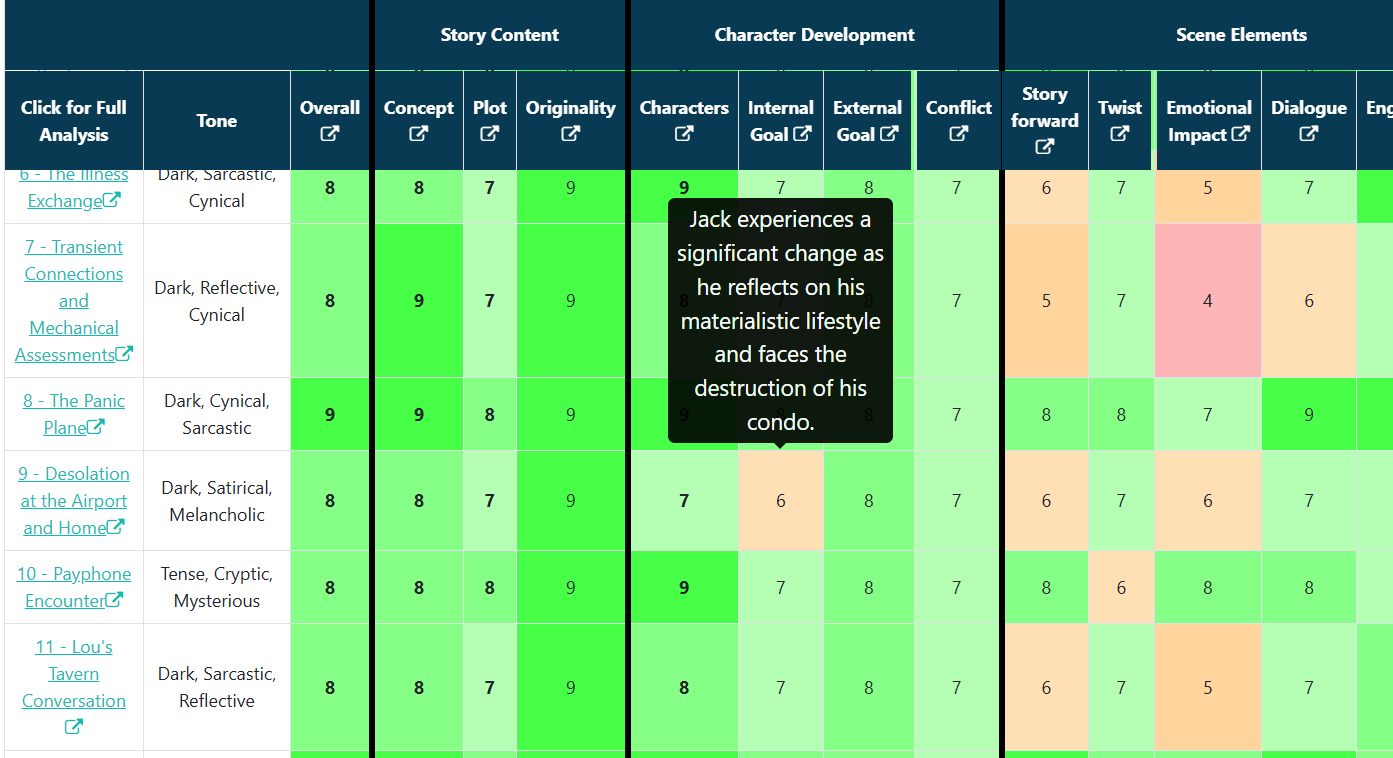
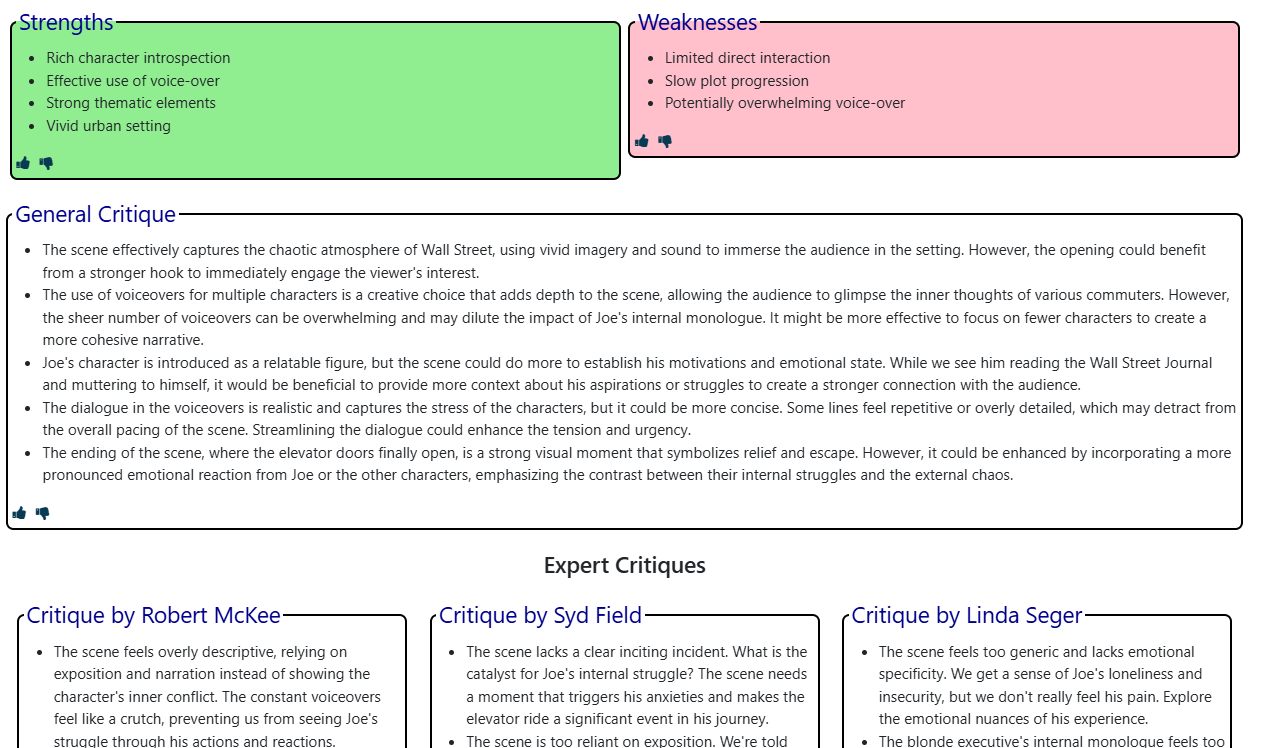
What are your weakest/strongest skills?
Is it conflict? Originality? Are you a conceptual writer and your concept and plot are amazing but characters and dialogue lame? We compare all criteria to the scripts in our vault and you see what percentile you fall in.
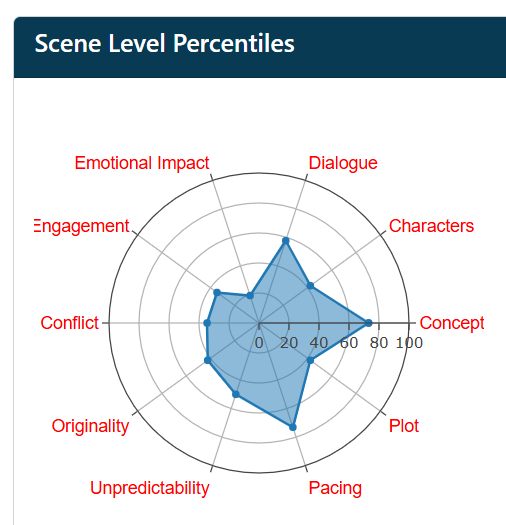
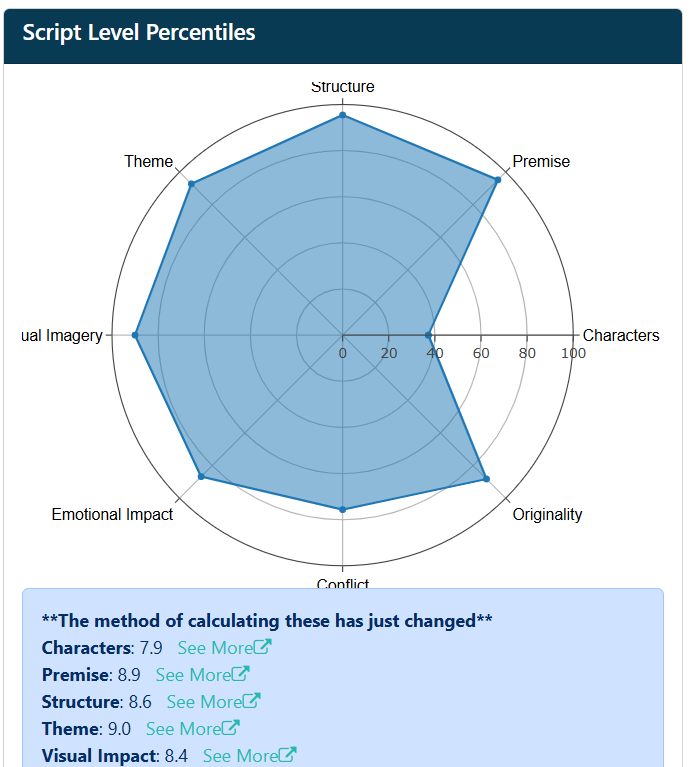
What emotional journey have you created?
.
Check out Coco's Analysis and scroll down to see it in action.
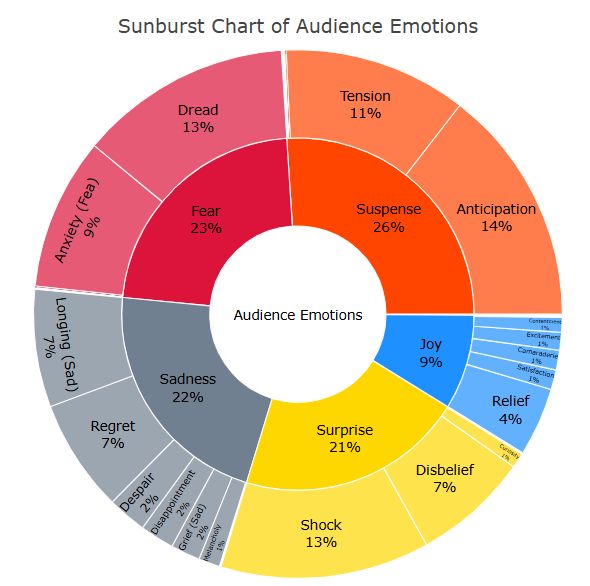
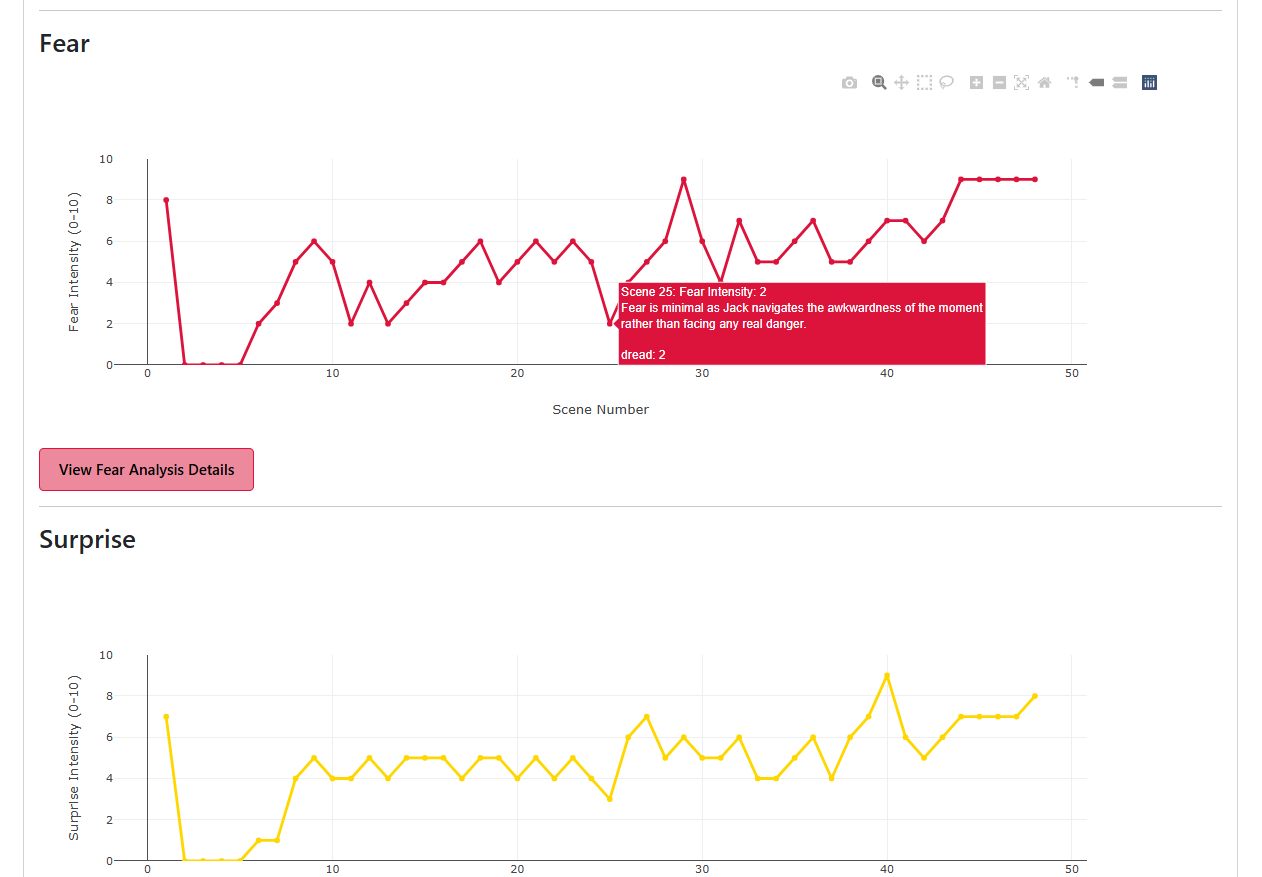
Hear From Experts...
Industry veterans tell their success stories with ScriptReader.ai
Upload Your Script View features"If you can't make your script at least 30% better with ScriptReader.ai, you're not doing your job as a writer. In bang for the buck, there's nothing even close."
"Script AI is a brilliant use of AI for script writing. It's a terrific resource for script writers, and for those who have to evaluate scripts."
